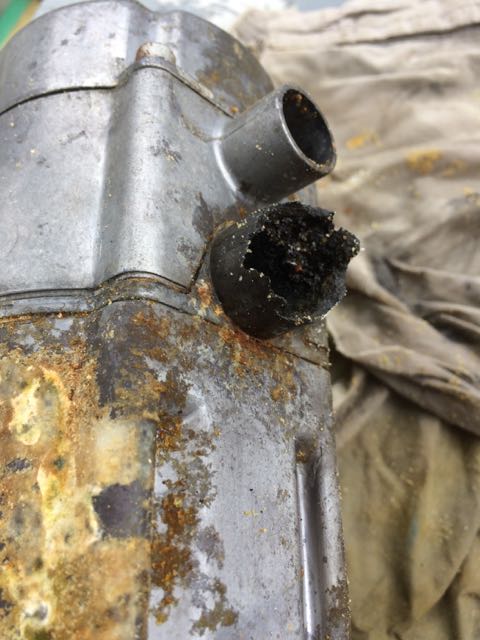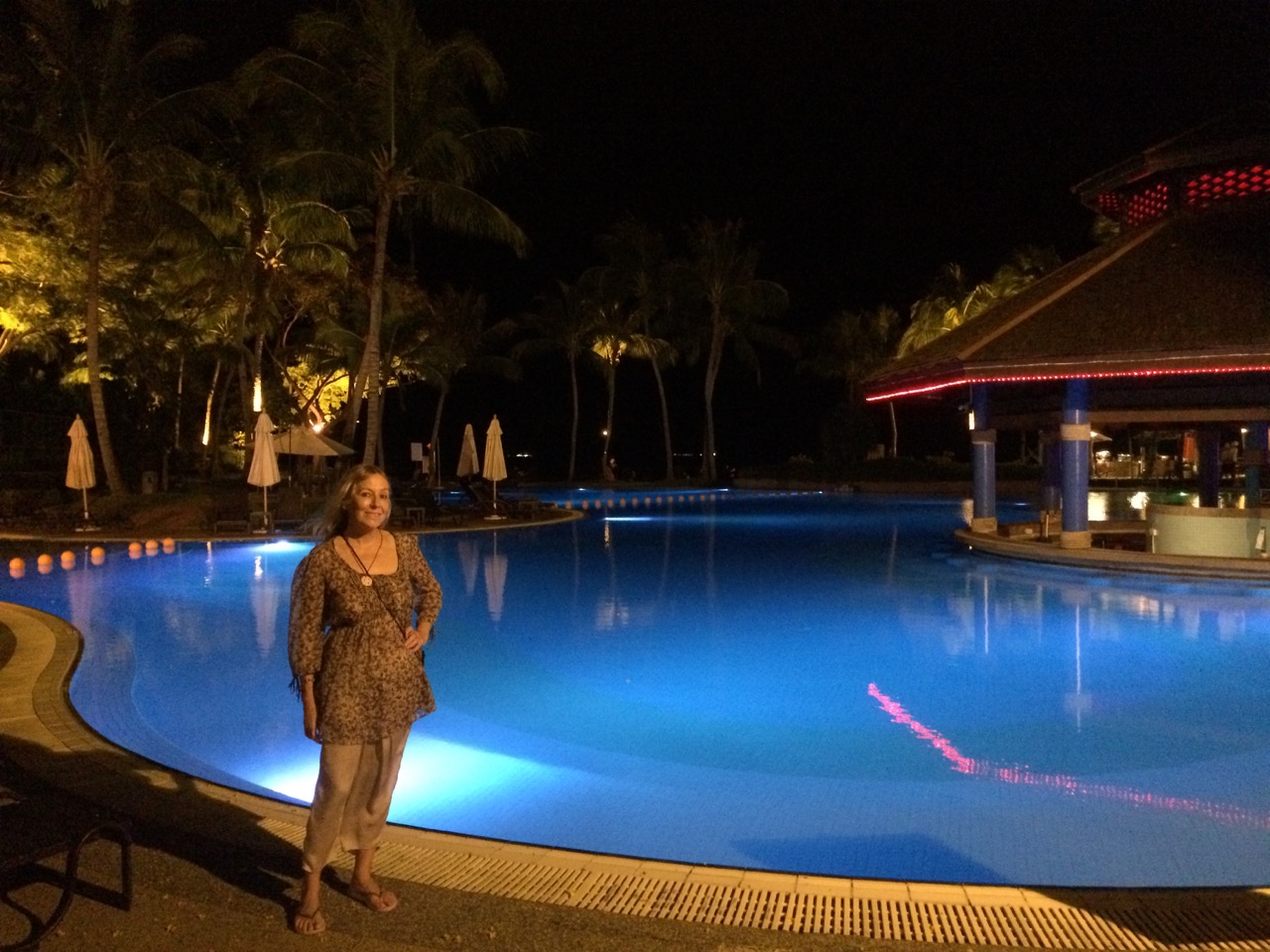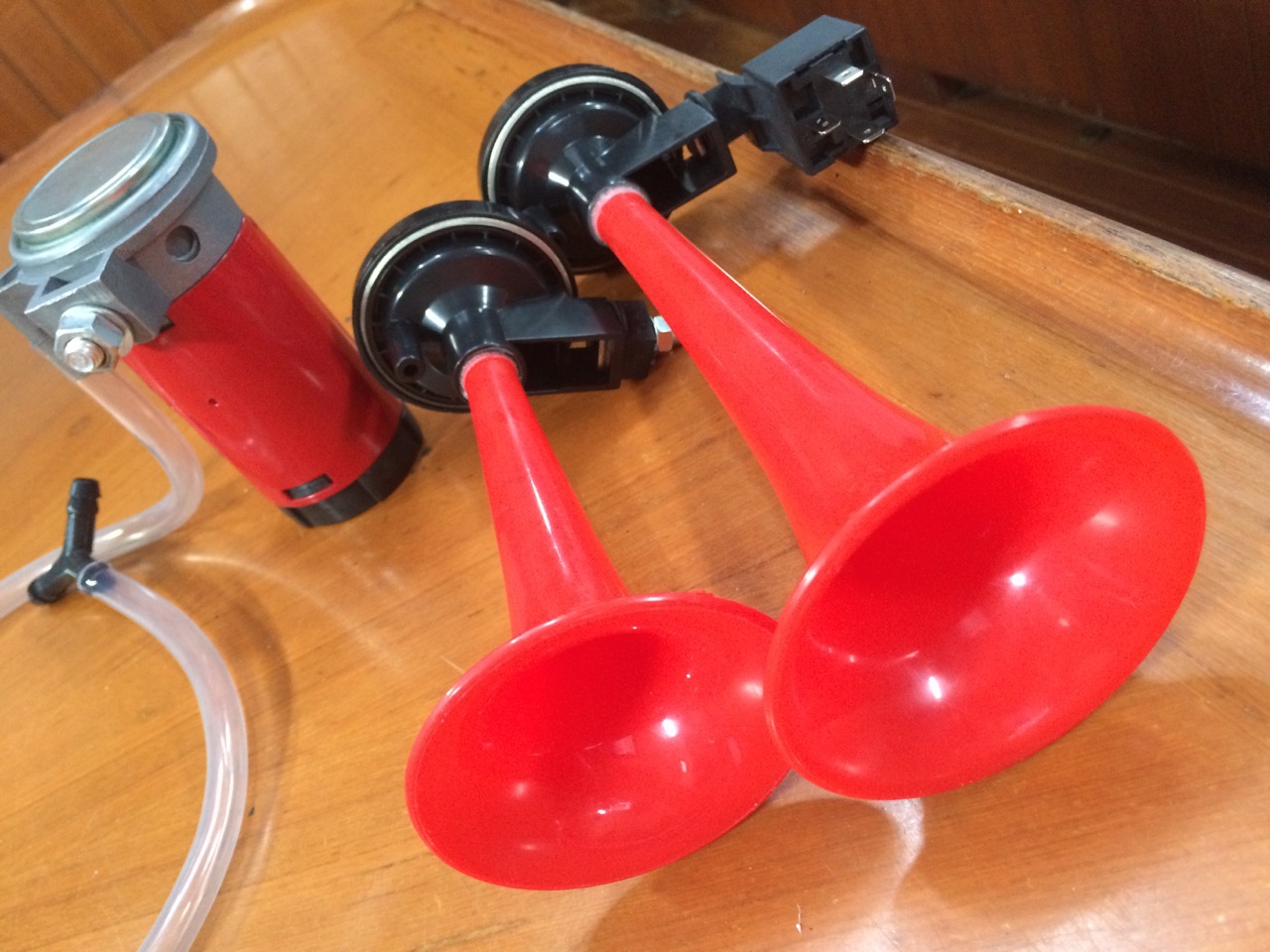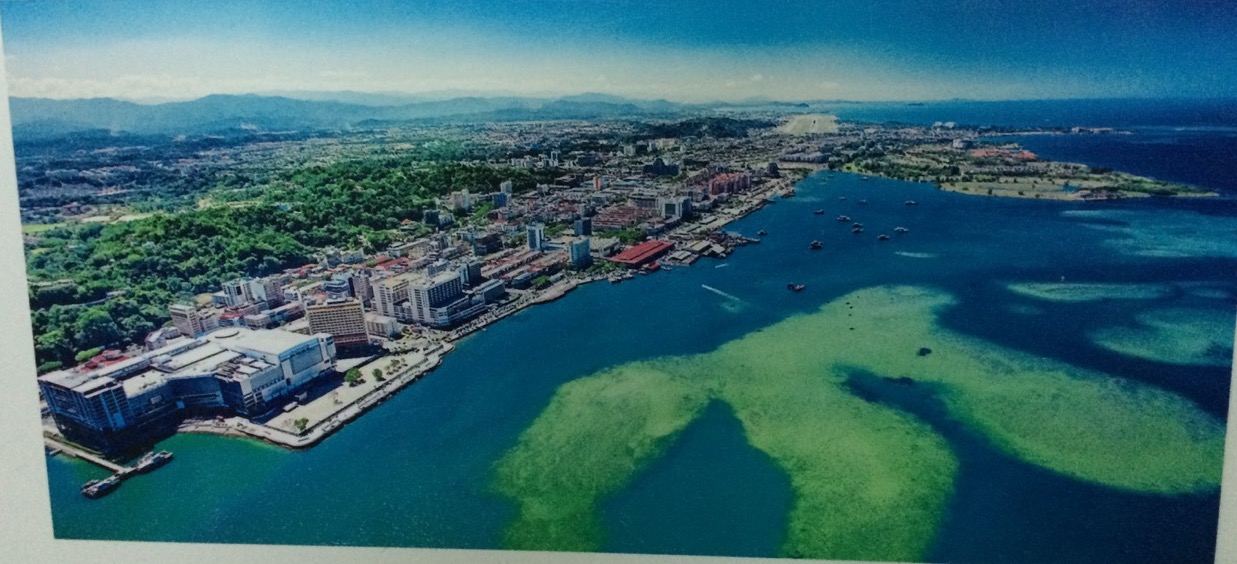I’m currently anchored off Pulau Tiga, half way between Kota Kinabalu, the capital of the Malaysian state of Sabah, and Pulau Labuan, the duty free island state just offshore from Brunei after a glorious days sailing.
First I had two nights in KK in the luxurious setting of the Sutera harbour marina.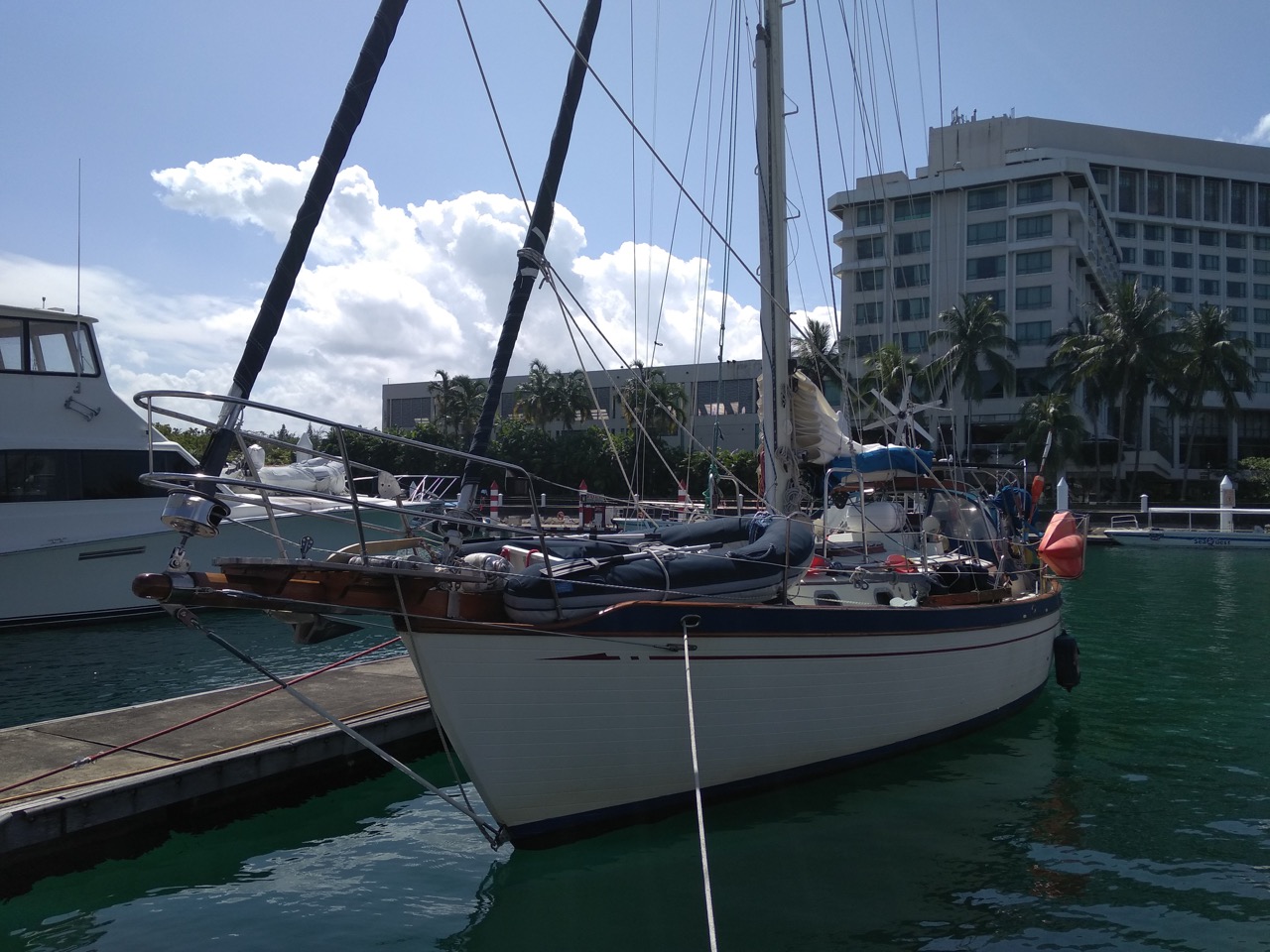
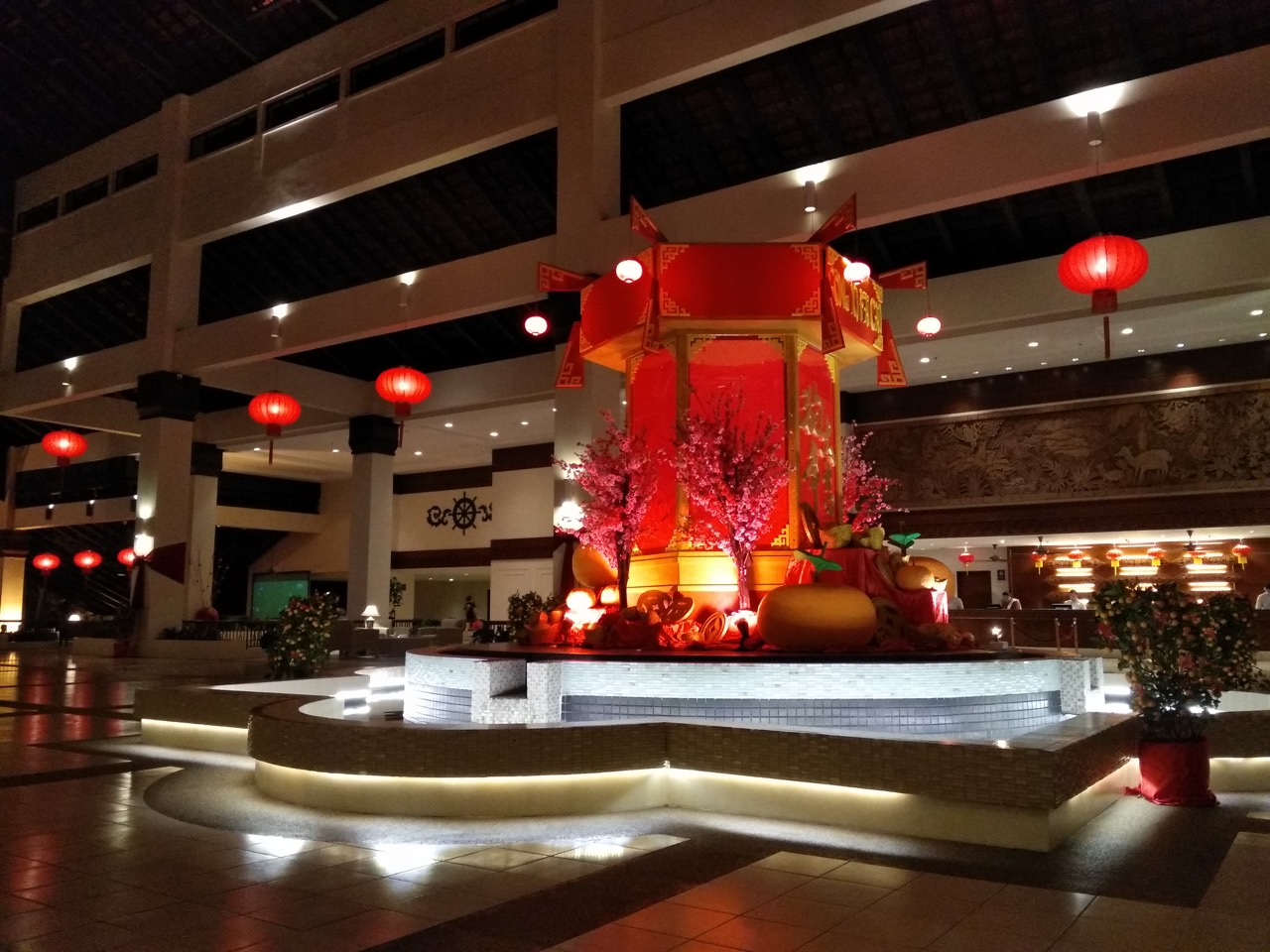
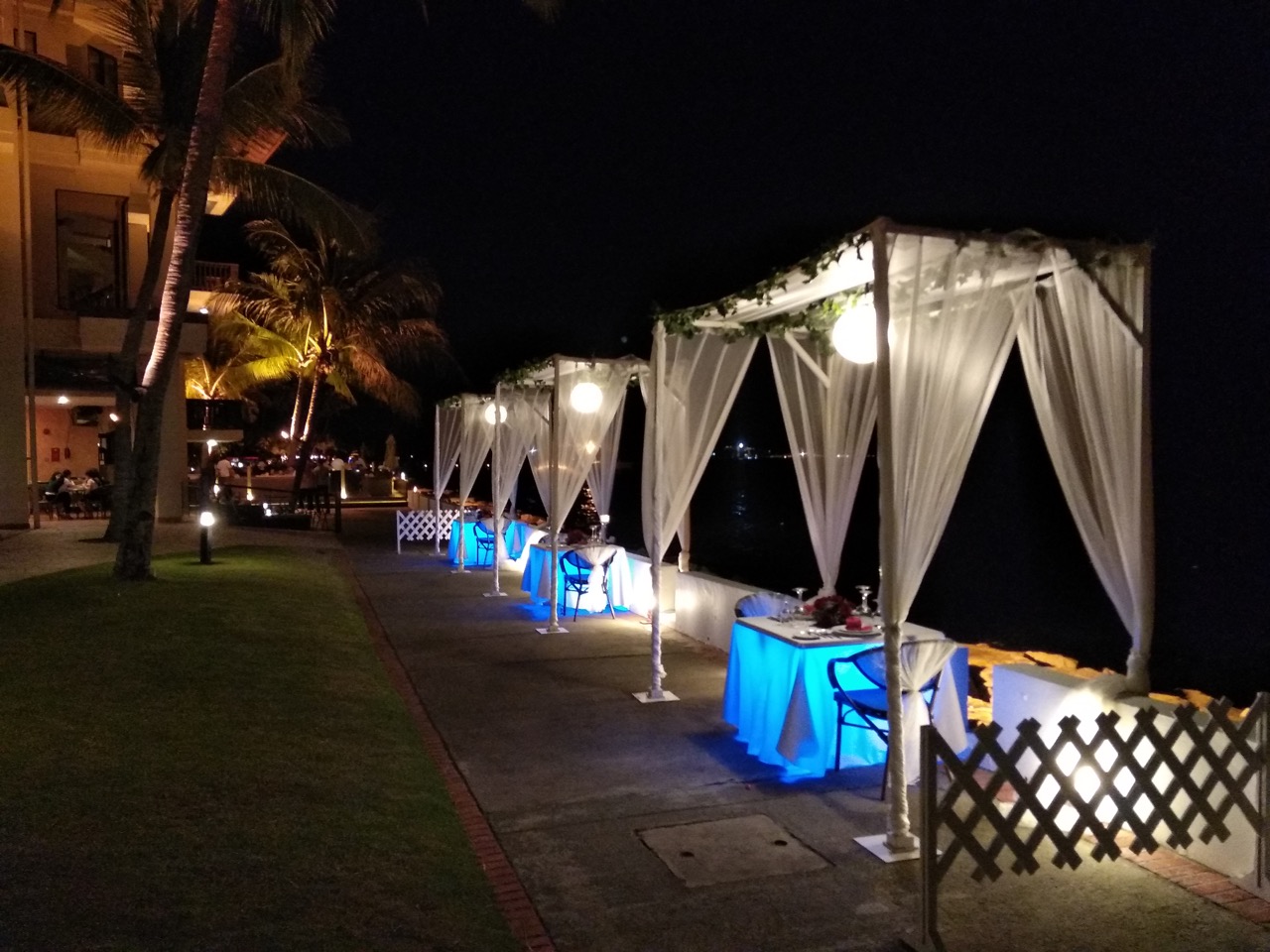
Yesterday I popped into town and picked up groceries, finally got some nice tomatoes and fresh lettuce, as usual, the Imago mall had put up a big display for the Chinese New Year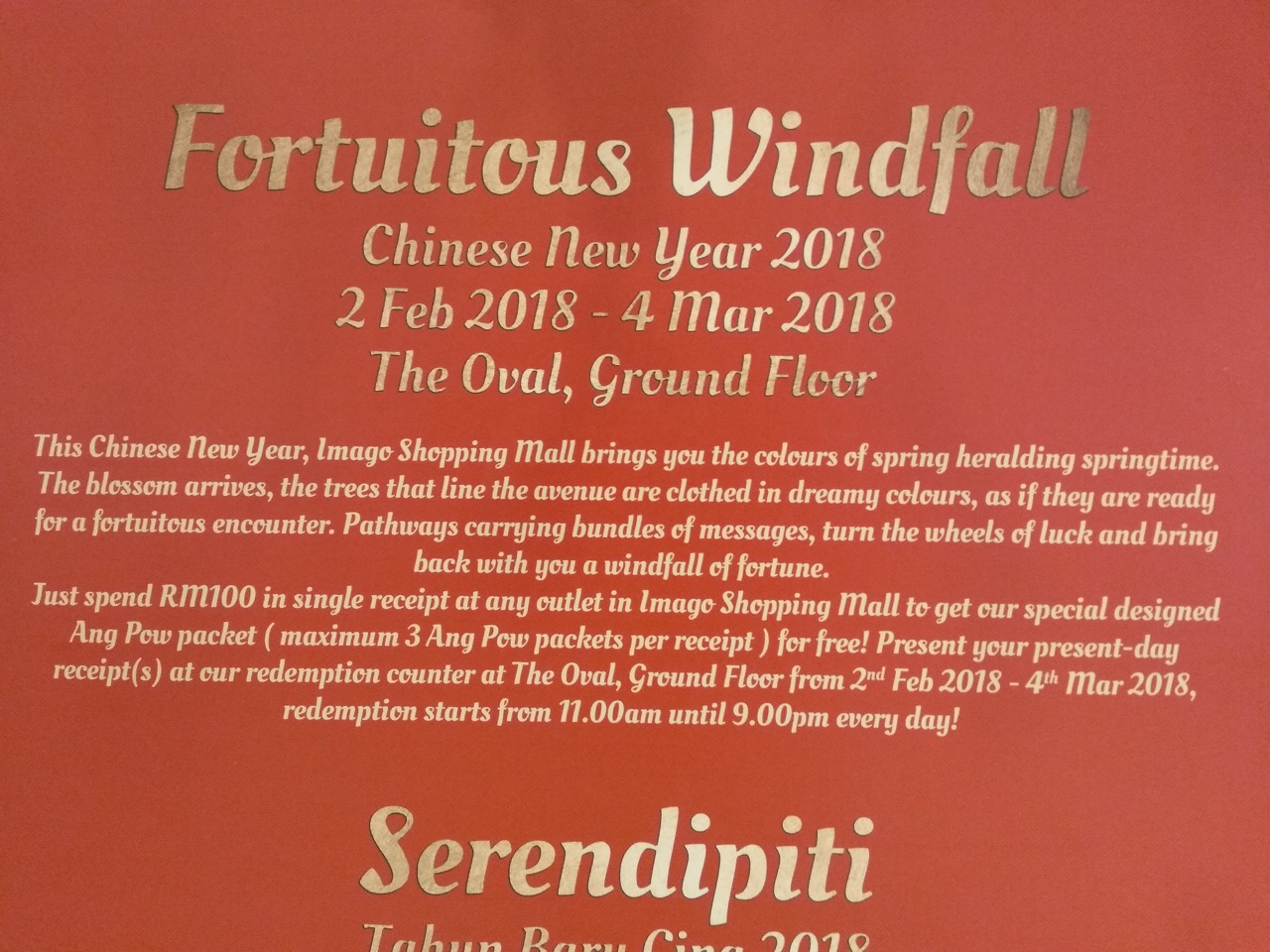
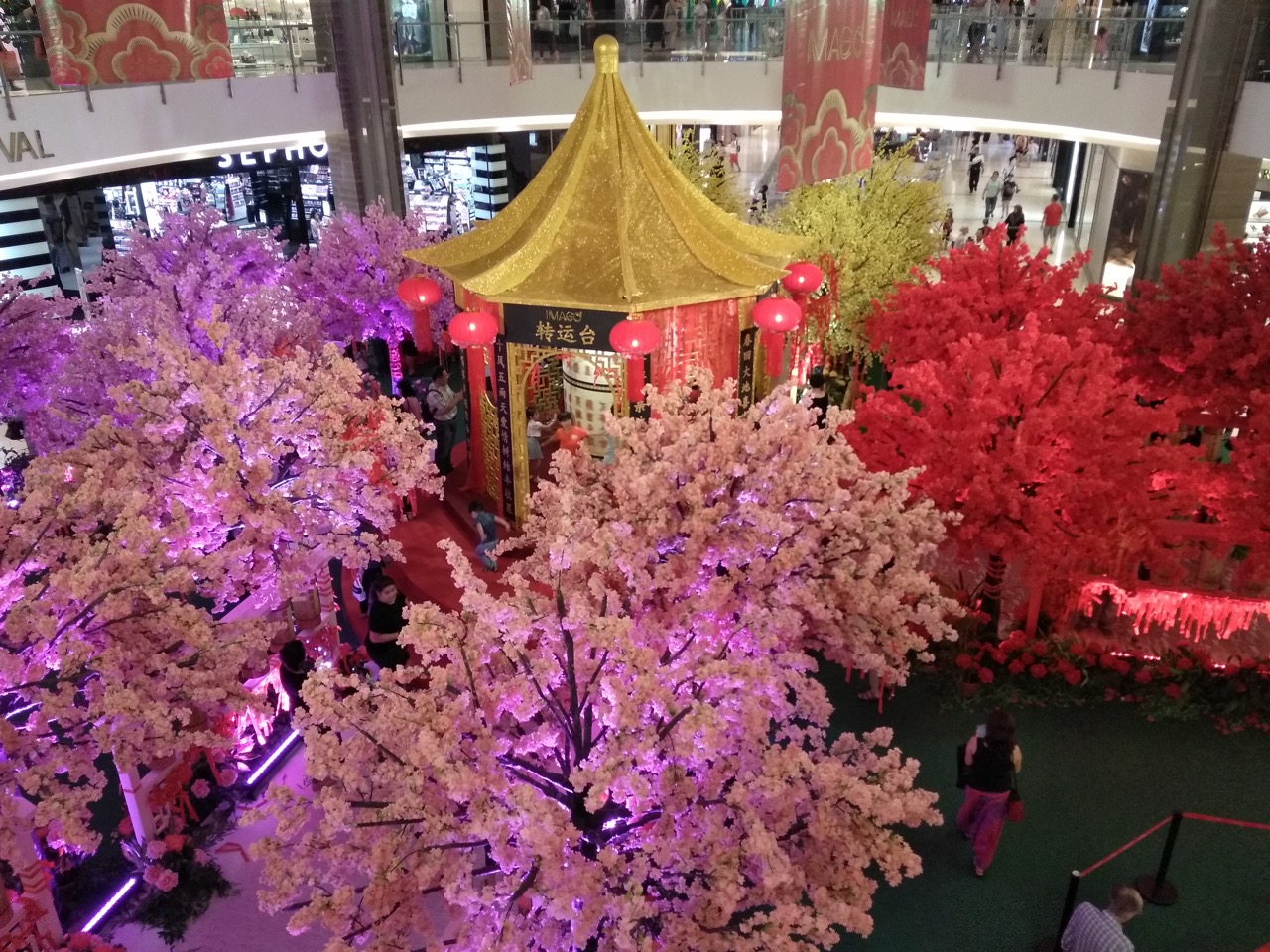
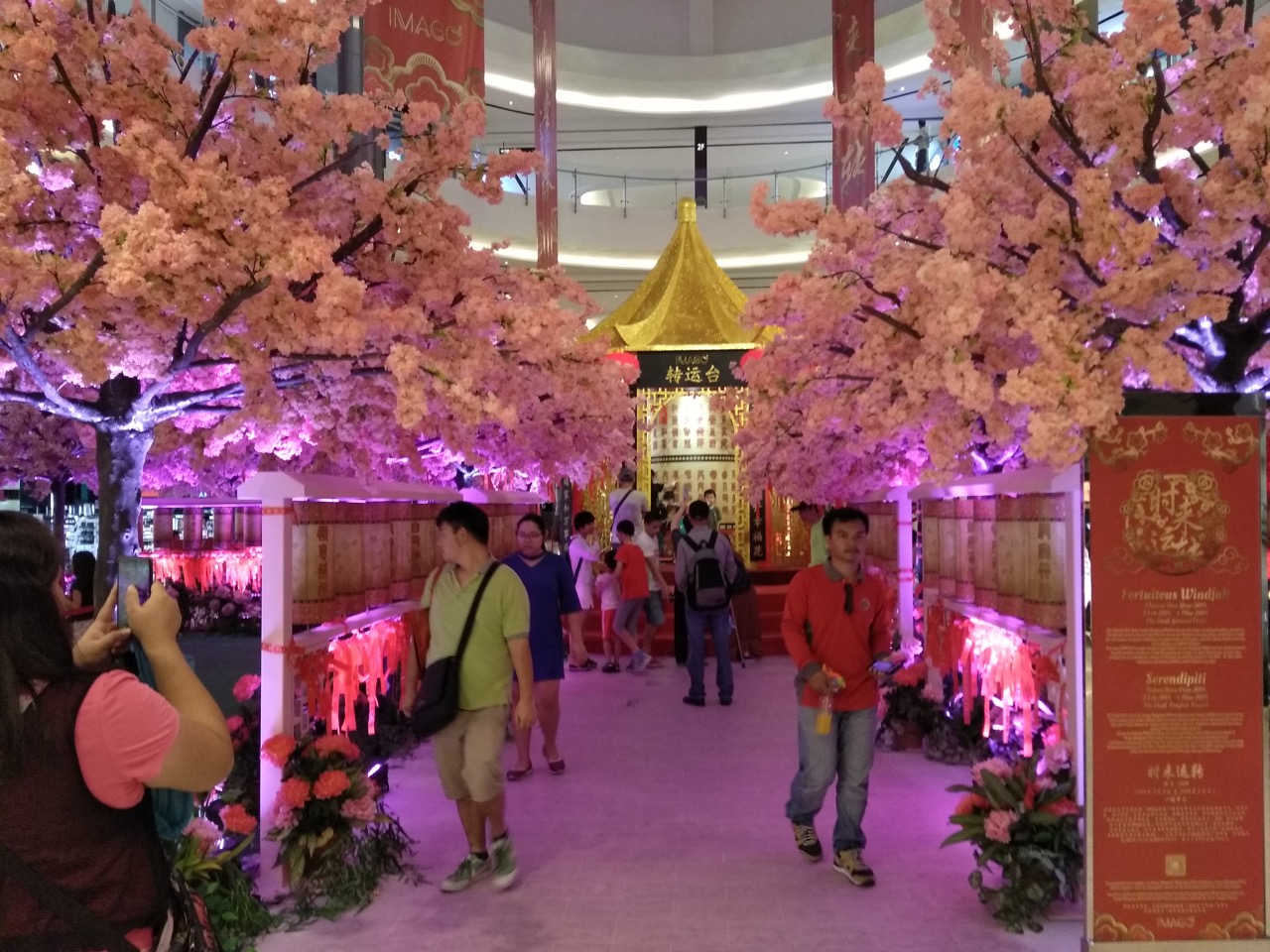
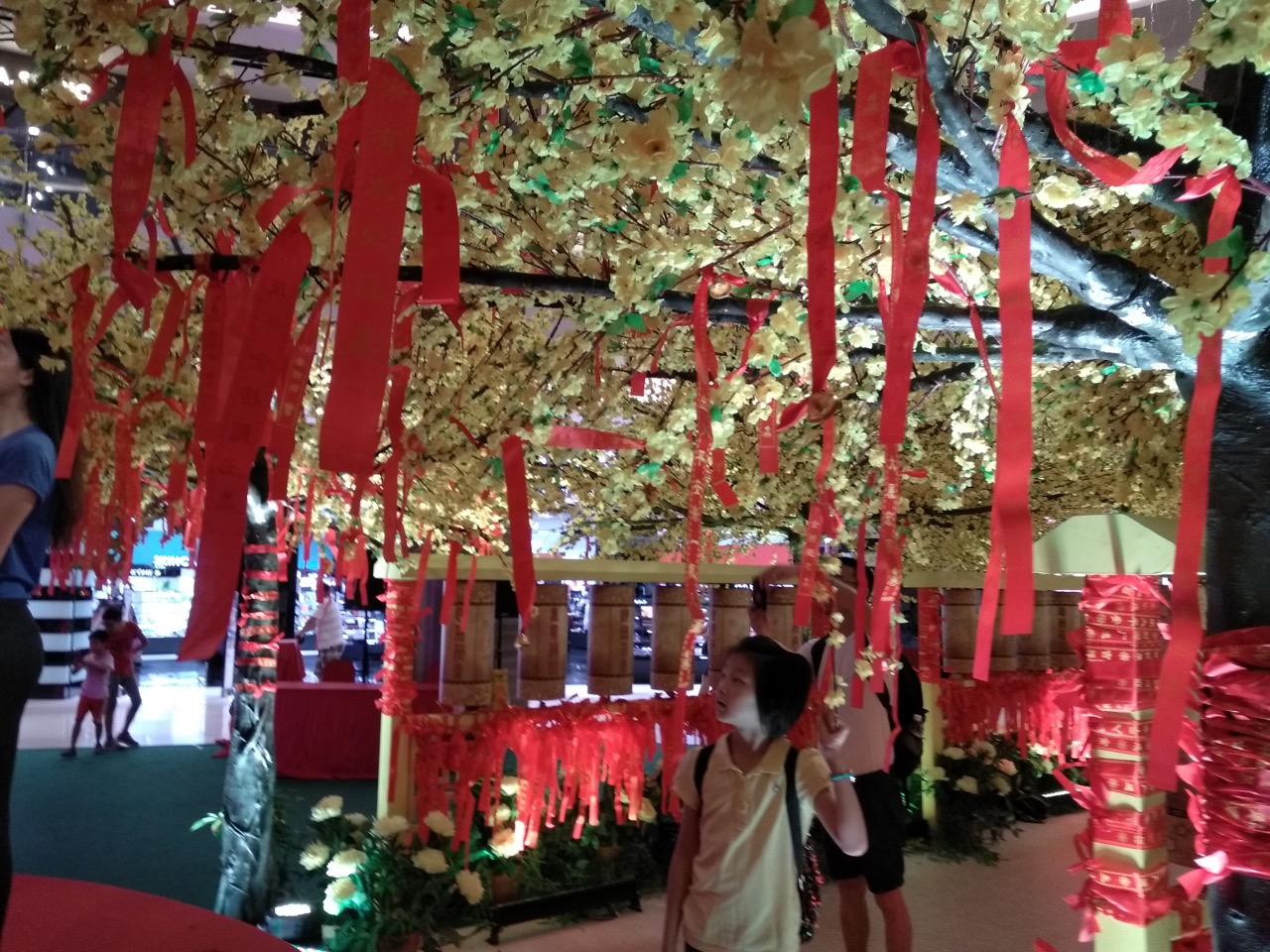
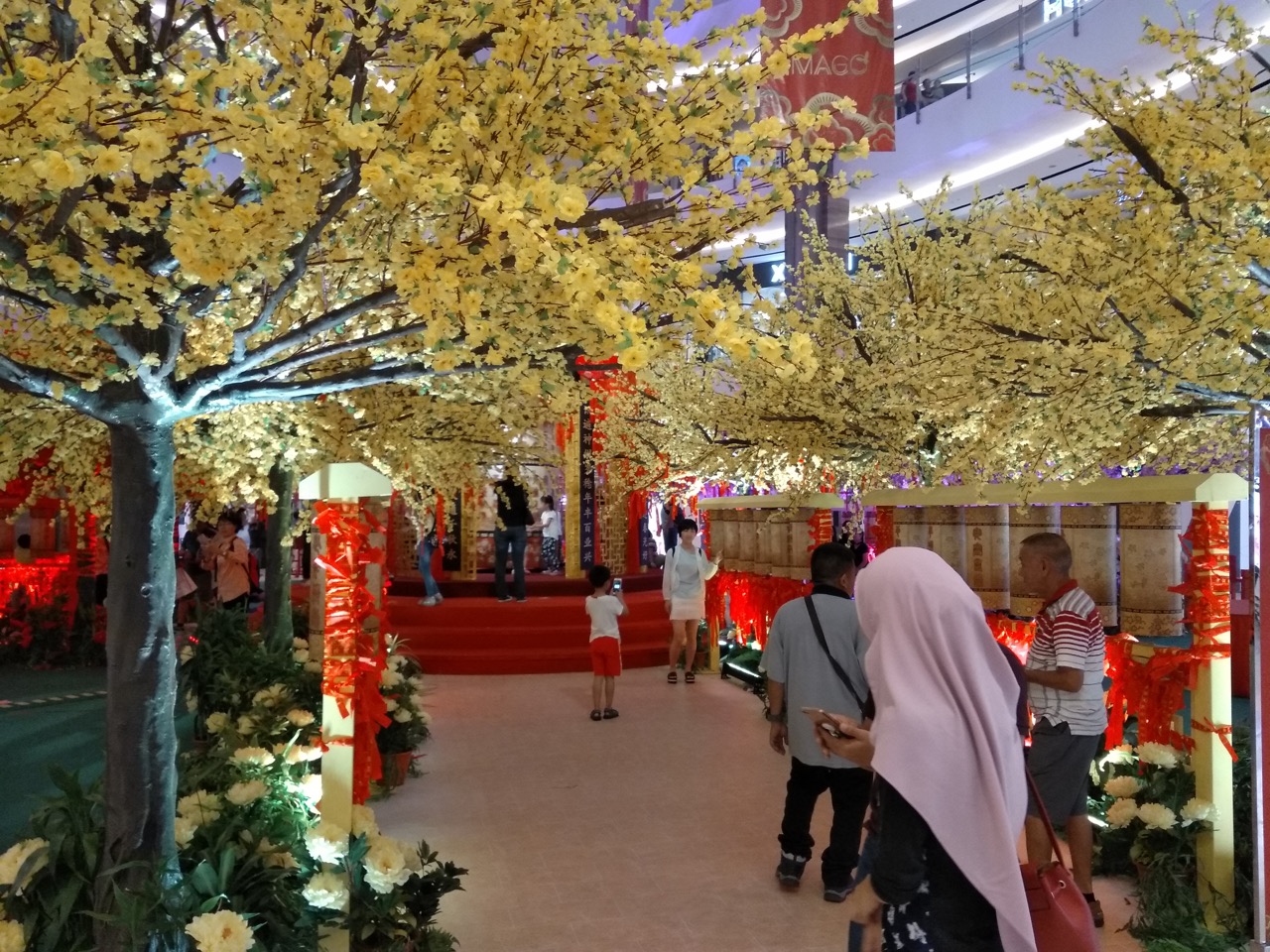
Can you spot the lucky charms on the shelf below, It wasn’t that long ago that the colonising Brits insisted the indigenous tribes cut down on the old skull collecting thing.
Pulau Tiga, (AKA Survivor Island)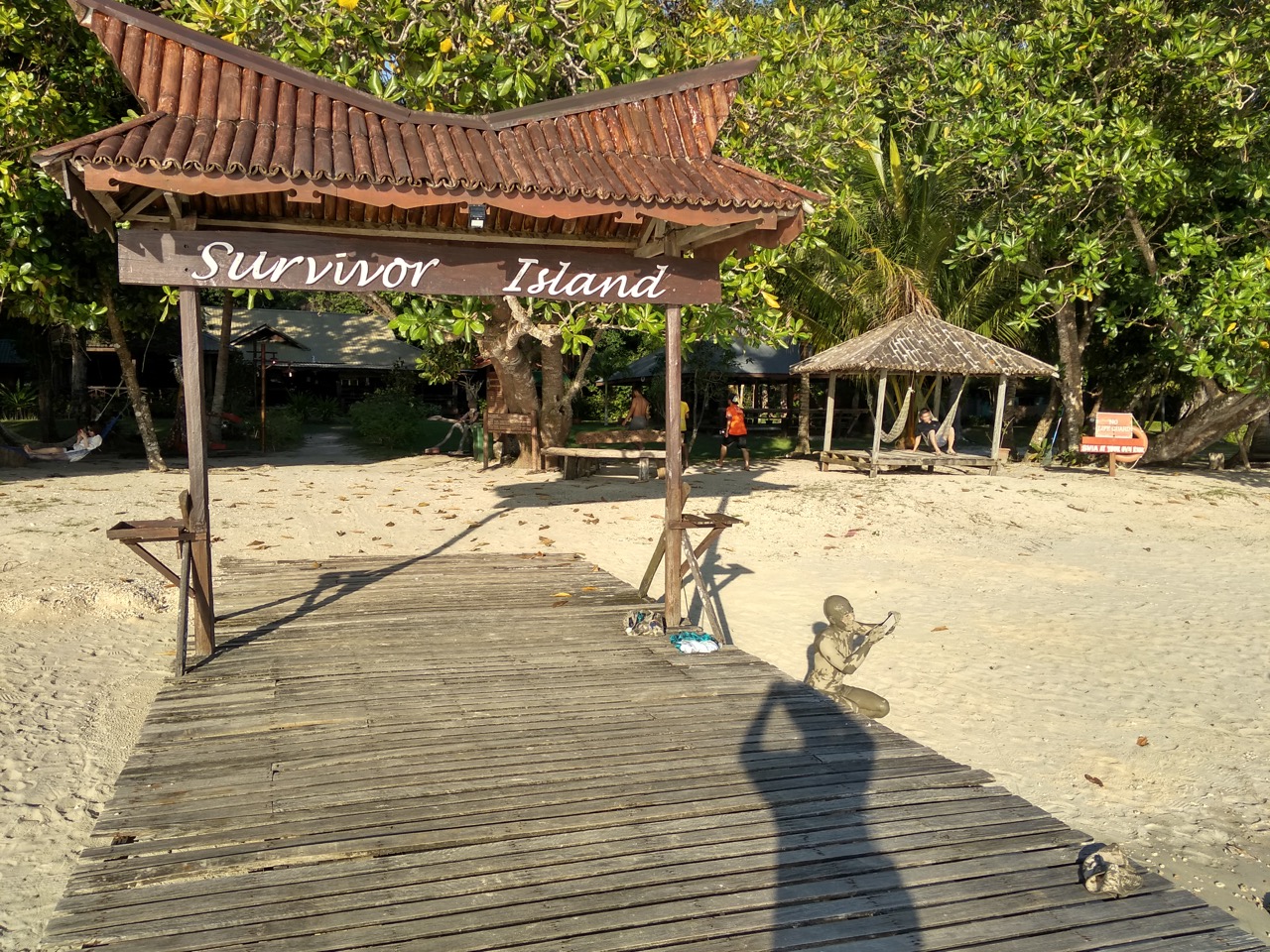
Early morning, 9AM and I’m all set to leave the marina, I had to wait for the office to open to pay the bill. It was a gorgeous day with just a light breeze and a very calm sea. The marina only charged me for one day, even though I had been there two nights. Very generous of them, I will be back.
I motored effortlessly out of the marina into the sea, and immediately realised there was enough wind from the right direction to sail, so up went the Main and both headsails, off went the engine and we were away. I started off close hauled, then as I passed around the back of Manakuan Island I turned to the south and let out more sail until I was on a reach. On went the Monitor self steering and I settled down to a 4 hour passage to P. Tiga. The sea remained very flat but the wind varied between 5 and 10 knots, however we spent most of the time making between 5 and 7 knots, helped along by a bit of current heading south. There is a buoy at the bottom of Tiga, it’s an easterly cardinal, meaning to keep east of it, It’s a long way off the island and marks a big underwater spit that travels out, I figured I could cut the corner a bit, one chart had 20 mtrs of water there, the other only 1.8, but that was an old chart. As I approached in 28 mtrs of water I was quite shocked to see it go from 28 down to 4 metres in less than 10 seconds, at this point I went to kill the revs only to remember the engine hadn’t been on for many hours, and the sudden realisation it’s not so easy to kill speed under sail, I hung a big left, risking a jibe, away from the shallow and quickly saw the depth rise. Back on course and I was then able to beat up the leeward ( in the winds shadow) side of the island and find a nice anchorage. This was one of the few times I had sailed the boat in a decent wind but a flat sea, it was very pleasant. I have put a little vid of the conditions on below.
Also I was able to measure the tacking ability easier, and I programmed a tack into the autopilot to take me through exactly 90 deg, which turned out to be pretty close to the limit of the current sail / rig setup. This means I can only sail 45 degrees into the wind when trying to head upwind. I would hope to get closer to 35 deg, and can fine tune this, one of the problems I can see is that the headstay is not very tight and I need to see what I can do about this.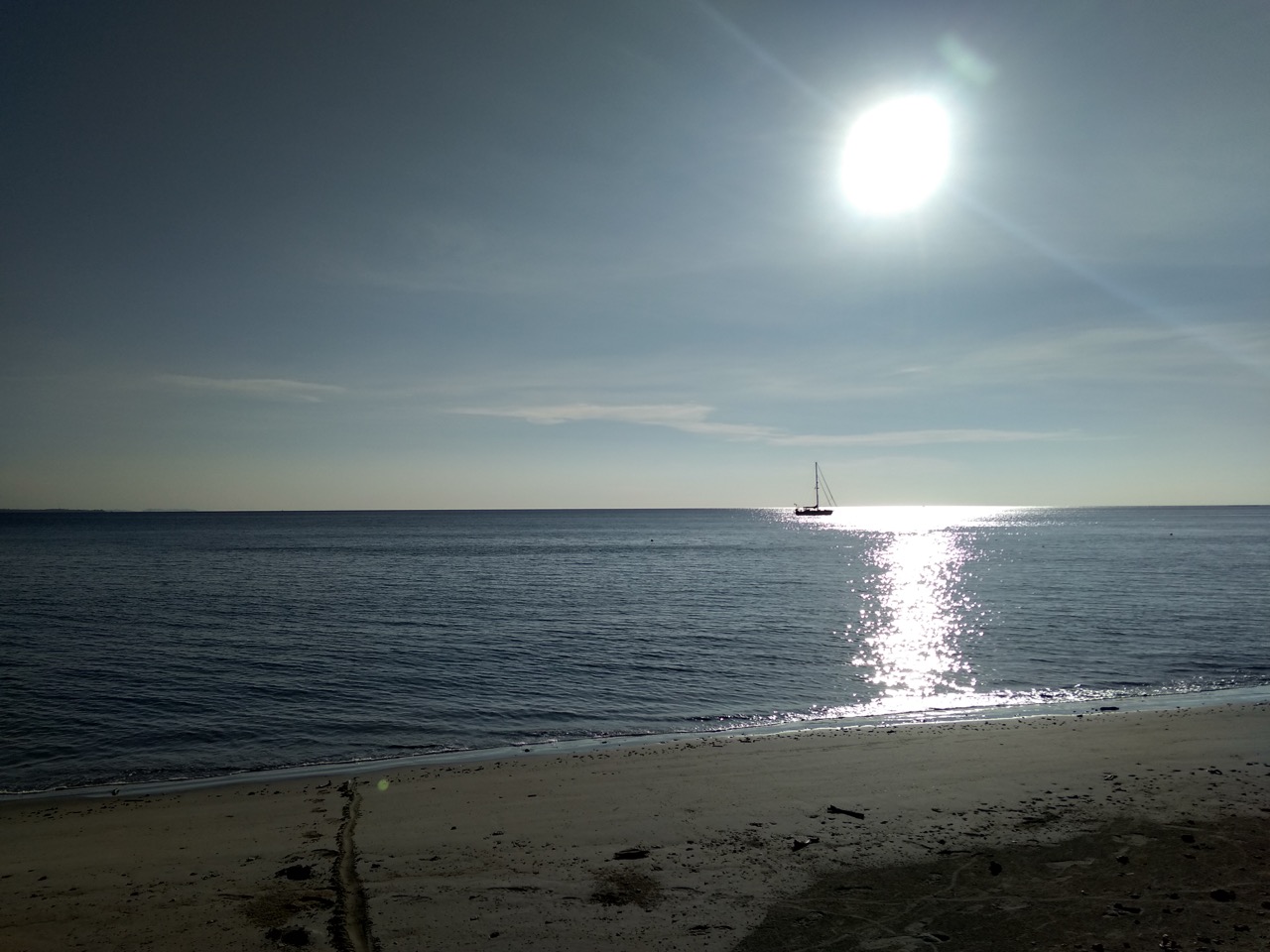
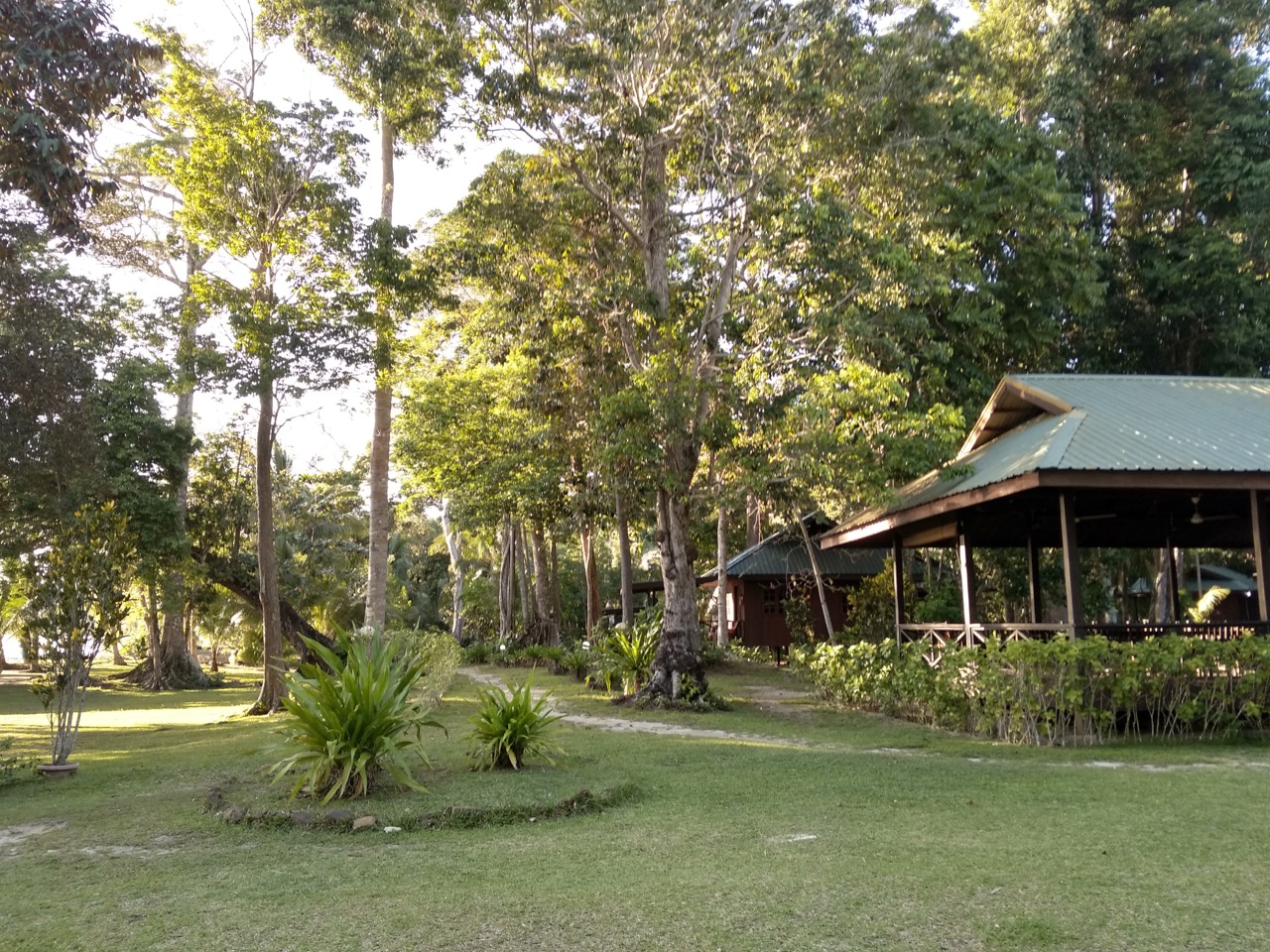
Pulau Tiga was the setting for the TV Reality series Survivor island, Kathy mentioned this when we took shelter here a few weeks back, but didn’t go ashore. This time it’s so calm and sunny here I was able to launch the Kayak and have a little wander. First off I paddled over to the nw edge where the beaches were full of monkeys, shy ones who disappeared into the trees as I approached, the island is full of lovely beaches everywhere, at the first resort I spotted the monitor lizard below, and while snapping this a bigger shock appeared from the trees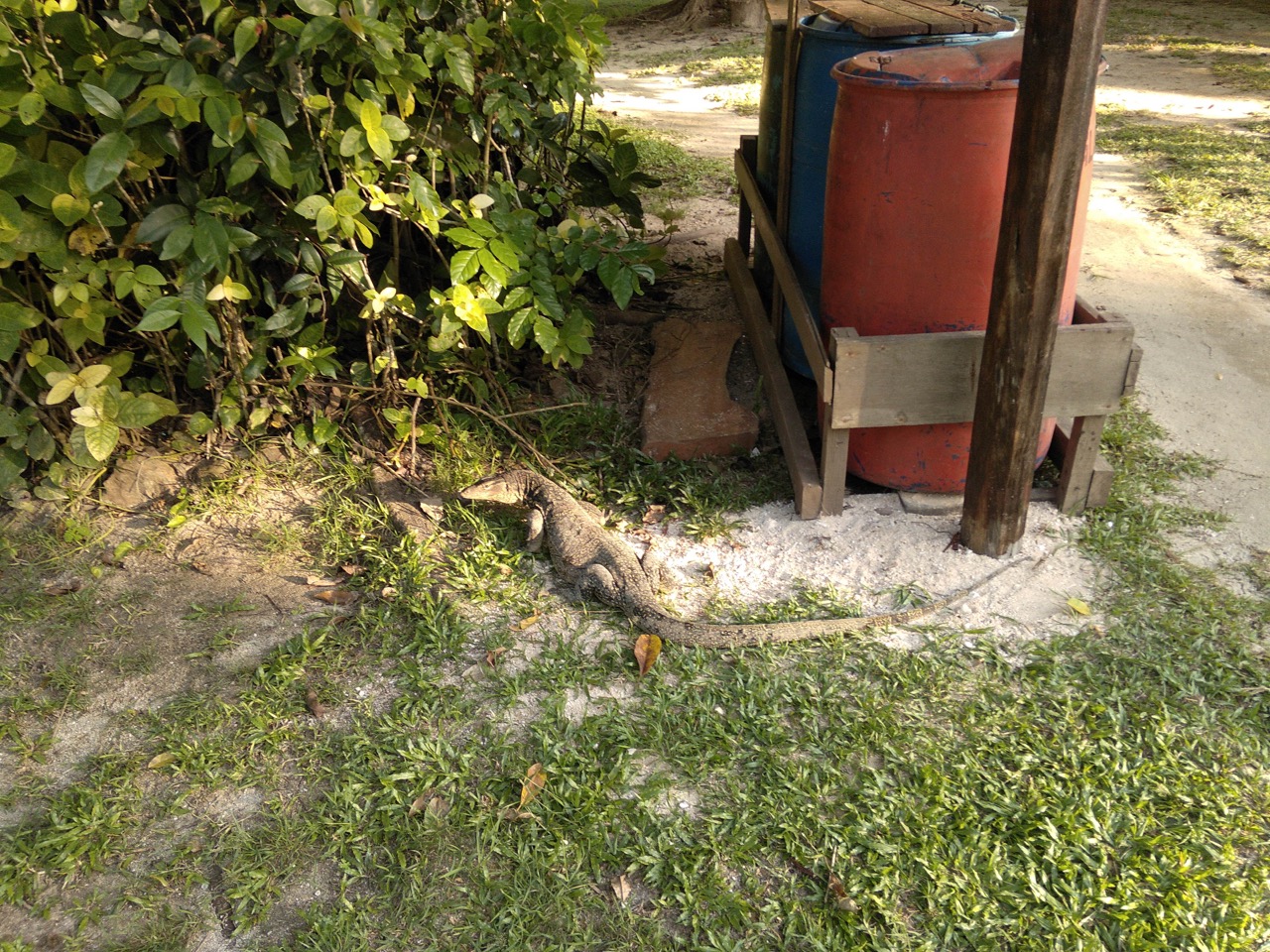
A Zombie! not really, but a mud volcano monster. At first I wondered what the heck… I thought this person has some serious skin issues, and tried not to stare, then I remembered the ‘mud volcano experience’ that the island is famous for.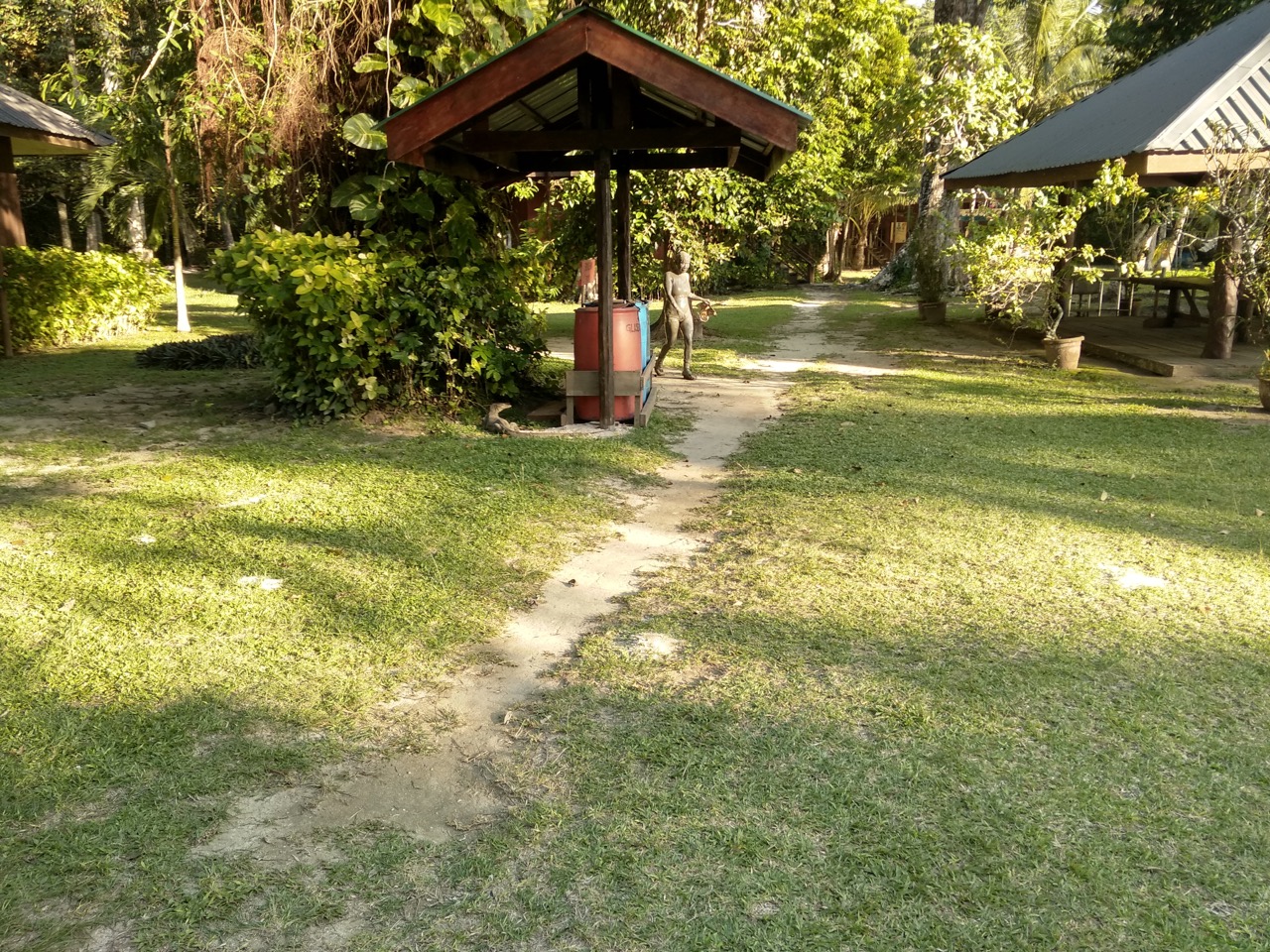
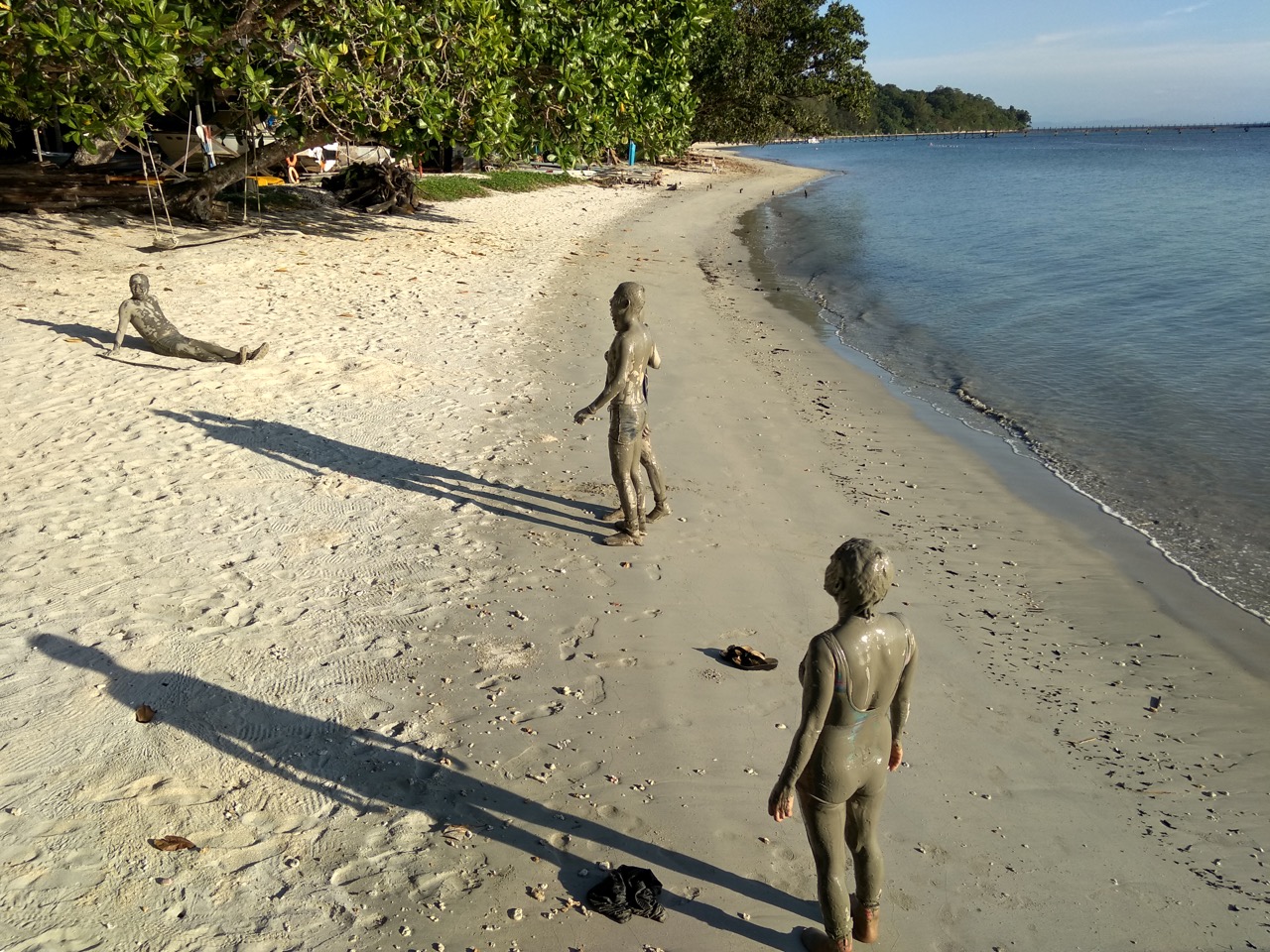 More of the monsters appeared, heading for the sea, quite surreal, they posed for selfies, then entered the sea, only to return as near humans. Apparently they will look younger and live longer now, somehow I don’t think this has been through a very thorough peer review process. But it’s cheaper than buying ‘No 7’ or whatever the current trend is.
More of the monsters appeared, heading for the sea, quite surreal, they posed for selfies, then entered the sea, only to return as near humans. Apparently they will look younger and live longer now, somehow I don’t think this has been through a very thorough peer review process. But it’s cheaper than buying ‘No 7’ or whatever the current trend is.
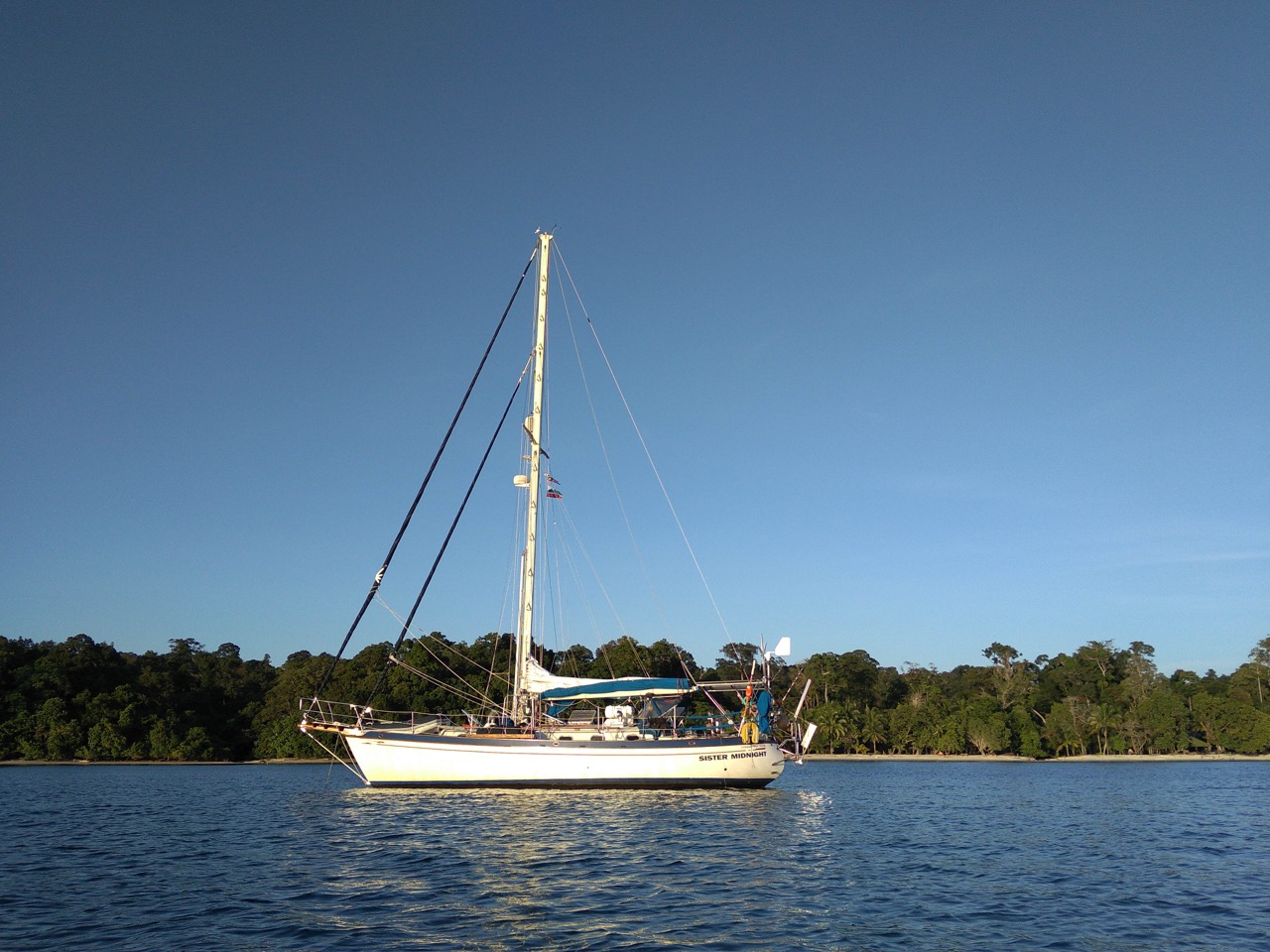
I took these pictures with the new android phone, and I do like the phone, the big screen is much nicer than I imagined, and all the apps work just the same as on my iphone, however the camera sucks. I hadn’t appreciated how much I take for granted on the iPhone, there’s loads of shake on this one, not sure if that’s due to exposure time, or lack of stabilising software, also it cant handle bright lights, or low light. The display is rubbish in bright sunlight, so bad that the 2 minutes of footage of the monkeys I shot turned out to consist of my ugly mug staring at the phone trying to see what I was filming, without realising the camera was on me! SO now I don’t know what to do, it’s nice being able to take pictures from the Kayak without worrying about damaging the phone, for £90 I can risk it, but I do miss the quality of the iPhone.
It’s now tomorrow, I couldn’t get internet last night to upload this, and it’s very calm, I will explore the island more and stop another night.
Just as a footnote, not everything is perfect in paradise, I have a little hole in my finger where I burnt the skin off melting the end of some plastic rope I was seizing, then I followed that with a broken toe. At least I suspect it’s broken or very badly bruised. I had left one of my Yankee sheets (ropes) lying in the cockpit sole, normally I’m more tidy, and I jumped down onto the rope, and my foot landed on the big figure of eight knot in the end. The knot rolled, my toes curled under it, and my foot continued in one direction and the toe in question remained steadfast. It hurt like hell, I couldn’t walk much for a day, and it went a funny colour. If you’re reading this Kathy, and they find me dead on the boat from some deadly toe based infection, I want it clearly stated on my death certificate as cause of death to be ‘Death by Figure of eight knot’. However I think it’s healed enough for me to try one of the island walks later.
Paul Collister



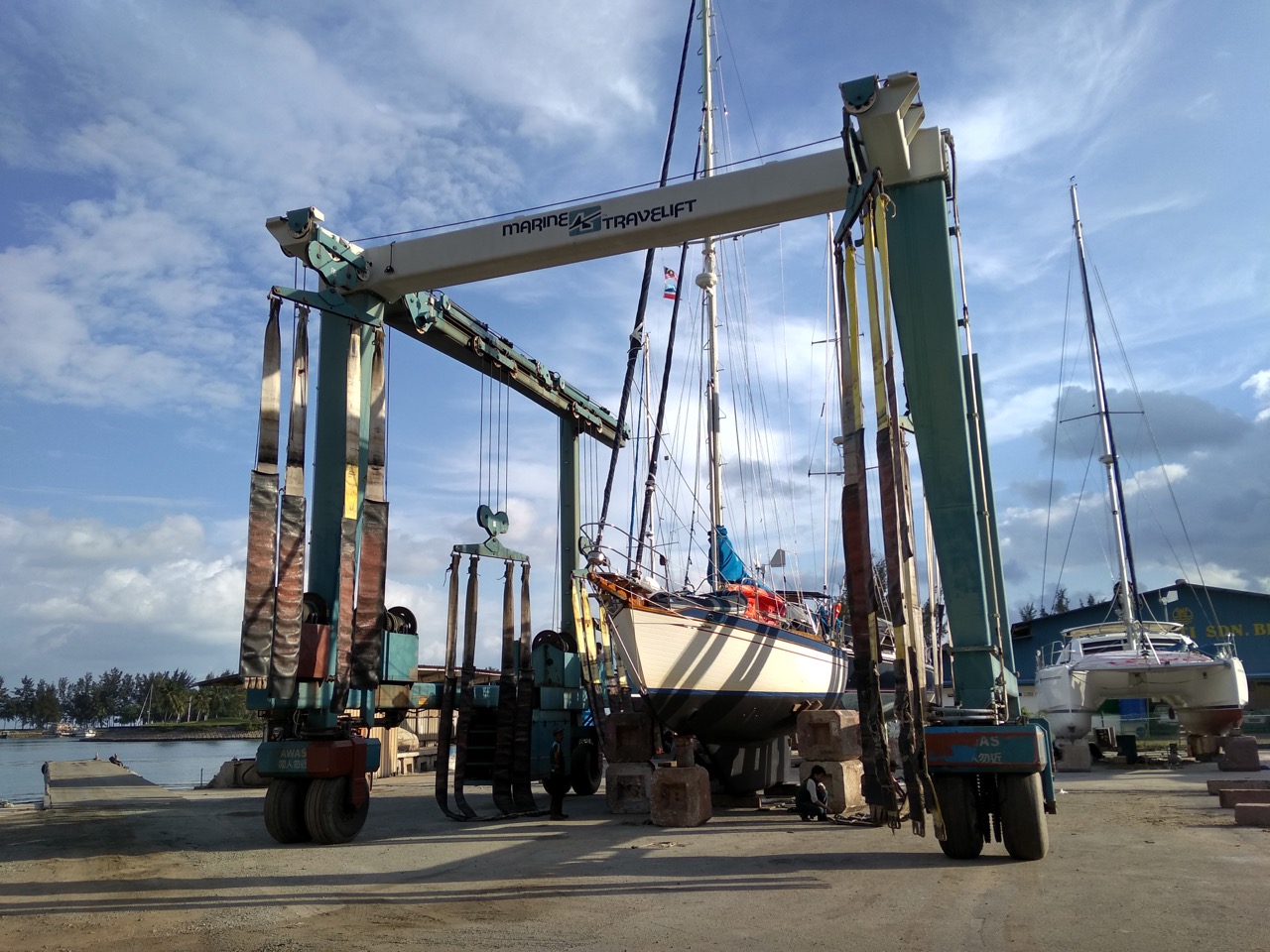 The travel lift arrived bang on time at 8AM, and I was in the water 20 minutes later, doing the old reversing the wrong way trick. still I missed all the hard concrete piles and got out just fine. I would have had a lot
The travel lift arrived bang on time at 8AM, and I was in the water 20 minutes later, doing the old reversing the wrong way trick. still I missed all the hard concrete piles and got out just fine. I would have had a lot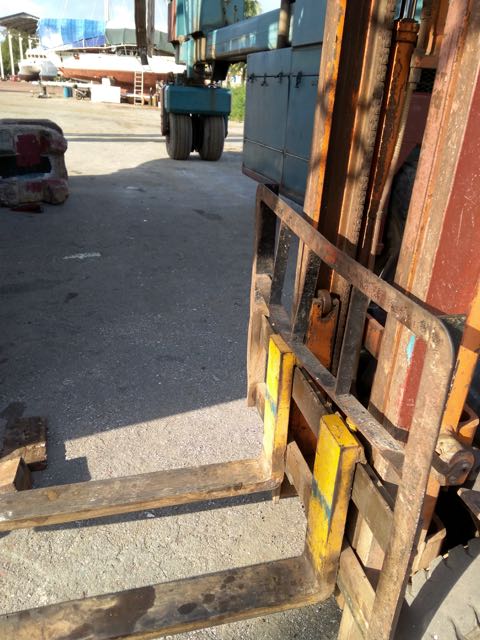
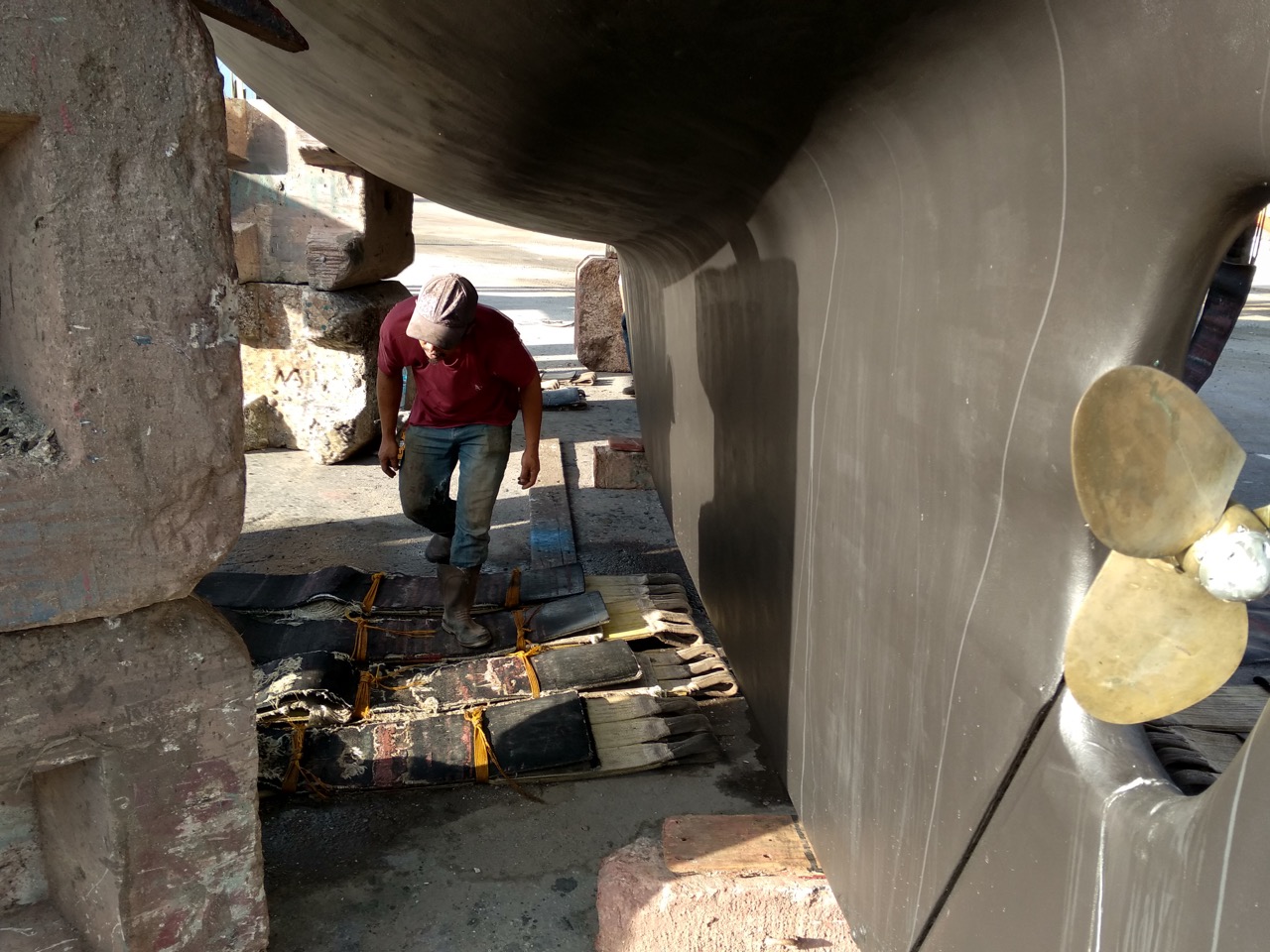 they are joined together by pushing steel rods through the hoops at the end. Human ingenuity never ceases to delight me.
they are joined together by pushing steel rods through the hoops at the end. Human ingenuity never ceases to delight me.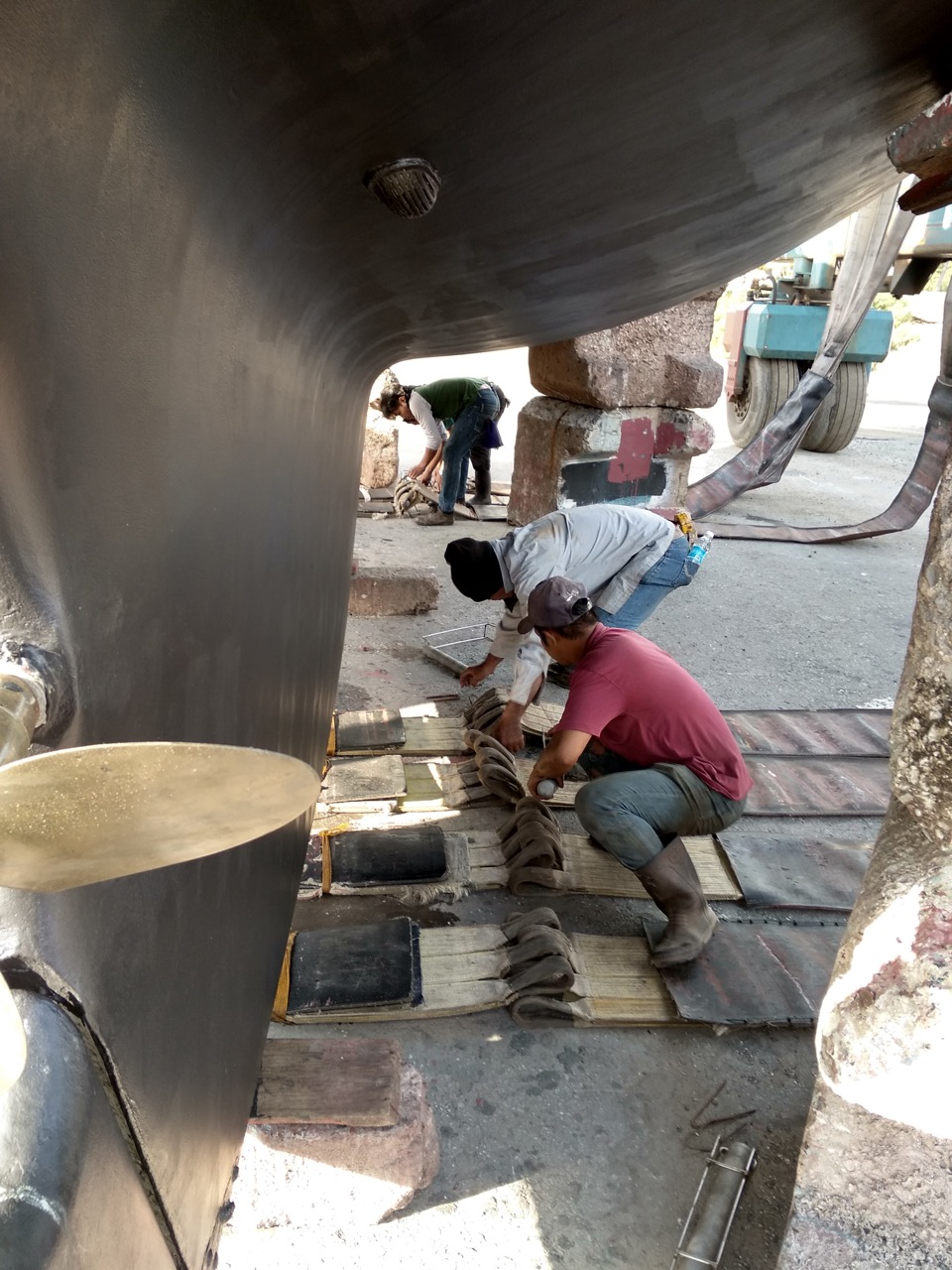

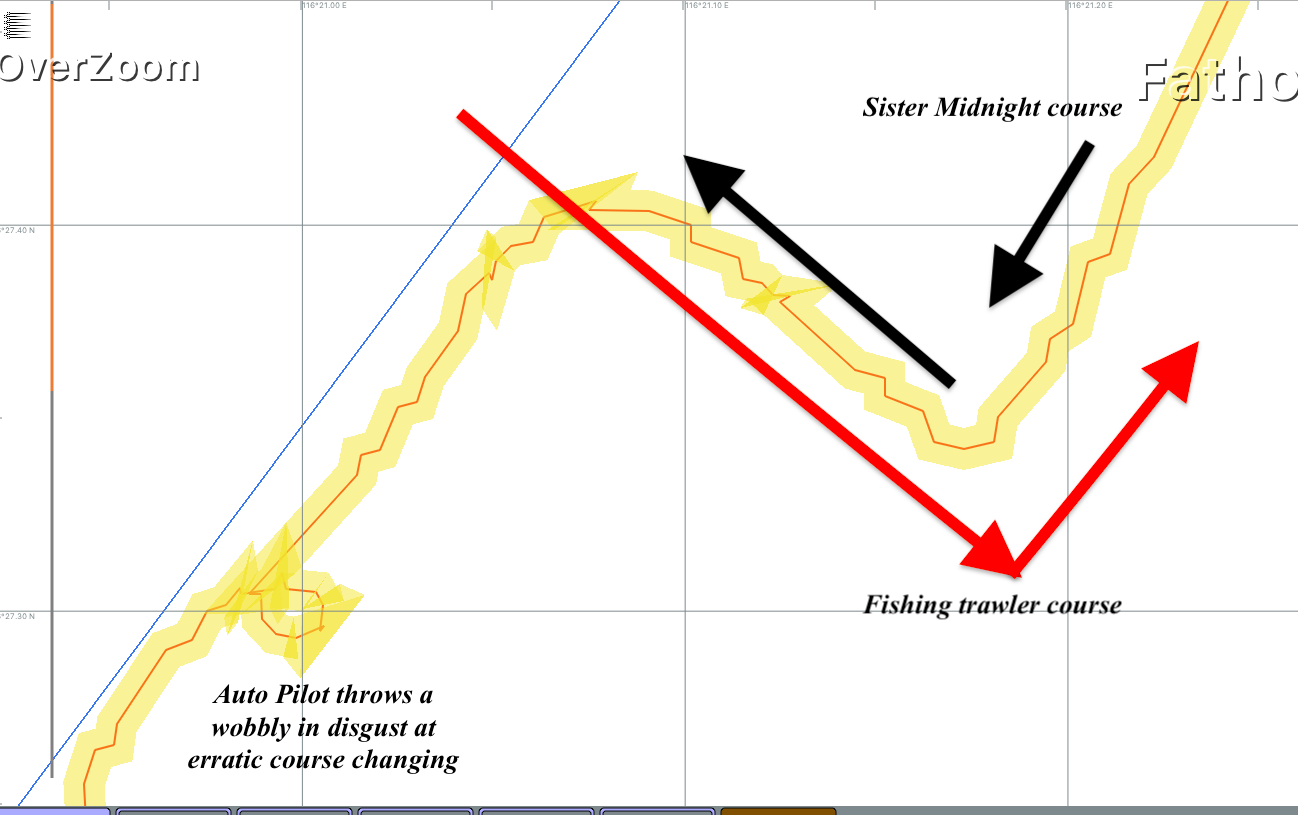
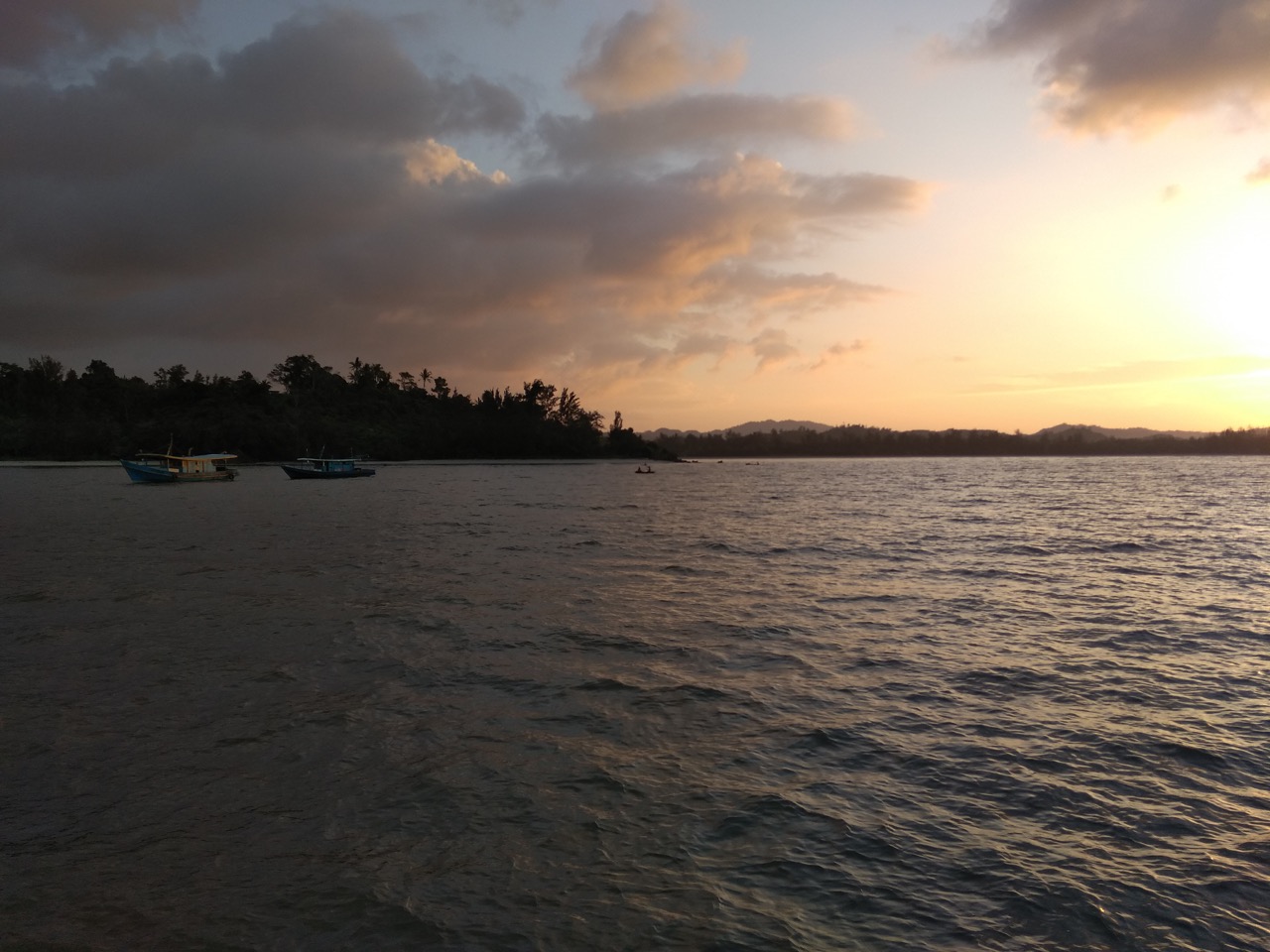
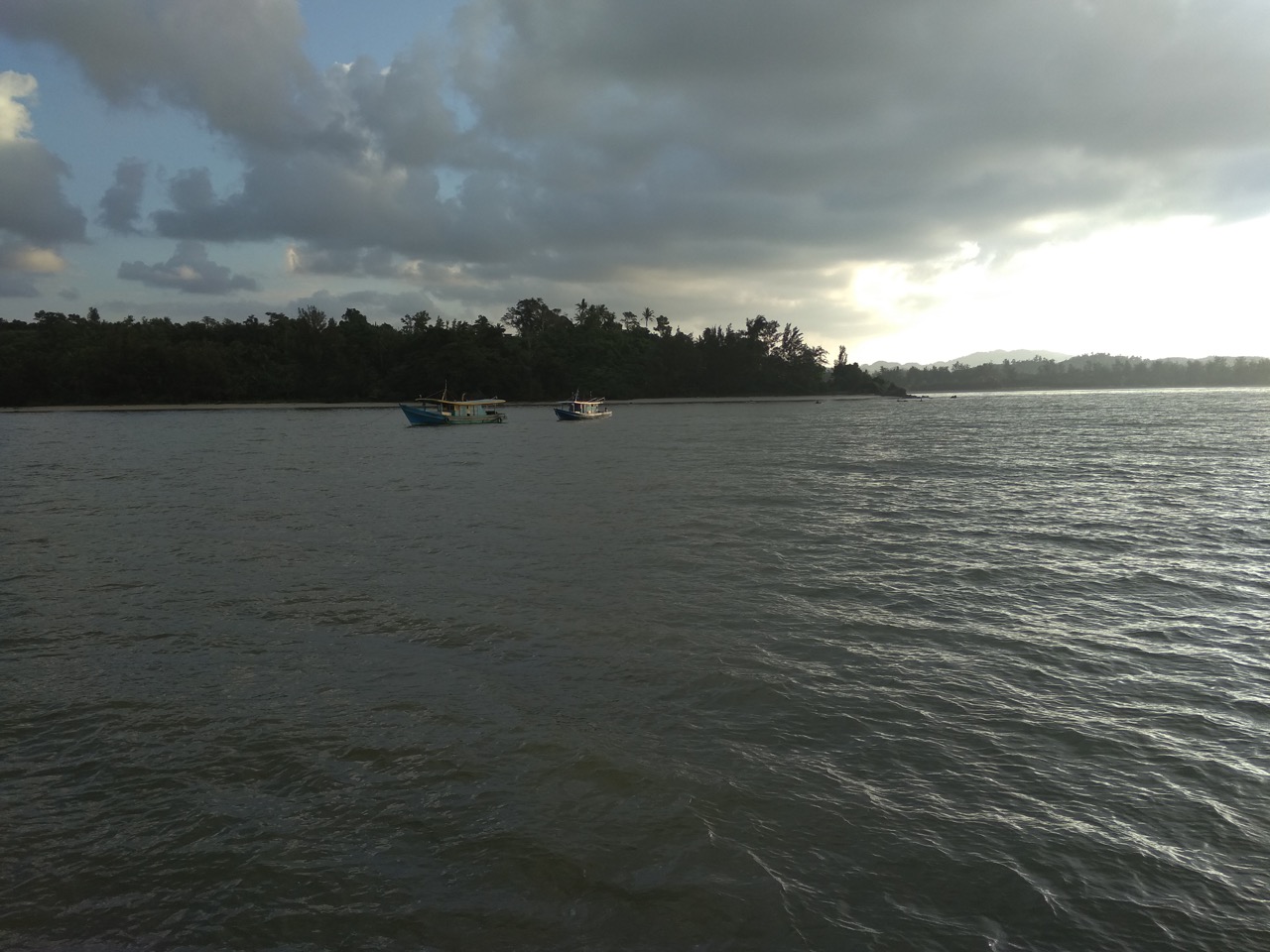 At this point I lose my internet connection, so I’m finishing this off from Sutera harbour.
At this point I lose my internet connection, so I’m finishing this off from Sutera harbour.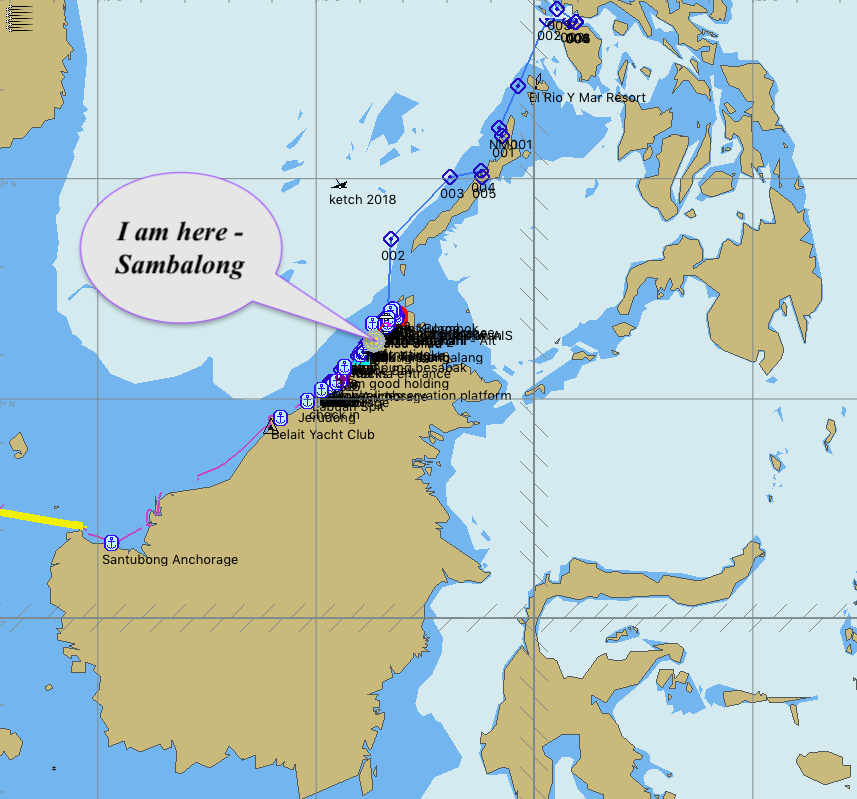 The north side of the bay looked lovely in the morning sunrise light
The north side of the bay looked lovely in the morning sunrise light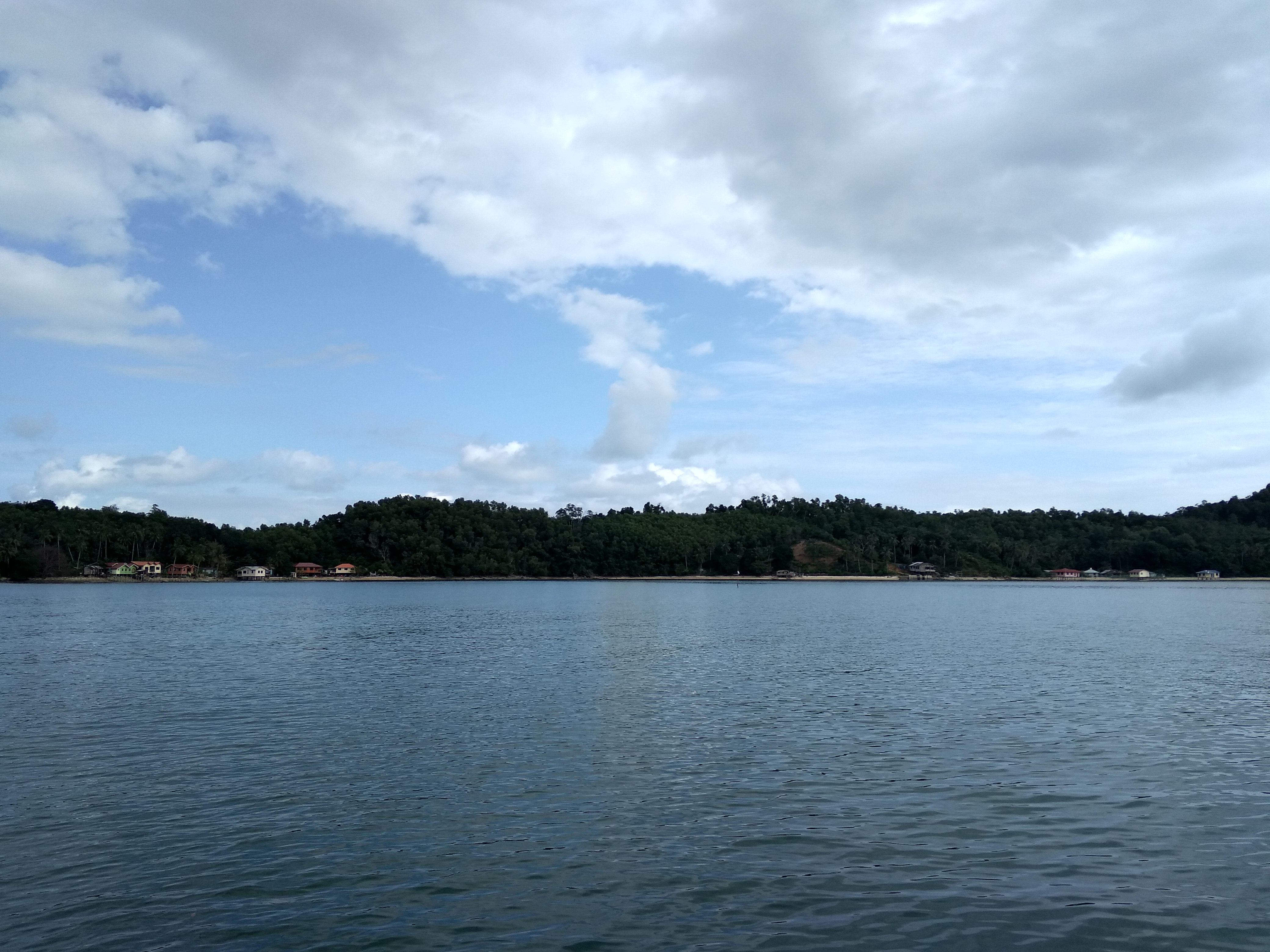 Now below you can see my course to leave the bay, The Khaki is the land, and the green is underwater mud/sand which is less than 0.5 mtrs deep.
Now below you can see my course to leave the bay, The Khaki is the land, and the green is underwater mud/sand which is less than 0.5 mtrs deep. 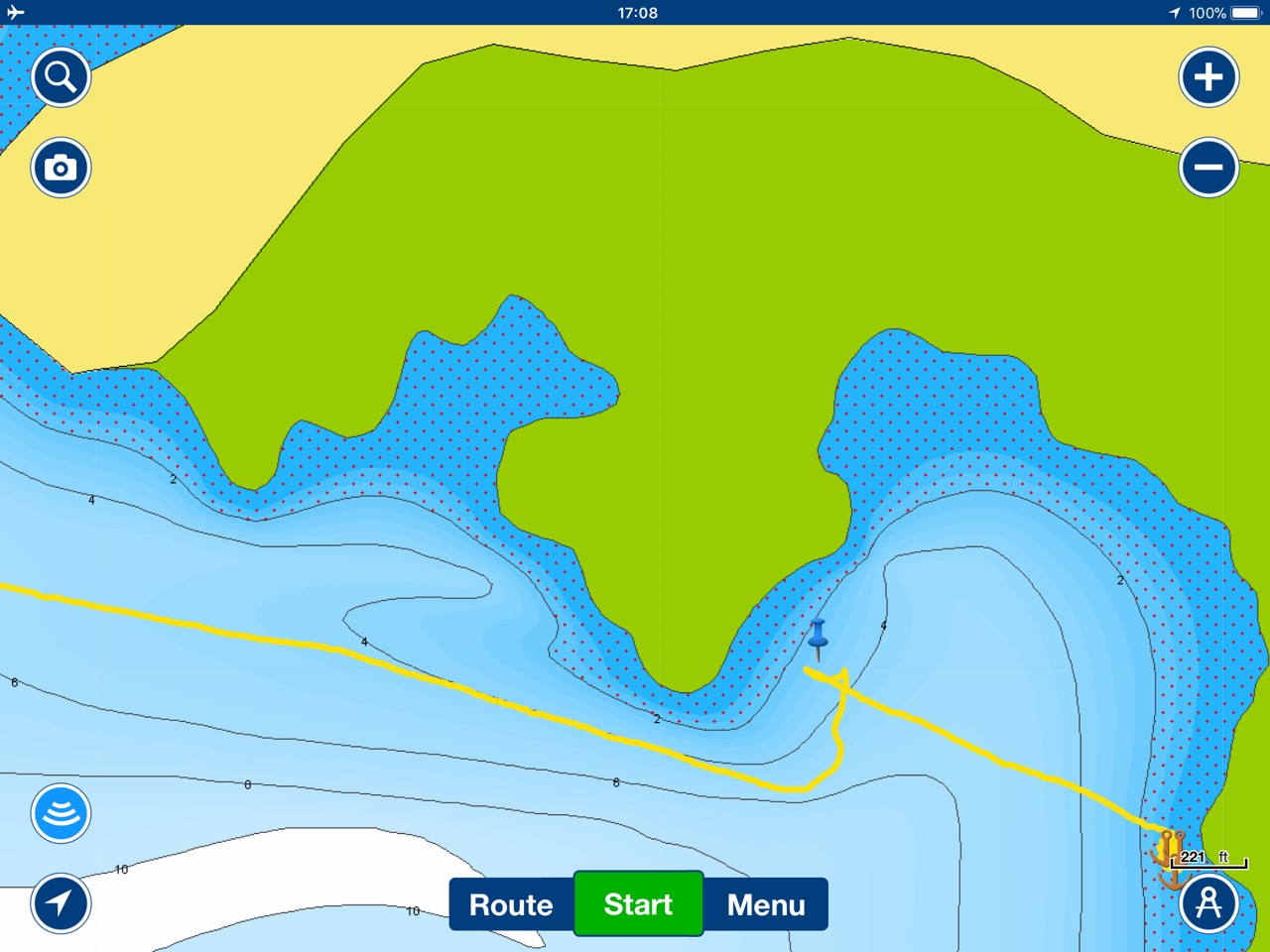 I left the anchorage on the bottom right and set the autohelm to slowly take me out, using my eye to work out the course, as you can see it wasnt a good idea, I was going very slow, about 1 knot, so I could secure the anchor to the boat, while doing this I looked over the side to see the bottom of the sea was quite close, it looked to be about 2-3 foot, but it’s usually deeper, is that parallax, or some other effect, either way we were going to go aground for sure, and before I had time to react the boat made a small gravelly sound and stopped. Bugger, not again, a quick sprint to the wheel, a blast in reverse and we motored back without any effort, yet the wheel wouldn’t turn, it seemed jammed, I’m thinking has the grounding damaged it, could the rudder be in mud still somehow, what to do. Then I remembered, the computer was steering, so quickly turning the autopilot off, and we were away. You really wouldn’t know there was a shallow there without the navionics chart, which is nearly always wrong on these matters anyway. My Cmap chart has the water as being 8 mtrs deep there. Attention to detail is required, or even just attention would help!
I left the anchorage on the bottom right and set the autohelm to slowly take me out, using my eye to work out the course, as you can see it wasnt a good idea, I was going very slow, about 1 knot, so I could secure the anchor to the boat, while doing this I looked over the side to see the bottom of the sea was quite close, it looked to be about 2-3 foot, but it’s usually deeper, is that parallax, or some other effect, either way we were going to go aground for sure, and before I had time to react the boat made a small gravelly sound and stopped. Bugger, not again, a quick sprint to the wheel, a blast in reverse and we motored back without any effort, yet the wheel wouldn’t turn, it seemed jammed, I’m thinking has the grounding damaged it, could the rudder be in mud still somehow, what to do. Then I remembered, the computer was steering, so quickly turning the autopilot off, and we were away. You really wouldn’t know there was a shallow there without the navionics chart, which is nearly always wrong on these matters anyway. My Cmap chart has the water as being 8 mtrs deep there. Attention to detail is required, or even just attention would help!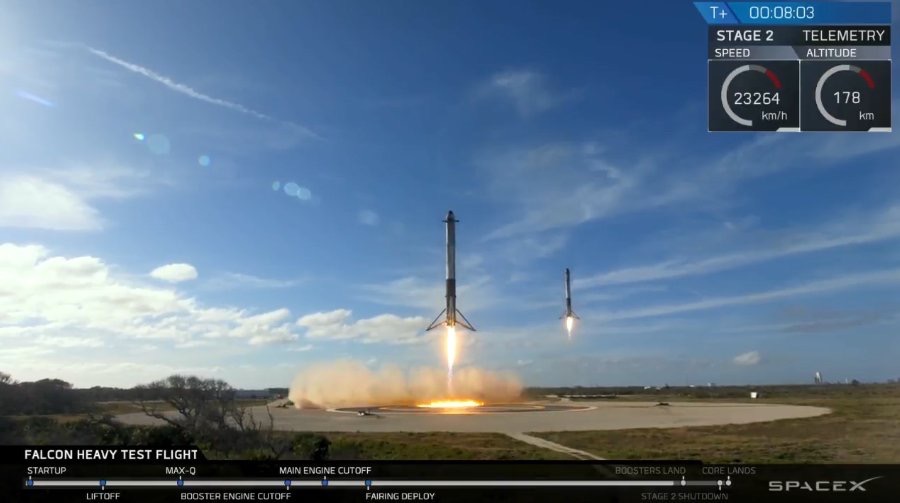
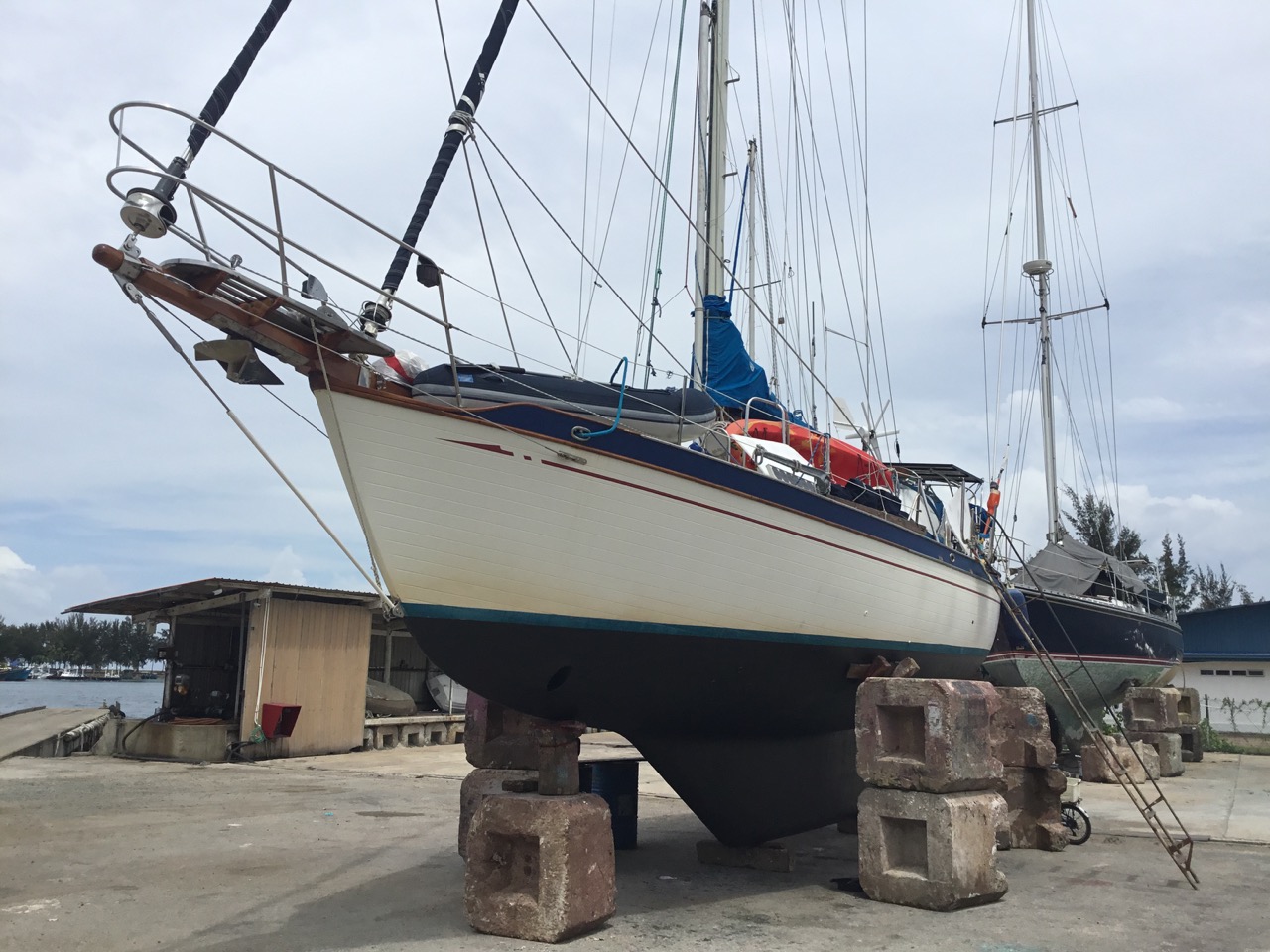 The faulty seacock and one way valve is working fine now,
The faulty seacock and one way valve is working fine now, 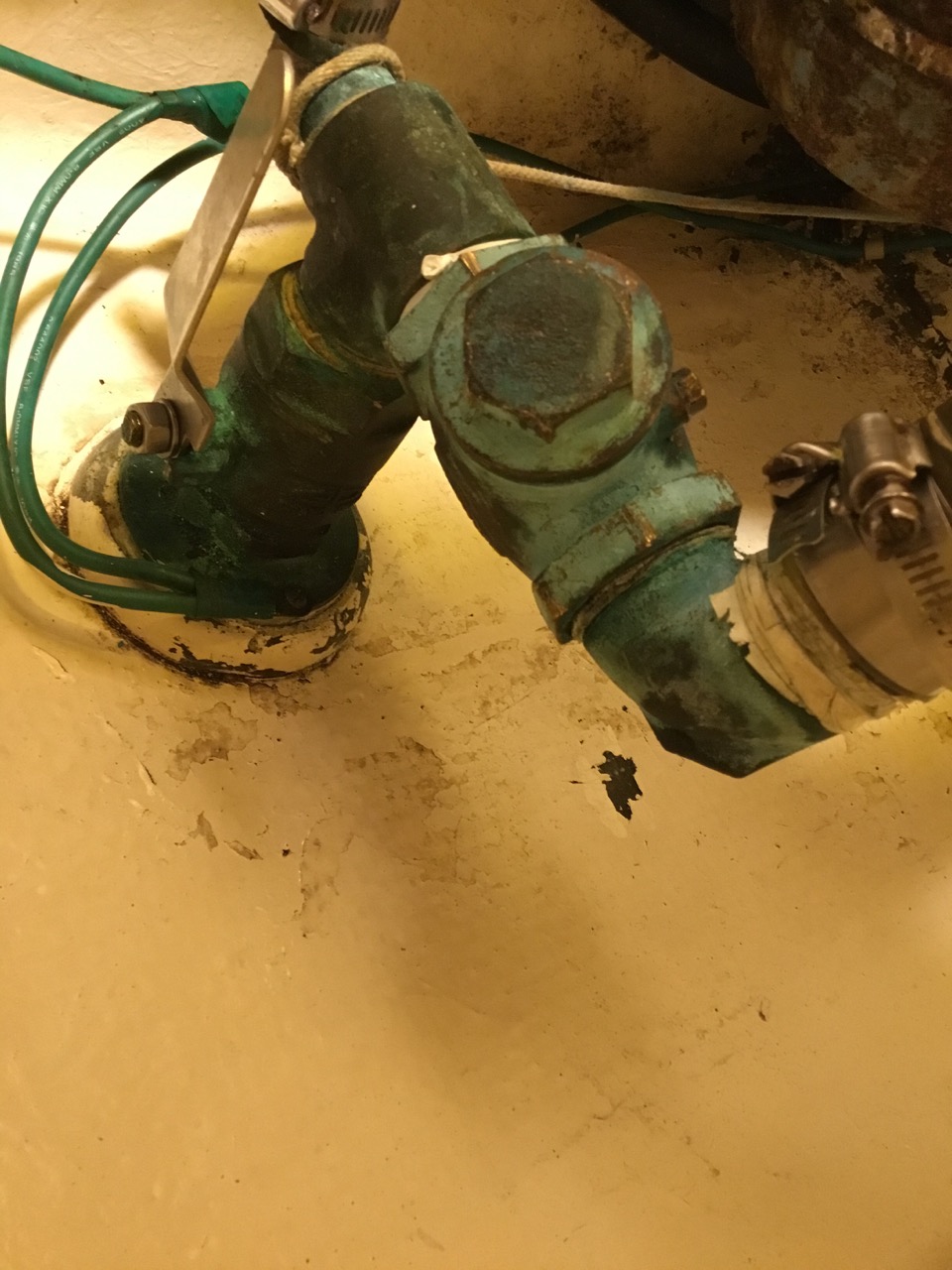 and I’m just going to do a few cosmetic jobs, like patching some scrapes along the waterline / boot top, then have a relaxing weekend before launching on Tuesday. I decided not to replace the hull zincs, although they look worn down, there’s still a substantial amount of zinc there, and given the rate of decay, they should be good for another year. One of my jobs is to redo the earthing wires inside the boat, several have broken off the seacocks so, this might increase the anode decay.
and I’m just going to do a few cosmetic jobs, like patching some scrapes along the waterline / boot top, then have a relaxing weekend before launching on Tuesday. I decided not to replace the hull zincs, although they look worn down, there’s still a substantial amount of zinc there, and given the rate of decay, they should be good for another year. One of my jobs is to redo the earthing wires inside the boat, several have broken off the seacocks so, this might increase the anode decay.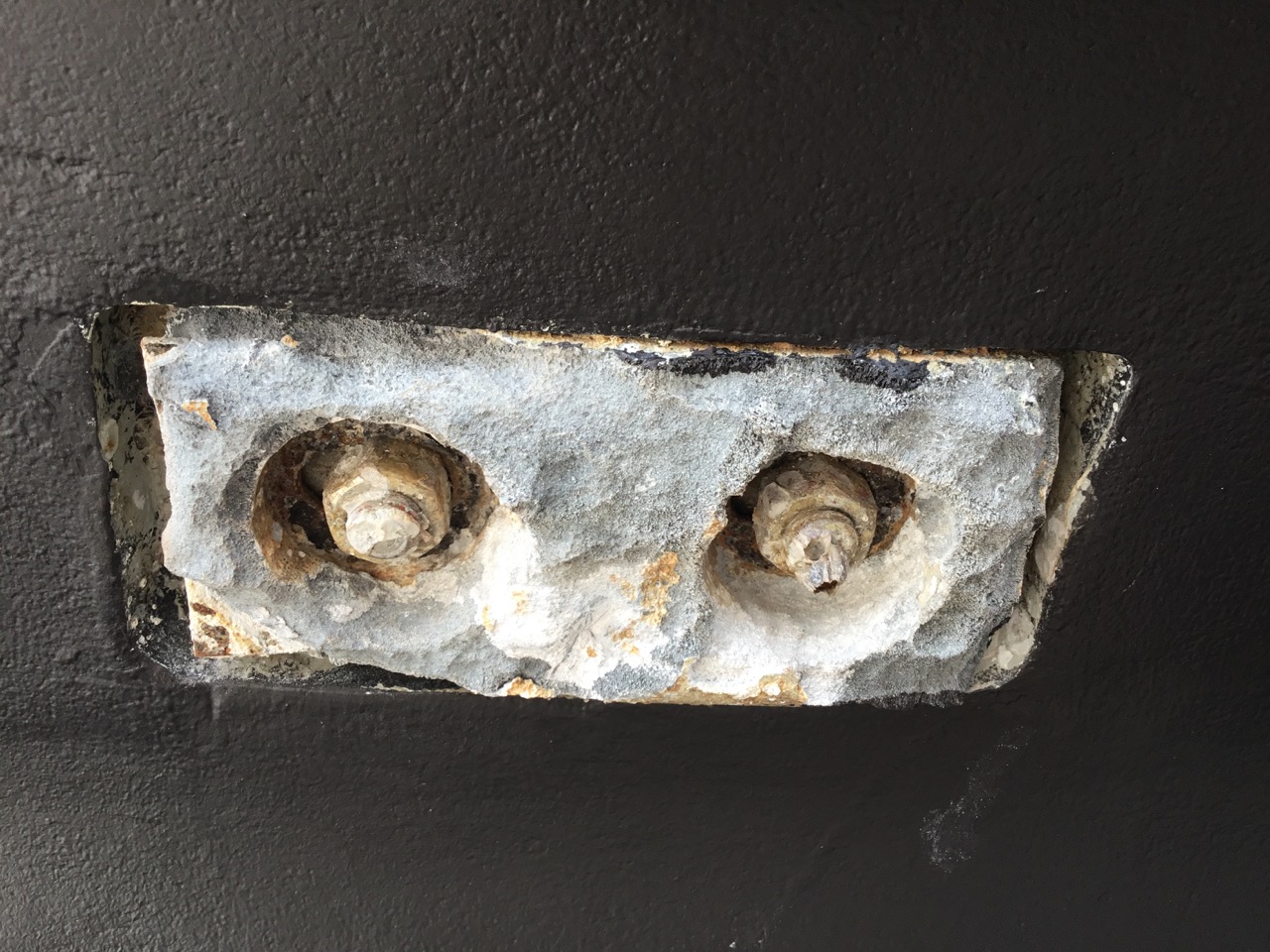
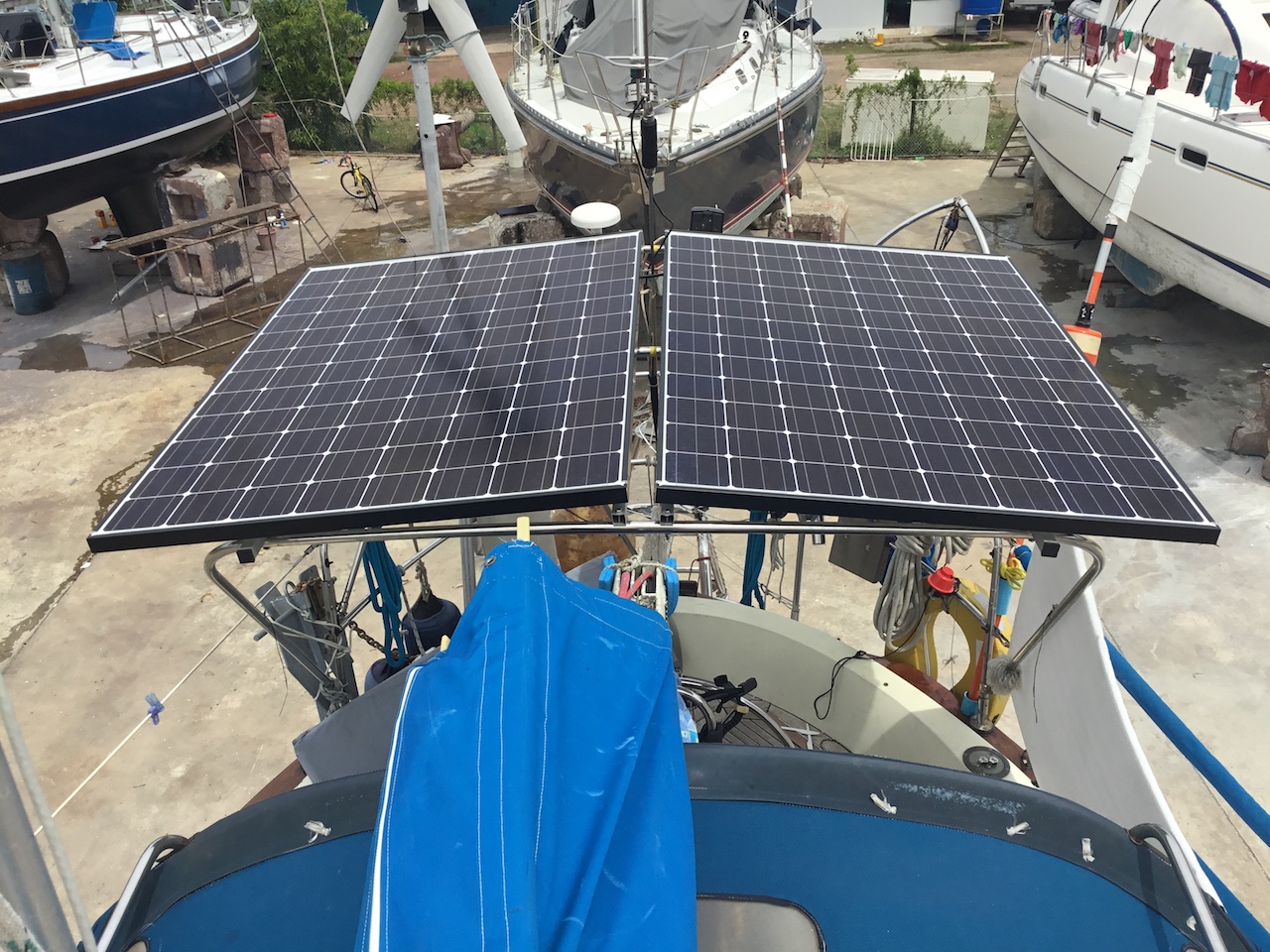
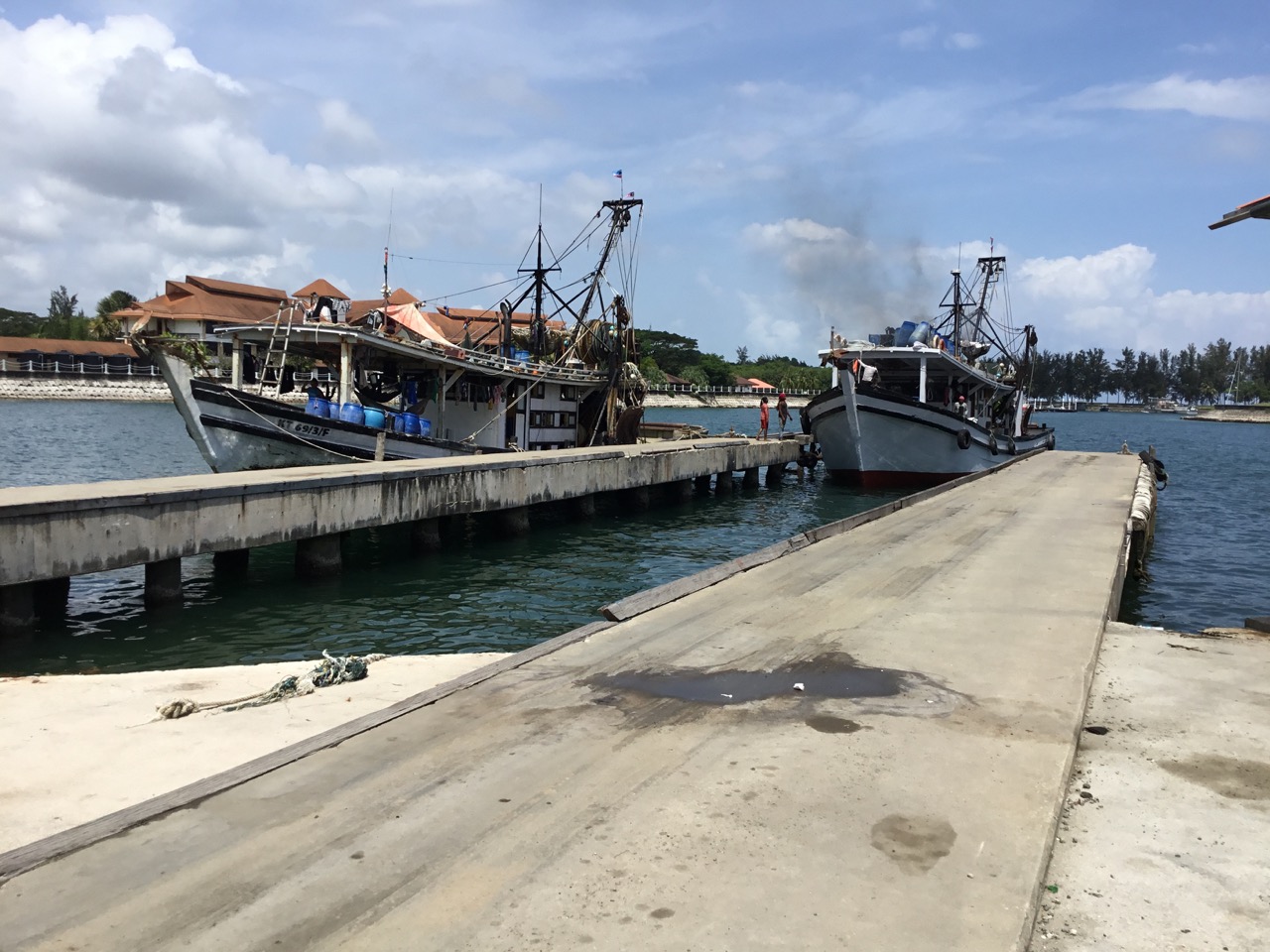
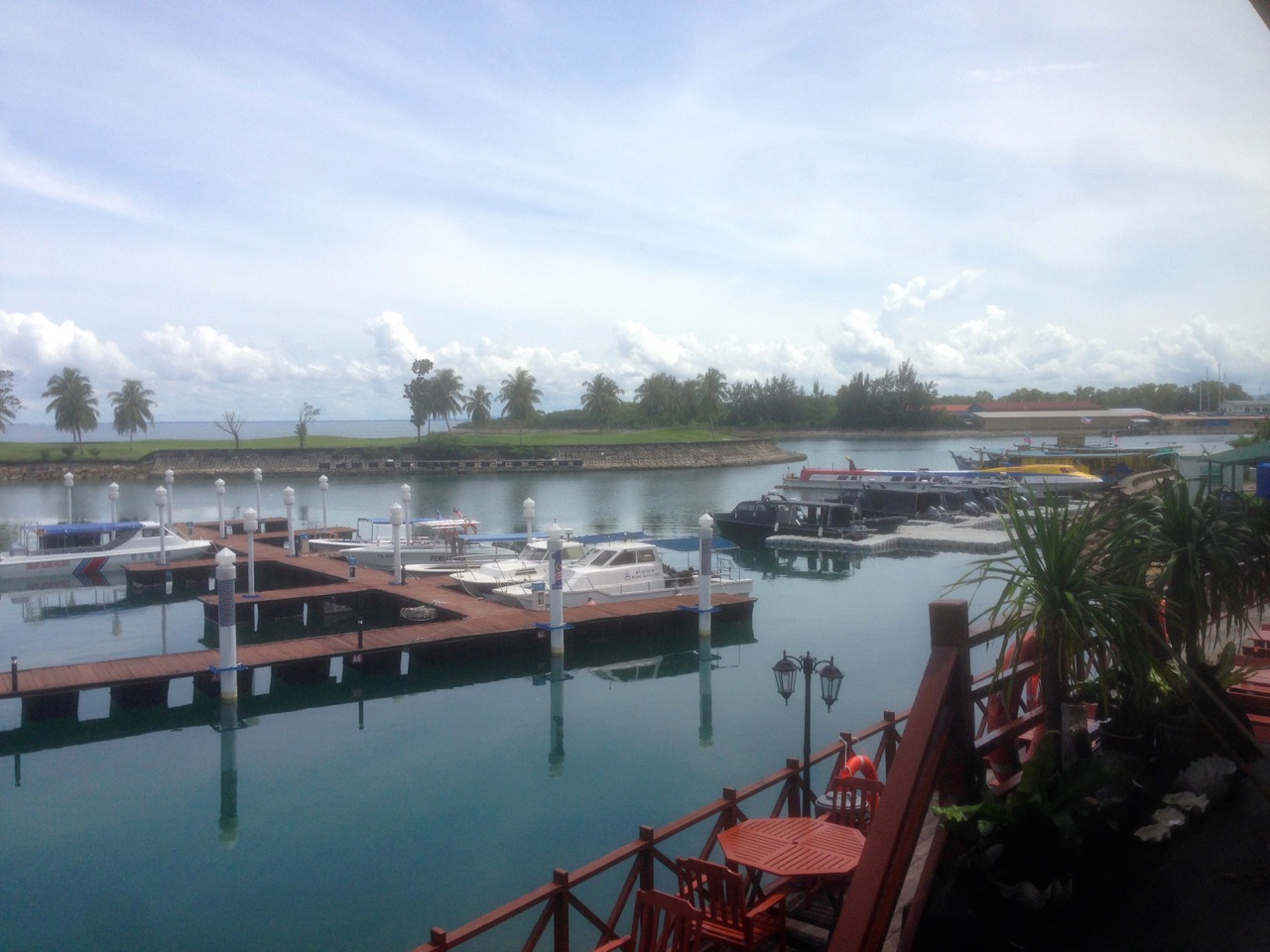 There’s a lovely little marina at the other end from the yard, and you can tie up to mooring bouys here for free. It’s very laid back, the marina has a nice little cafe, and a few berths, but it’s a low key affair.
There’s a lovely little marina at the other end from the yard, and you can tie up to mooring bouys here for free. It’s very laid back, the marina has a nice little cafe, and a few berths, but it’s a low key affair.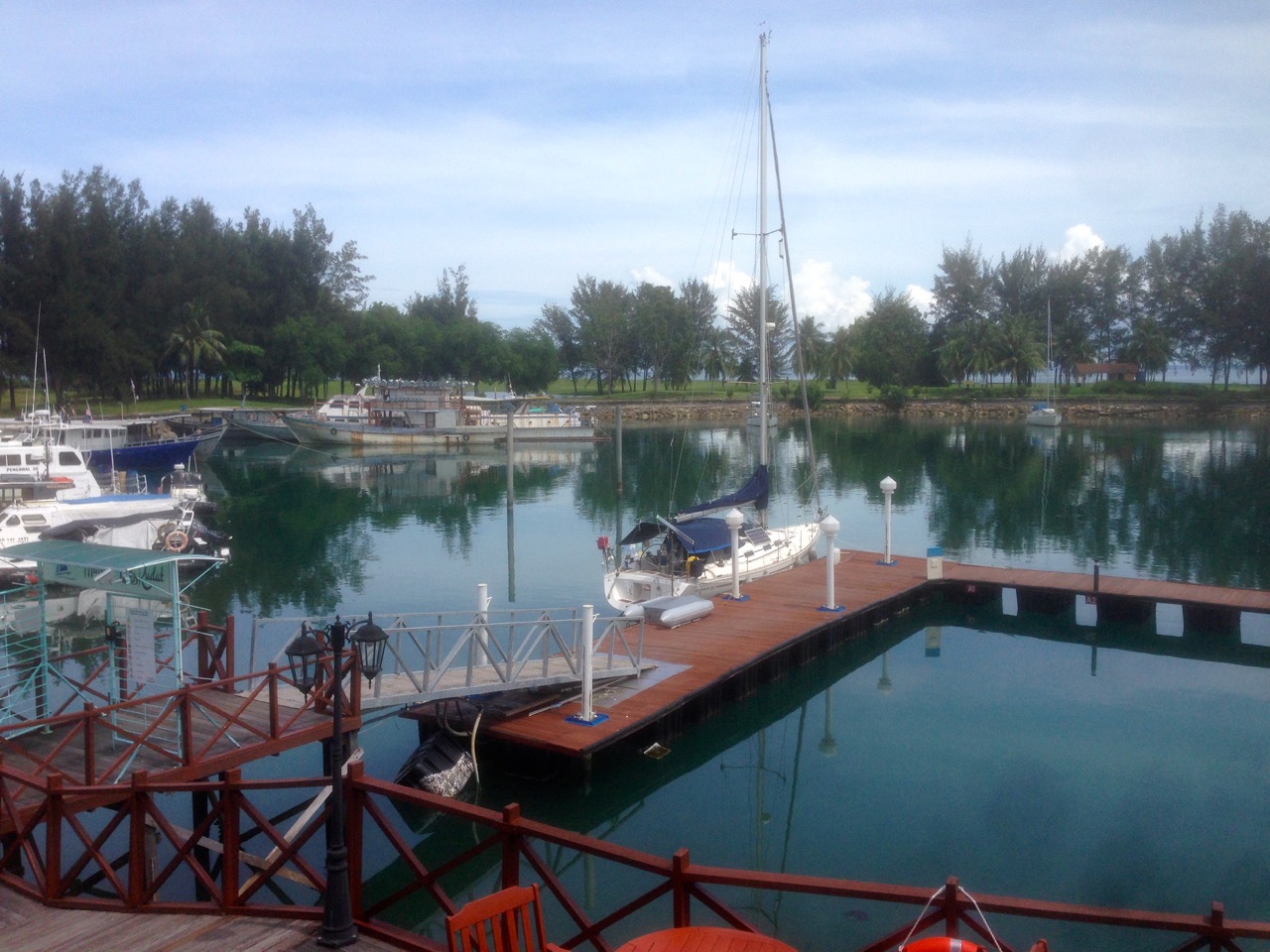


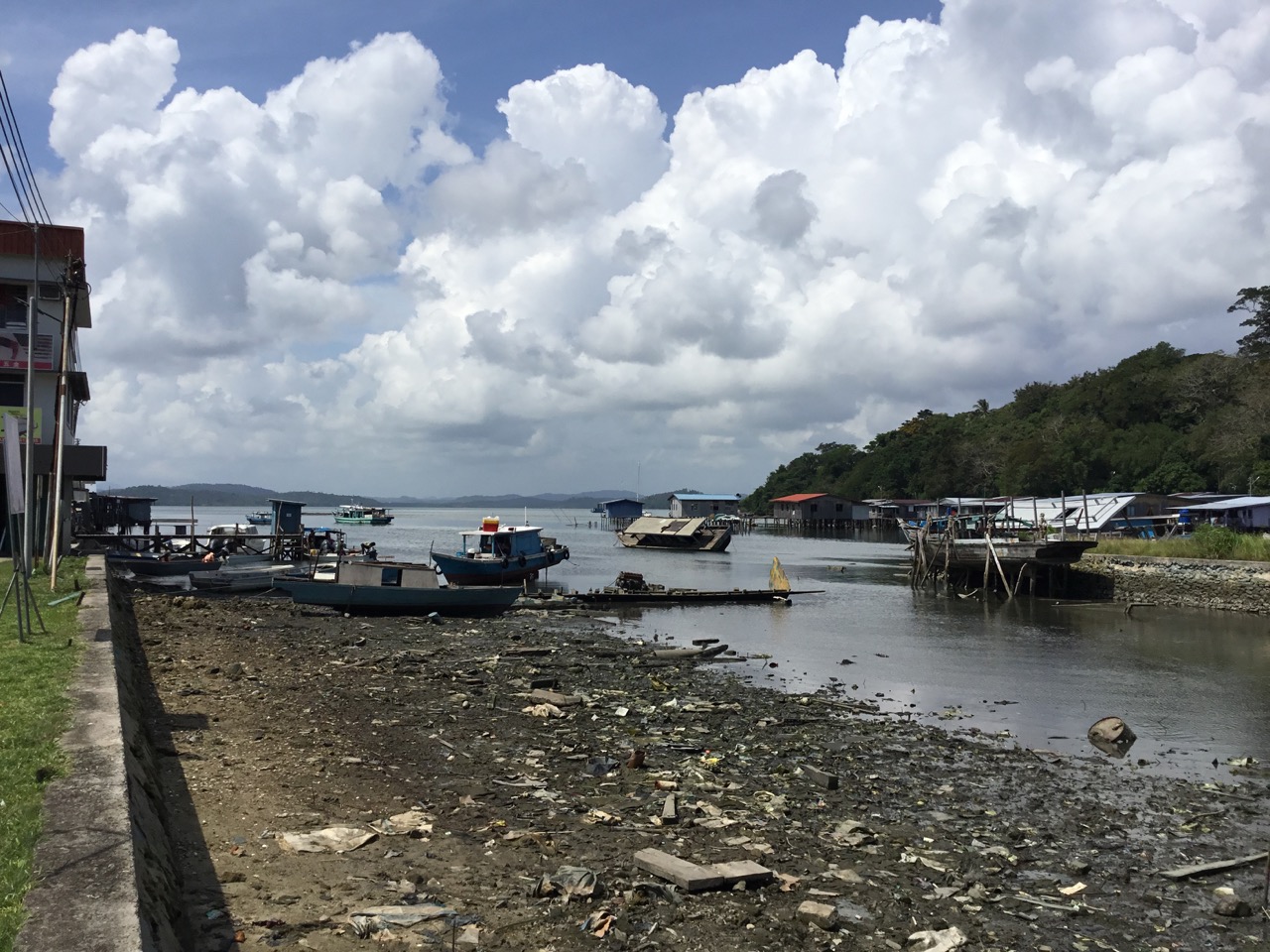 Mostly the town is home to a fleet of fishing boats, many of them squid boats. I had one of the crew help me choose the best lure for catching Squid today. I have restocked on lures, lines, wires, hooks etc. I fully expect to have a full freezer of fish by the time I arrive in Labuan in a weeks time.
Mostly the town is home to a fleet of fishing boats, many of them squid boats. I had one of the crew help me choose the best lure for catching Squid today. I have restocked on lures, lines, wires, hooks etc. I fully expect to have a full freezer of fish by the time I arrive in Labuan in a weeks time.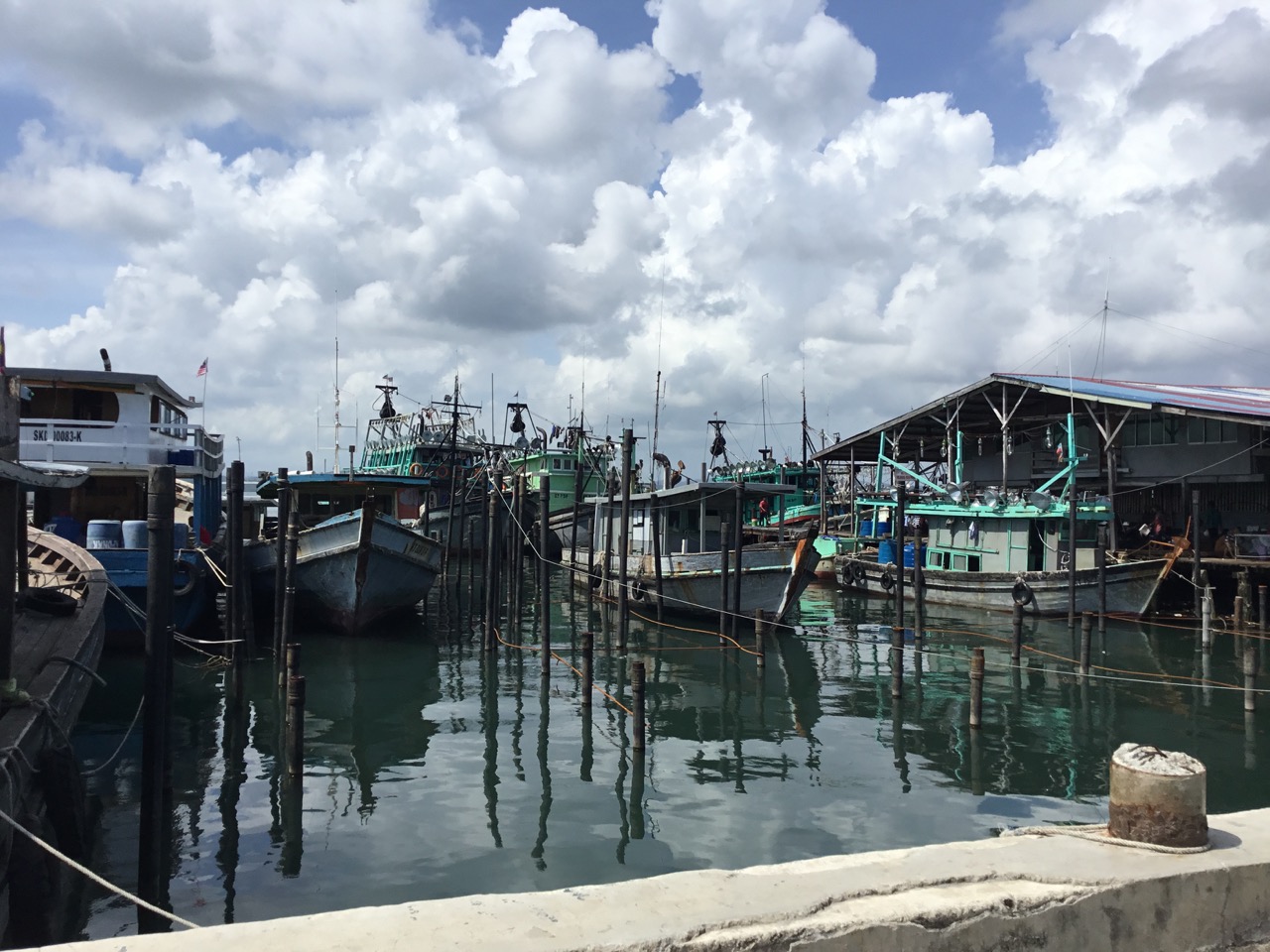
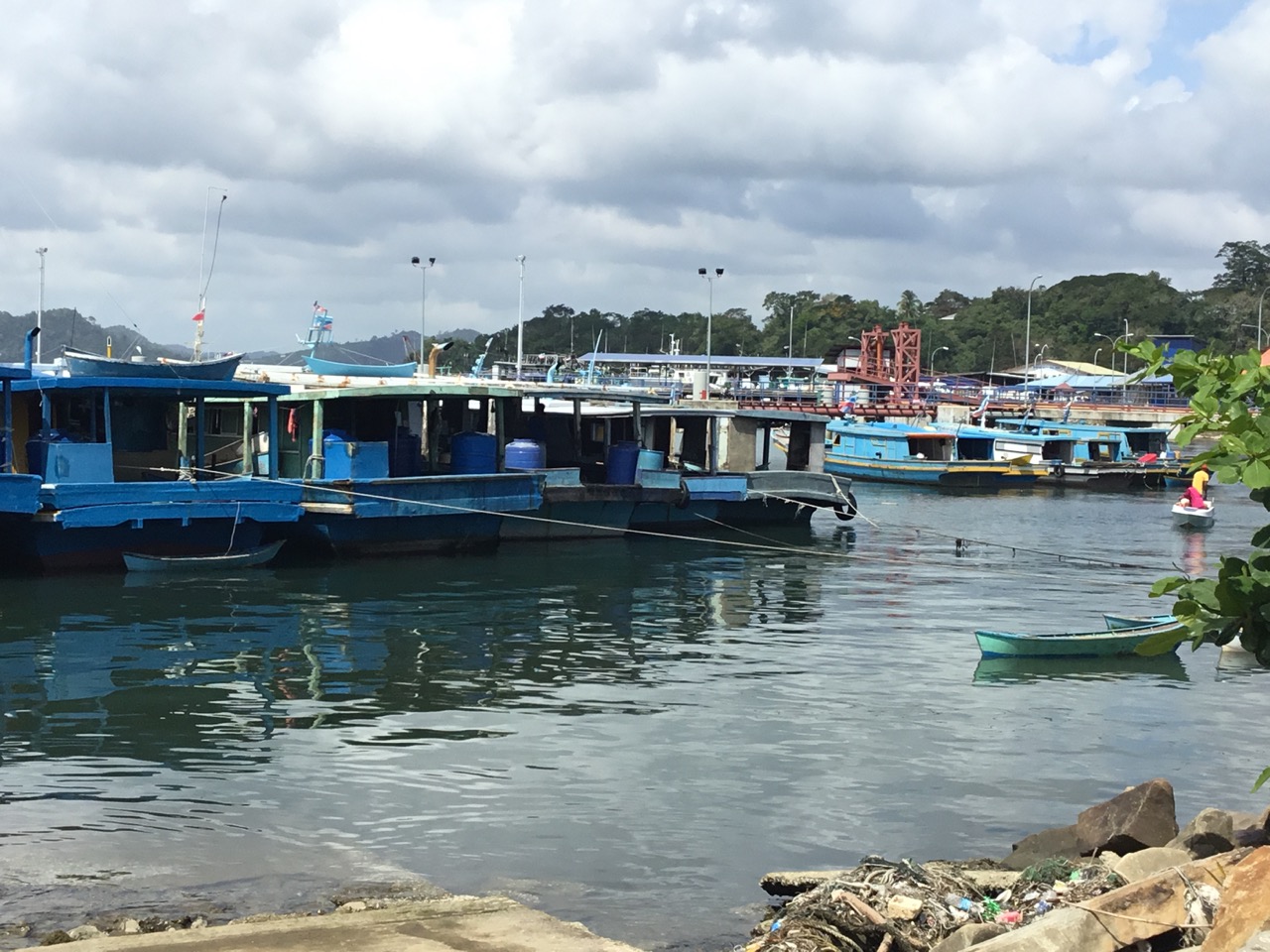
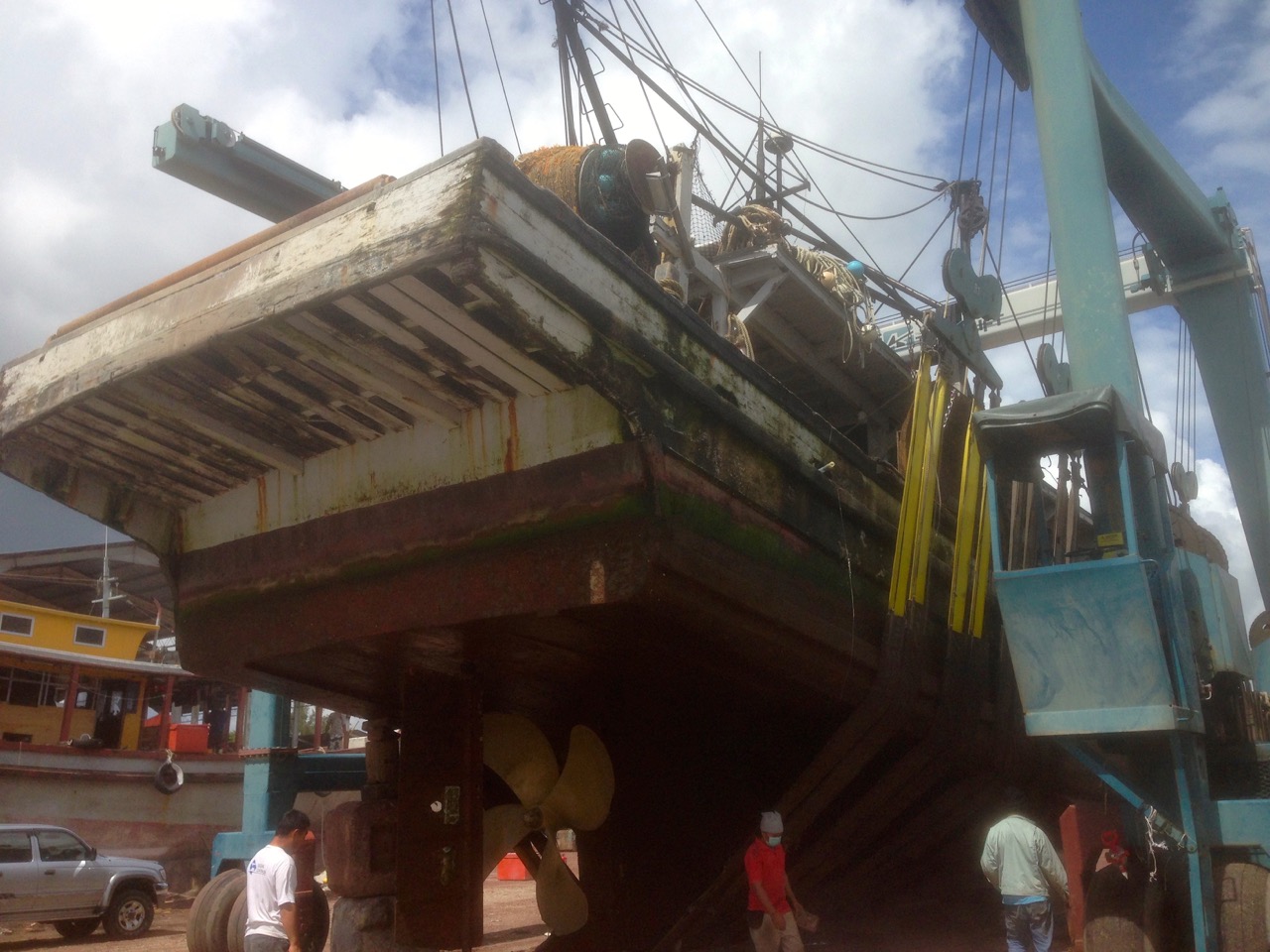 Of course, the boat has been quite a tip the last week, but all the jobs are done now, so I can start tidying up. I gave my three old solar panels away to some French cruisers who are in the yard here.
Of course, the boat has been quite a tip the last week, but all the jobs are done now, so I can start tidying up. I gave my three old solar panels away to some French cruisers who are in the yard here.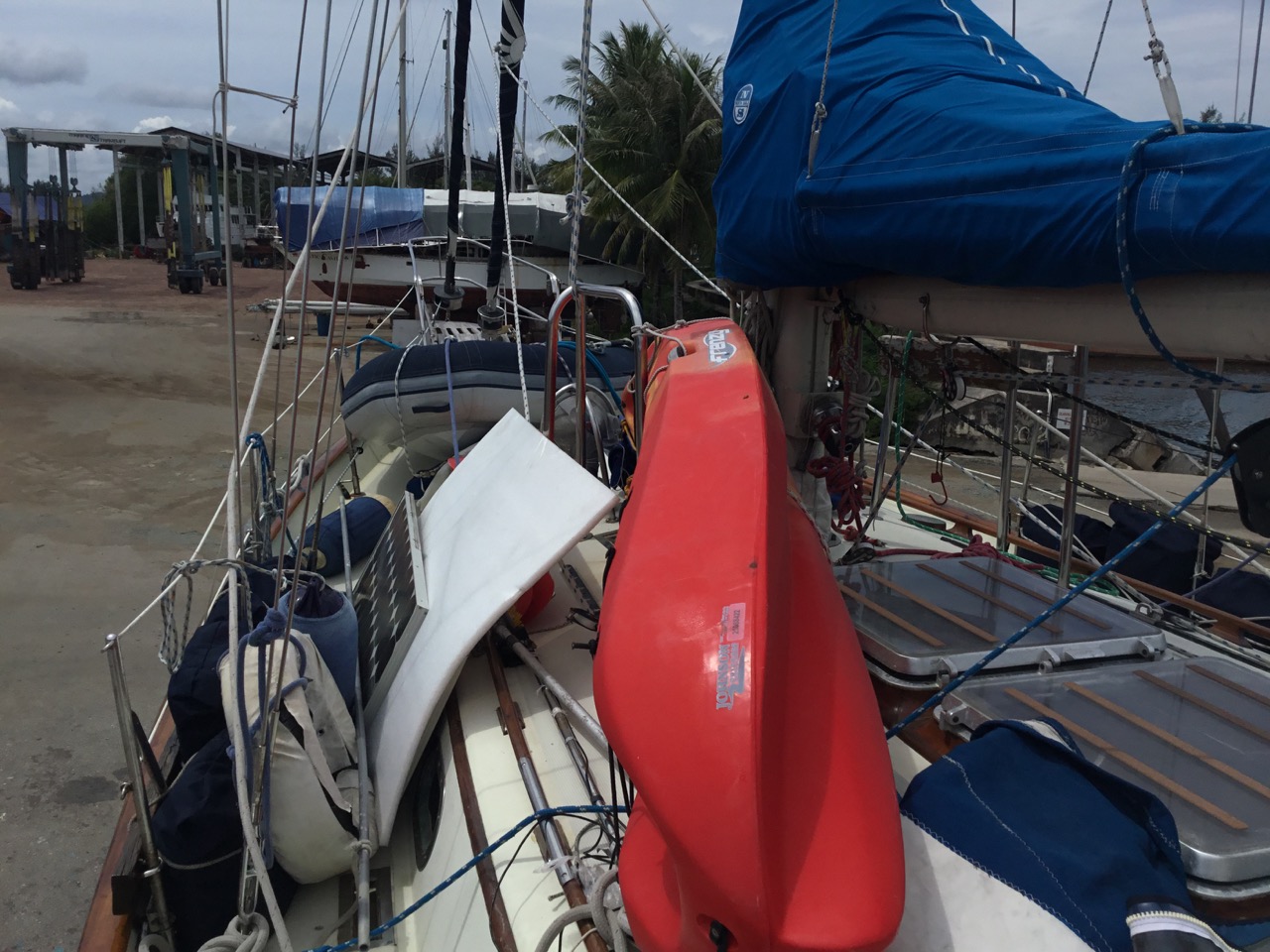 So I built a mockup of the frame for the solar panels to sit on first, I found a double glazing shop that sold me a stack of aluminium extrusion, box shape, which I used. I had planned to have it welded together, but the hardware store next door had a good supply of stainless steel bolts at a very very reasonable price, so I bolted it all together, with the thought of maybe welding it later. I have since decided that bolts are better, and will have more give than a weld as the frame comes under stress.
So I built a mockup of the frame for the solar panels to sit on first, I found a double glazing shop that sold me a stack of aluminium extrusion, box shape, which I used. I had planned to have it welded together, but the hardware store next door had a good supply of stainless steel bolts at a very very reasonable price, so I bolted it all together, with the thought of maybe welding it later. I have since decided that bolts are better, and will have more give than a weld as the frame comes under stress.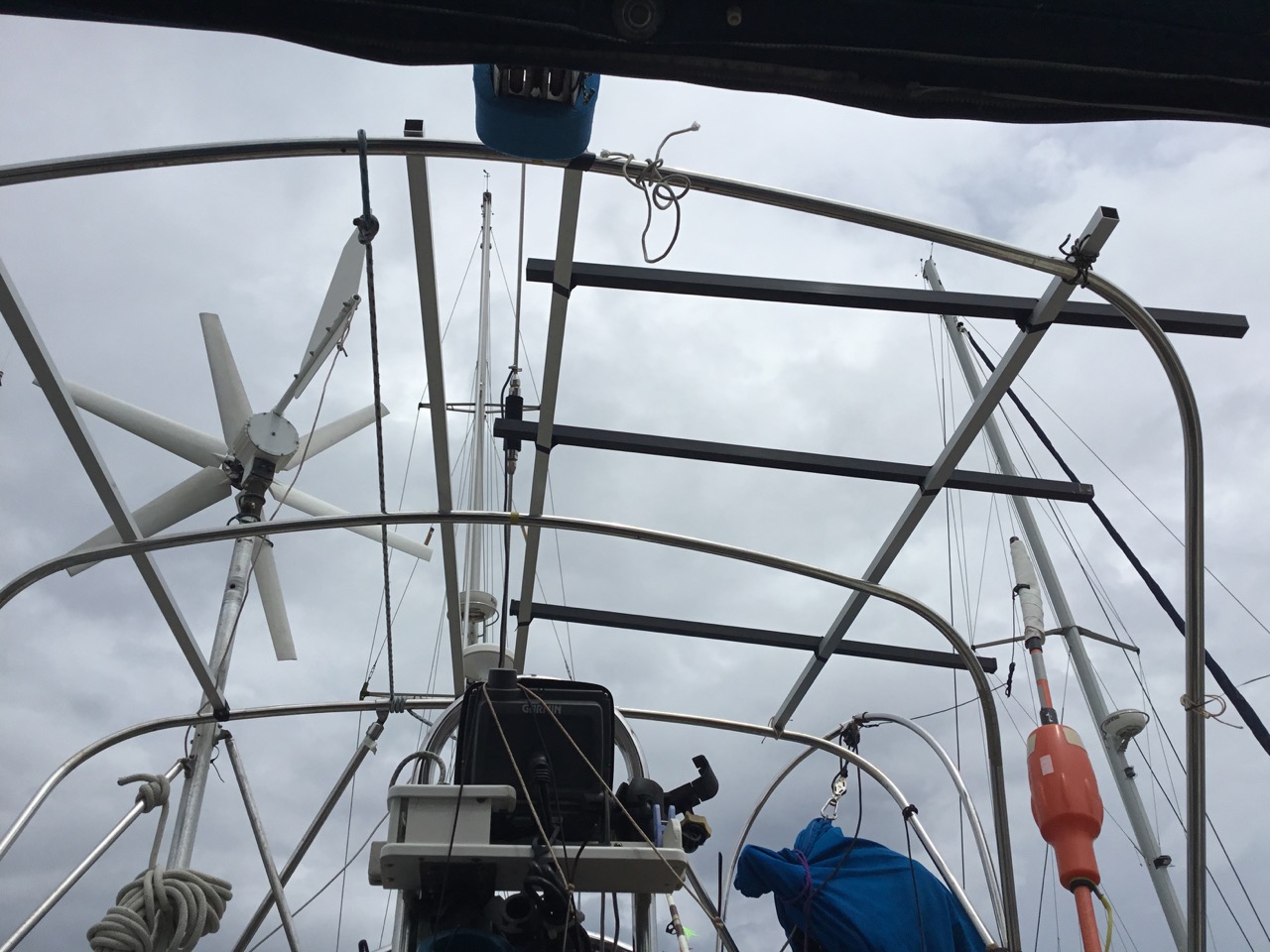 With a little help from Brent, a Brit on the catamaran behind me, I got the new panels mounted and bolted down. I can’t find supply of jointing compound anywhere. I hope they have some in America 😉
With a little help from Brent, a Brit on the catamaran behind me, I got the new panels mounted and bolted down. I can’t find supply of jointing compound anywhere. I hope they have some in America 😉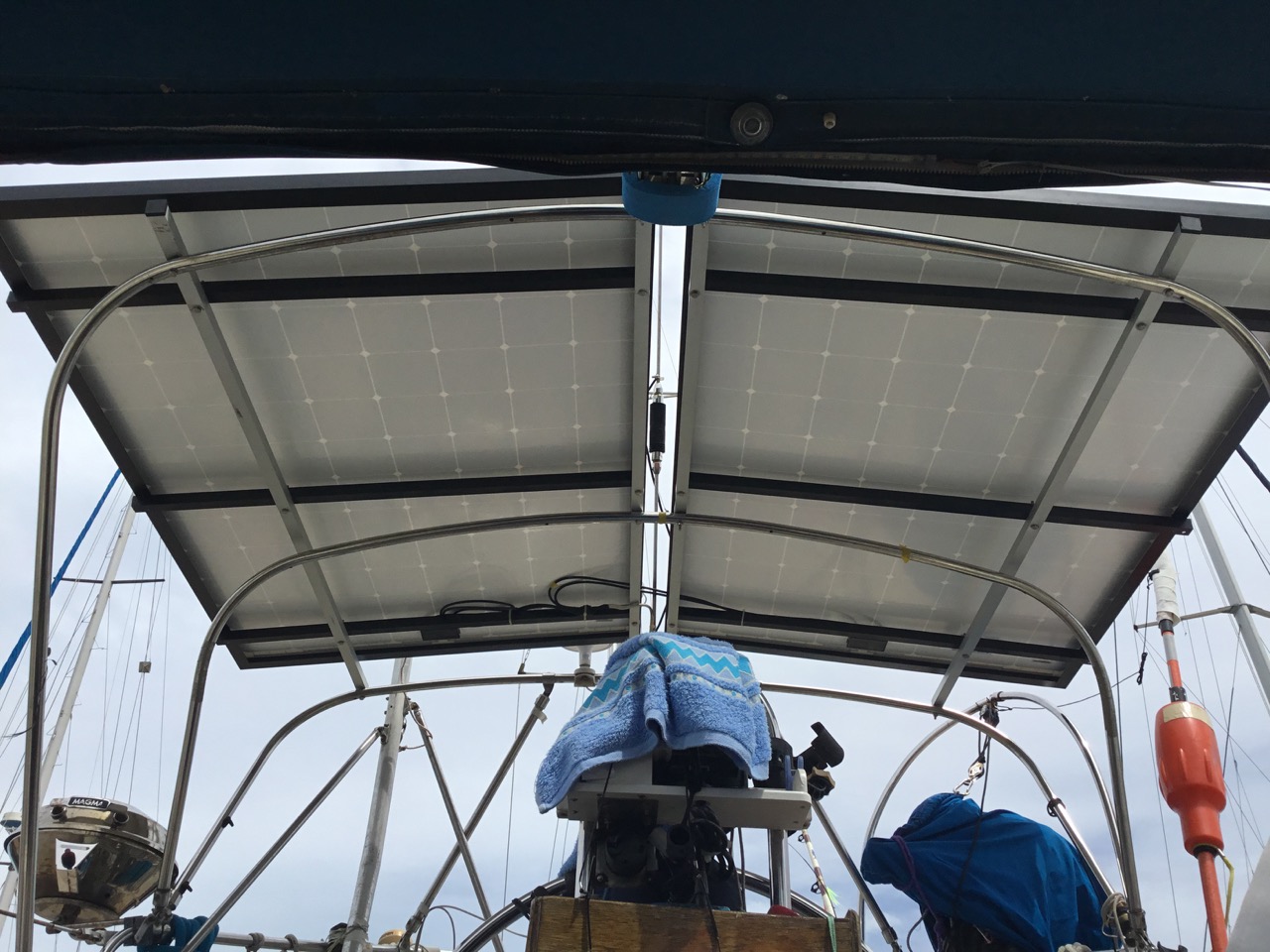
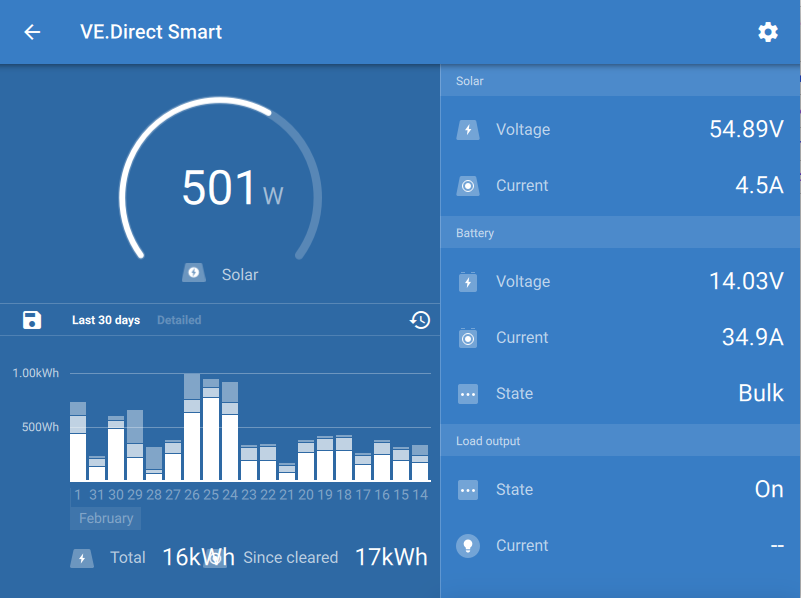 The panels are pumping 35A into the boat, I had to put every 12V device on, lights, deck lights, radar, fans fridge etc to get this up, as the batteries wouldn’t take more than 20-25A. I expect I could get 40A if needed, but at the moment, I have had the mains charger turned off for a few days, and I find the batteries are fully recharged from the evening/nights drain by about 10AM. At 07:30, not long after sunrise, with the sun low in the sky, they are providing 10A. I expect that in the northern latitudes, they will perform less well, but will be more than enough. I’m keen to find out.
The panels are pumping 35A into the boat, I had to put every 12V device on, lights, deck lights, radar, fans fridge etc to get this up, as the batteries wouldn’t take more than 20-25A. I expect I could get 40A if needed, but at the moment, I have had the mains charger turned off for a few days, and I find the batteries are fully recharged from the evening/nights drain by about 10AM. At 07:30, not long after sunrise, with the sun low in the sky, they are providing 10A. I expect that in the northern latitudes, they will perform less well, but will be more than enough. I’m keen to find out.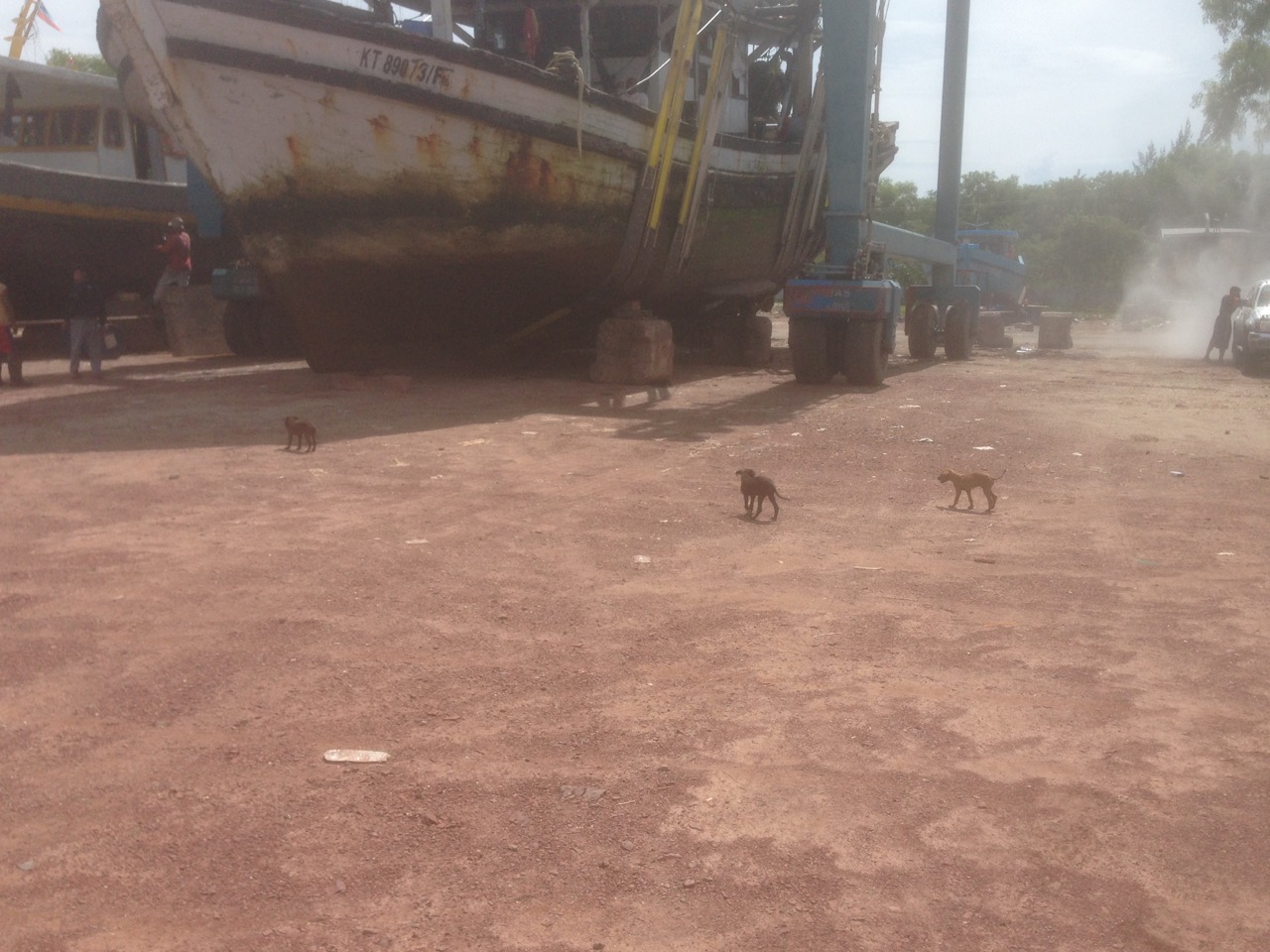 I had booked the 8 AM slot for launch on Monday, but later realised that I had to go to three offices to checkout, harbour master, immigration and customs. I have to get my passport stamped to leave Sabah to travel to Labuan, both Malaysia, but different states. I don’t think people back home fully appreciate the benefits of freedom of movement.
I had booked the 8 AM slot for launch on Monday, but later realised that I had to go to three offices to checkout, harbour master, immigration and customs. I have to get my passport stamped to leave Sabah to travel to Labuan, both Malaysia, but different states. I don’t think people back home fully appreciate the benefits of freedom of movement.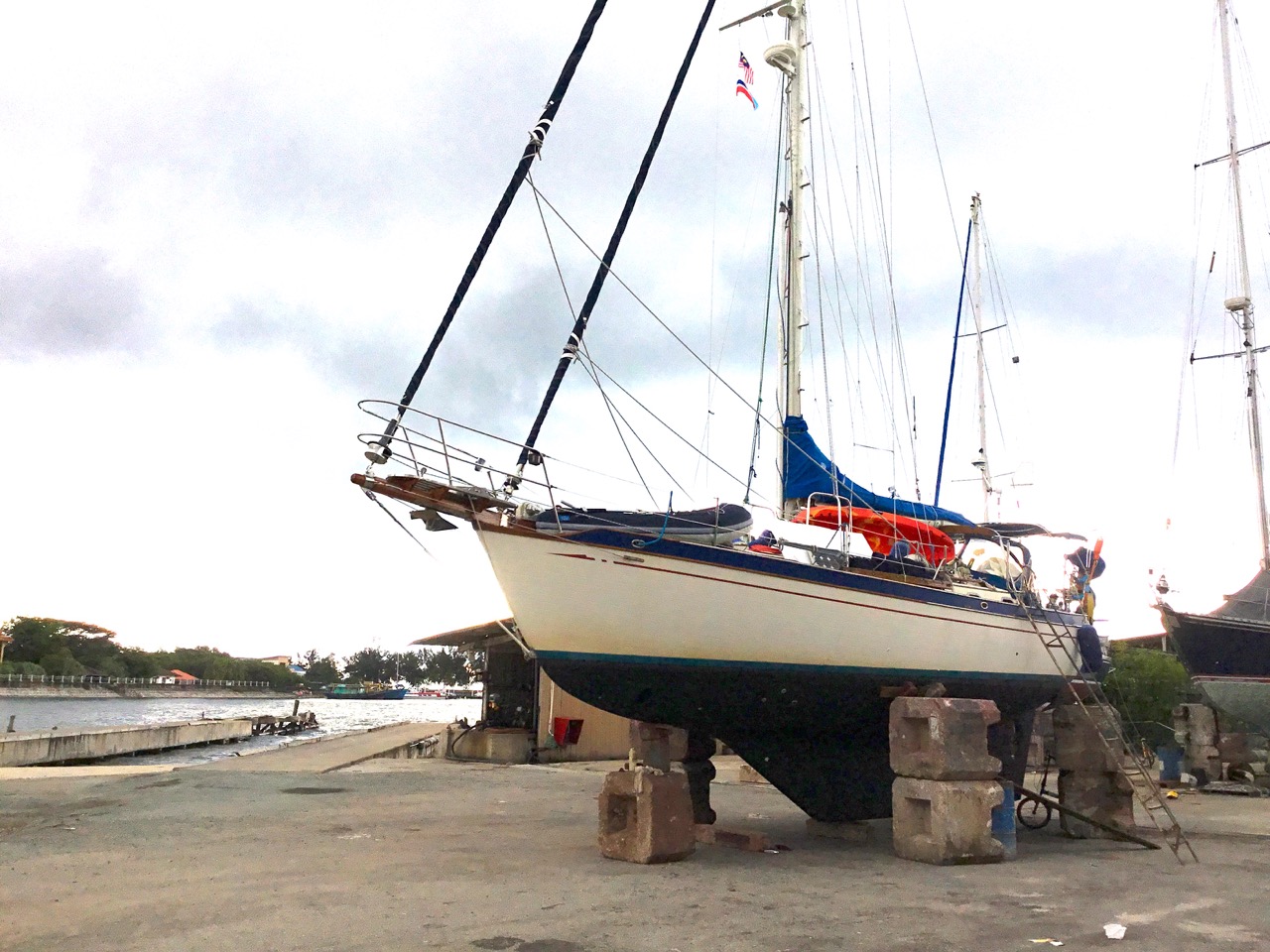

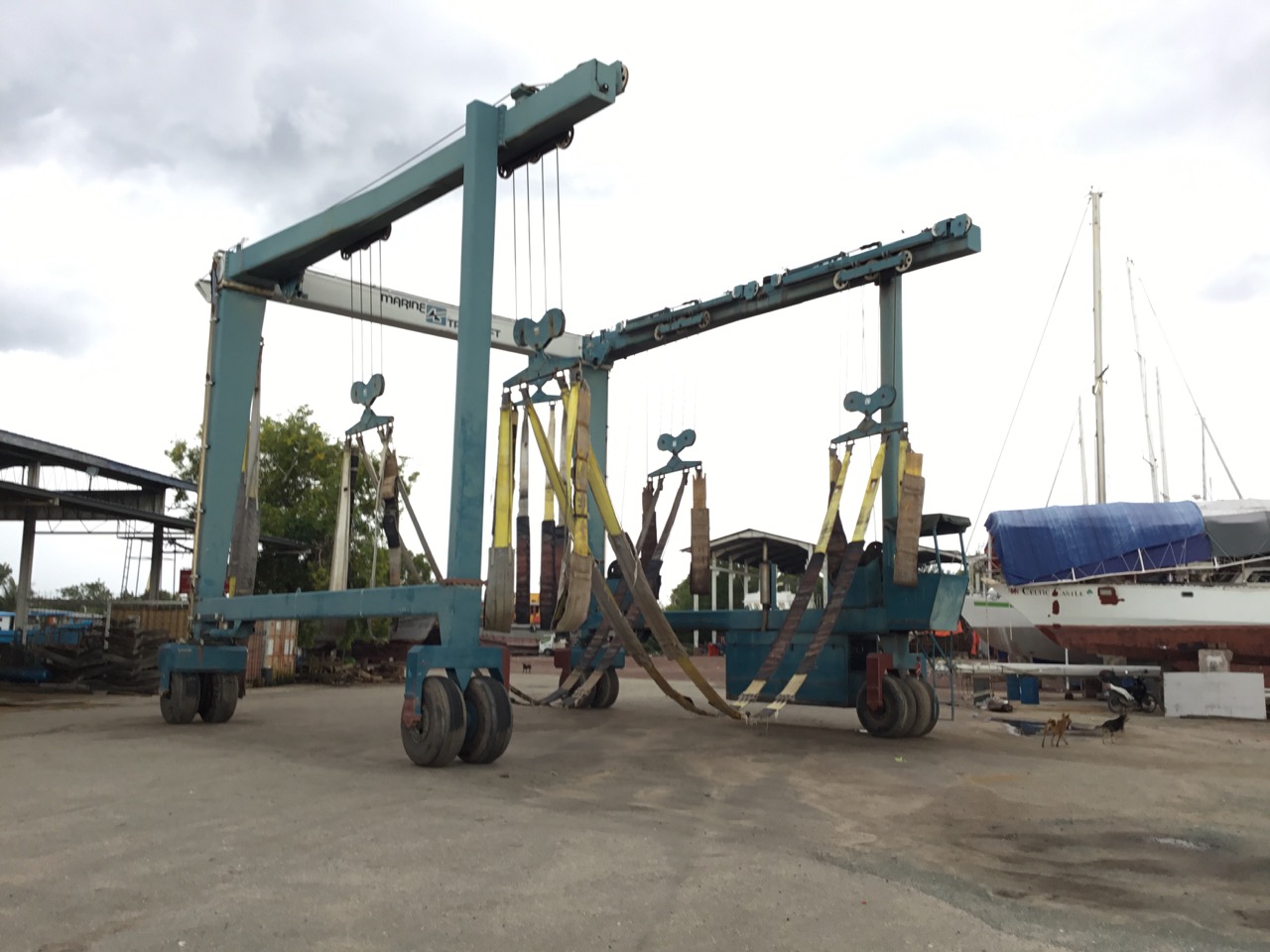 The view down the ladder, it’s a long way and I must remember not to trust the guard rails
The view down the ladder, it’s a long way and I must remember not to trust the guard rails


 exposed iron ballast
exposed iron ballast
 The Machine shop
The Machine shop

 The Prop Making machine. I have to see how this works
The Prop Making machine. I have to see how this works


 The drums below hold the resin they use
The drums below hold the resin they use





 Other boats resting here
Other boats resting here









 The workers canteen
The workers canteen



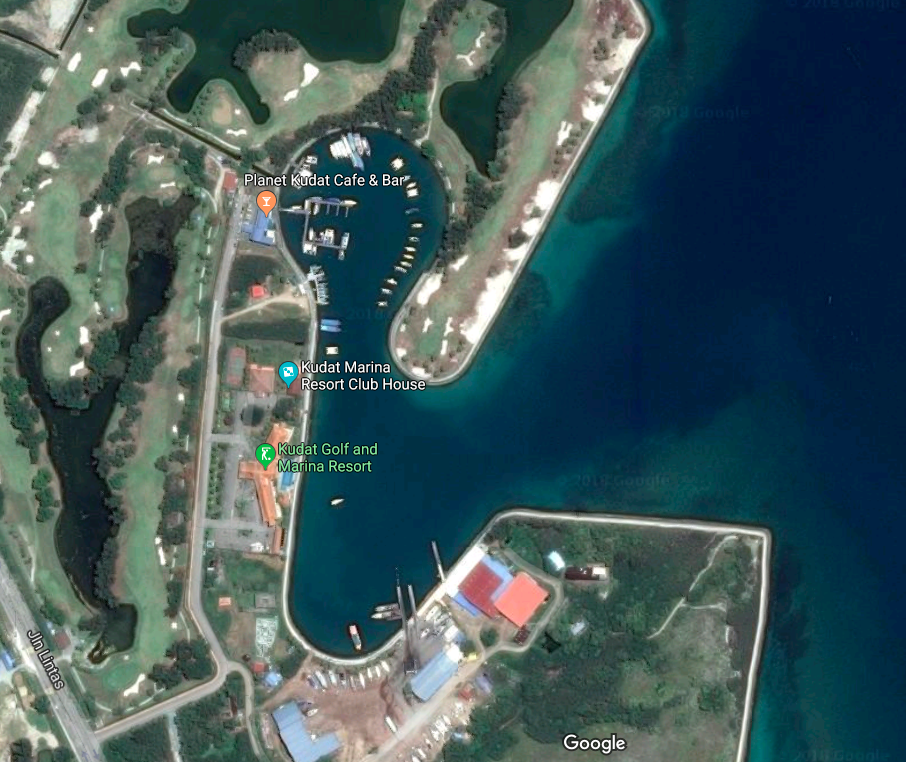 More rain, and eventually after lunch I got through to the yard who agreed to take me out in 15 minutes, which was great as I had originally booked a slot for tomorrow. All was going great, and I made it into the slings of the travel hoist without any effort at all, but I was worried that the rear sling was too far back and might be catching the rudder, I leaned over the wire lifeline in the cockpit to see if I could see it, but couldn’t, I leaned more, and further out when I suddenly find myself doing a somersault over the side of the boat and into the water, left hand immediately goes to left pocket, and sure enough my iPhone is there, bugger! looking up I can see the snapped life line dangling, I pull myself up using it, then notice both the lifelines are in the water. I have about ten people from the yard all looking down at me now. I have fallen off pontoons more than once in my life, but I think this is the first time I ever fell off a boat. How embarrassing. I had to swim around to the stern of the boat and climb back on board using the monitor wind steering frame. Then I have to act casual and make out like this is standard operating procedure for Brits arriving at a new port 🙂
More rain, and eventually after lunch I got through to the yard who agreed to take me out in 15 minutes, which was great as I had originally booked a slot for tomorrow. All was going great, and I made it into the slings of the travel hoist without any effort at all, but I was worried that the rear sling was too far back and might be catching the rudder, I leaned over the wire lifeline in the cockpit to see if I could see it, but couldn’t, I leaned more, and further out when I suddenly find myself doing a somersault over the side of the boat and into the water, left hand immediately goes to left pocket, and sure enough my iPhone is there, bugger! looking up I can see the snapped life line dangling, I pull myself up using it, then notice both the lifelines are in the water. I have about ten people from the yard all looking down at me now. I have fallen off pontoons more than once in my life, but I think this is the first time I ever fell off a boat. How embarrassing. I had to swim around to the stern of the boat and climb back on board using the monitor wind steering frame. Then I have to act casual and make out like this is standard operating procedure for Brits arriving at a new port 🙂
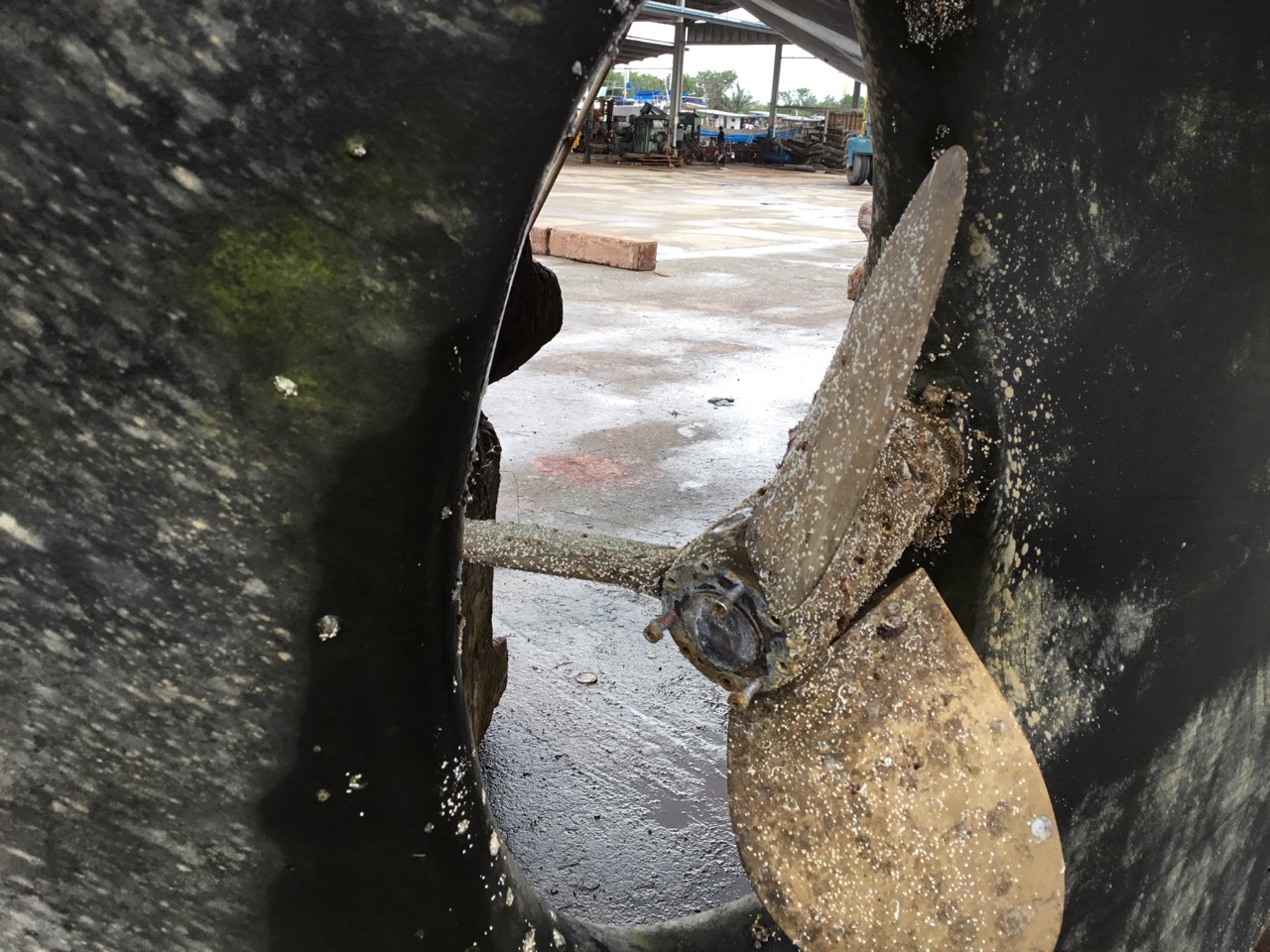
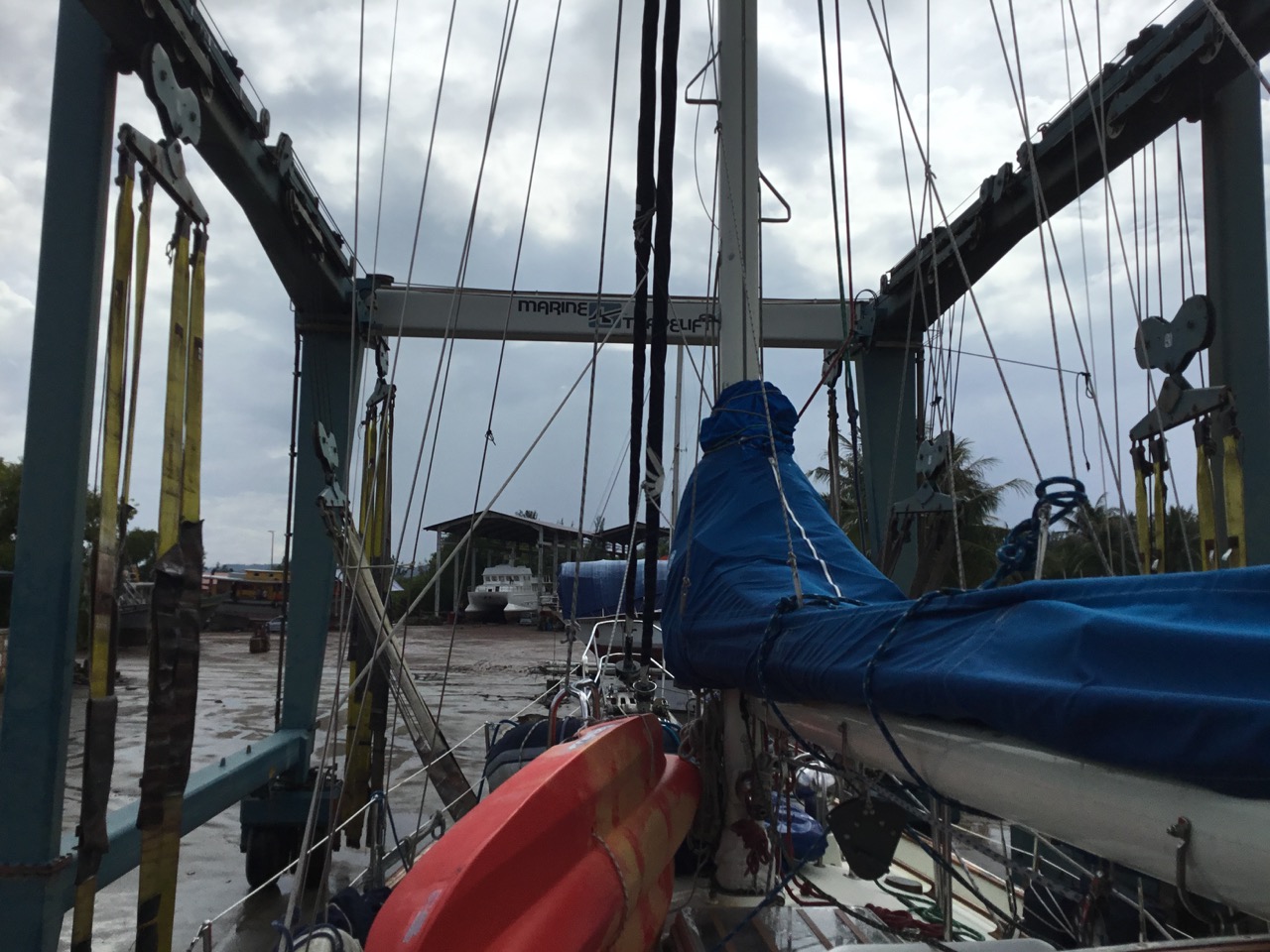



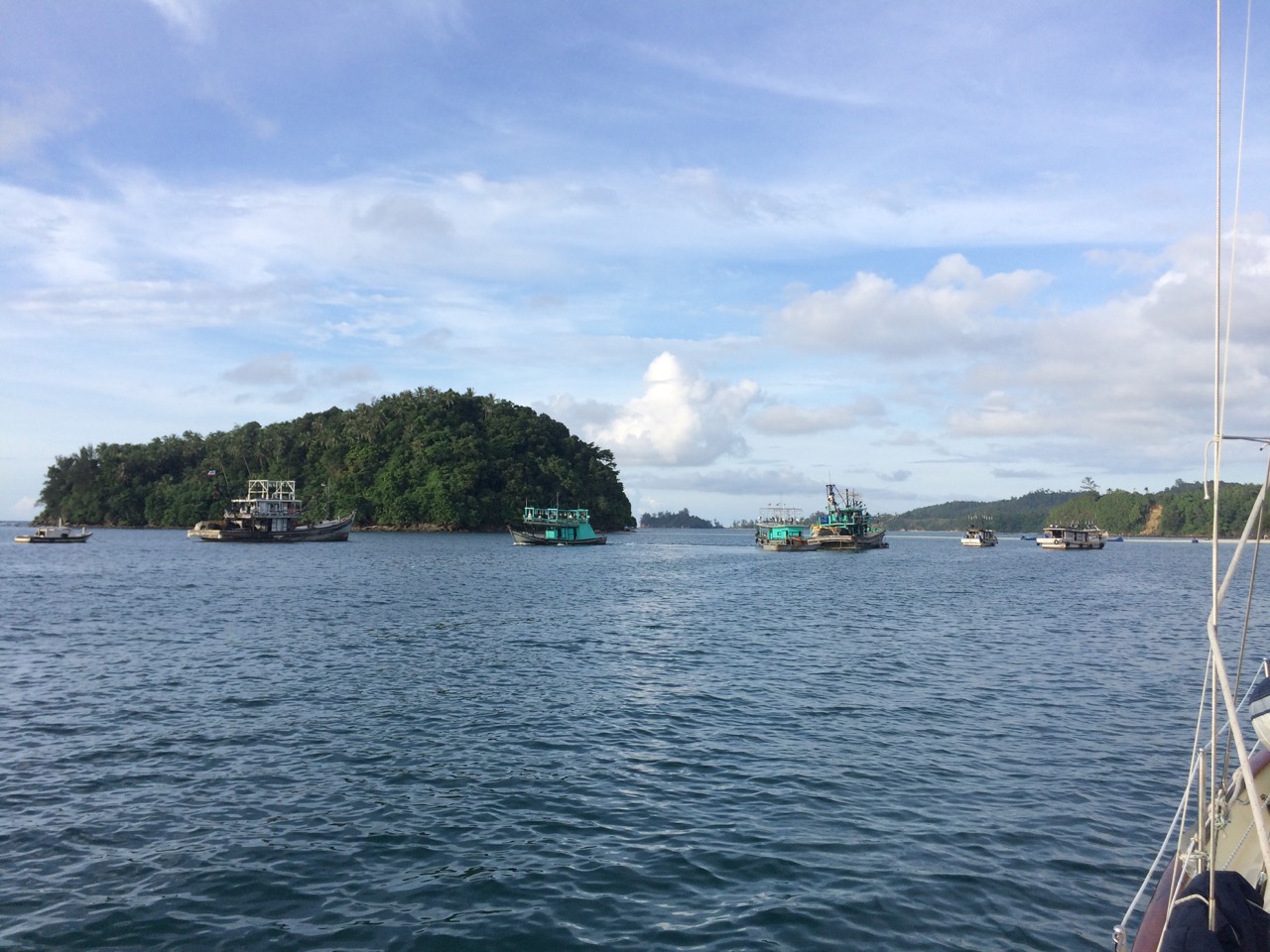
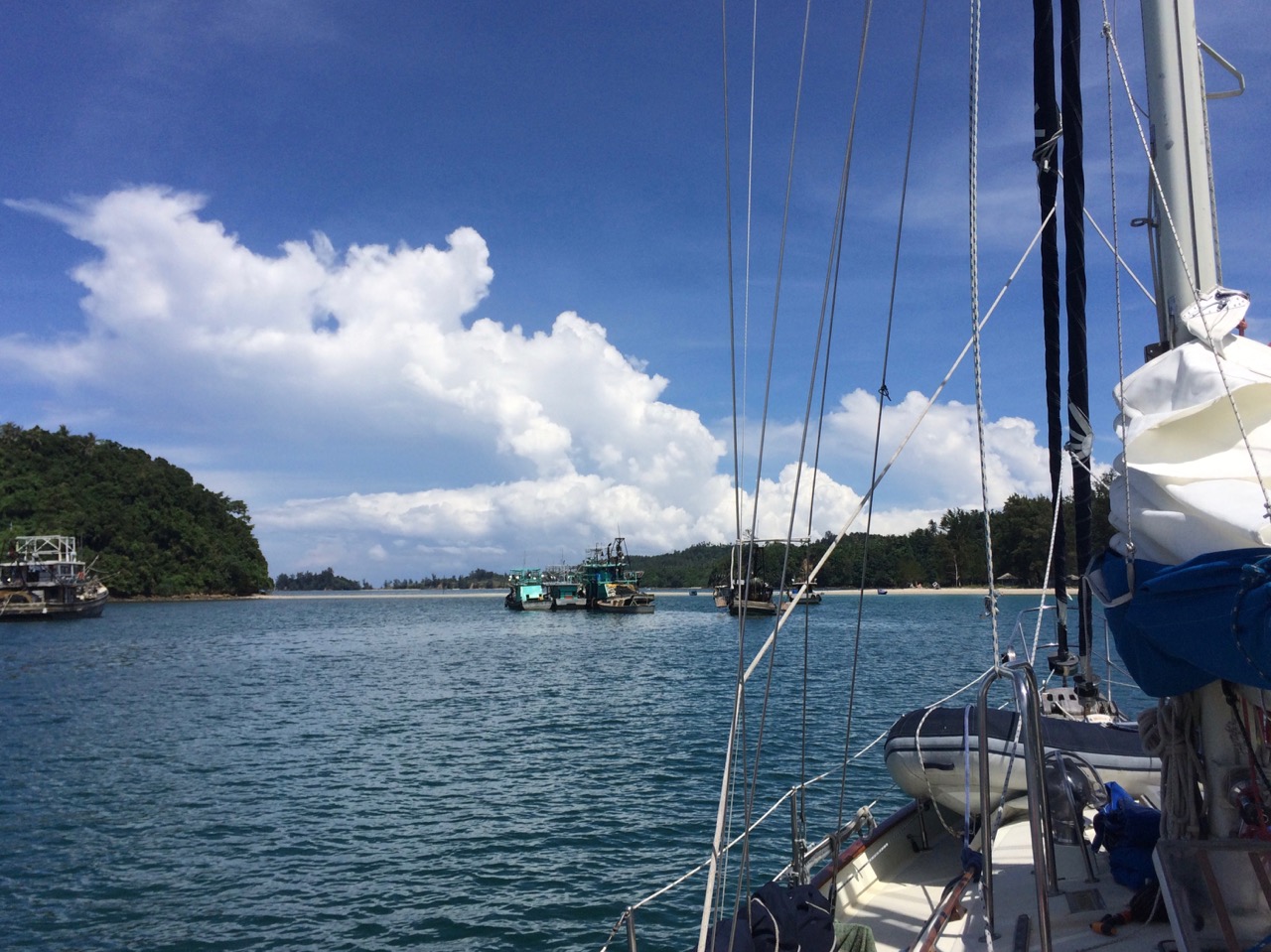
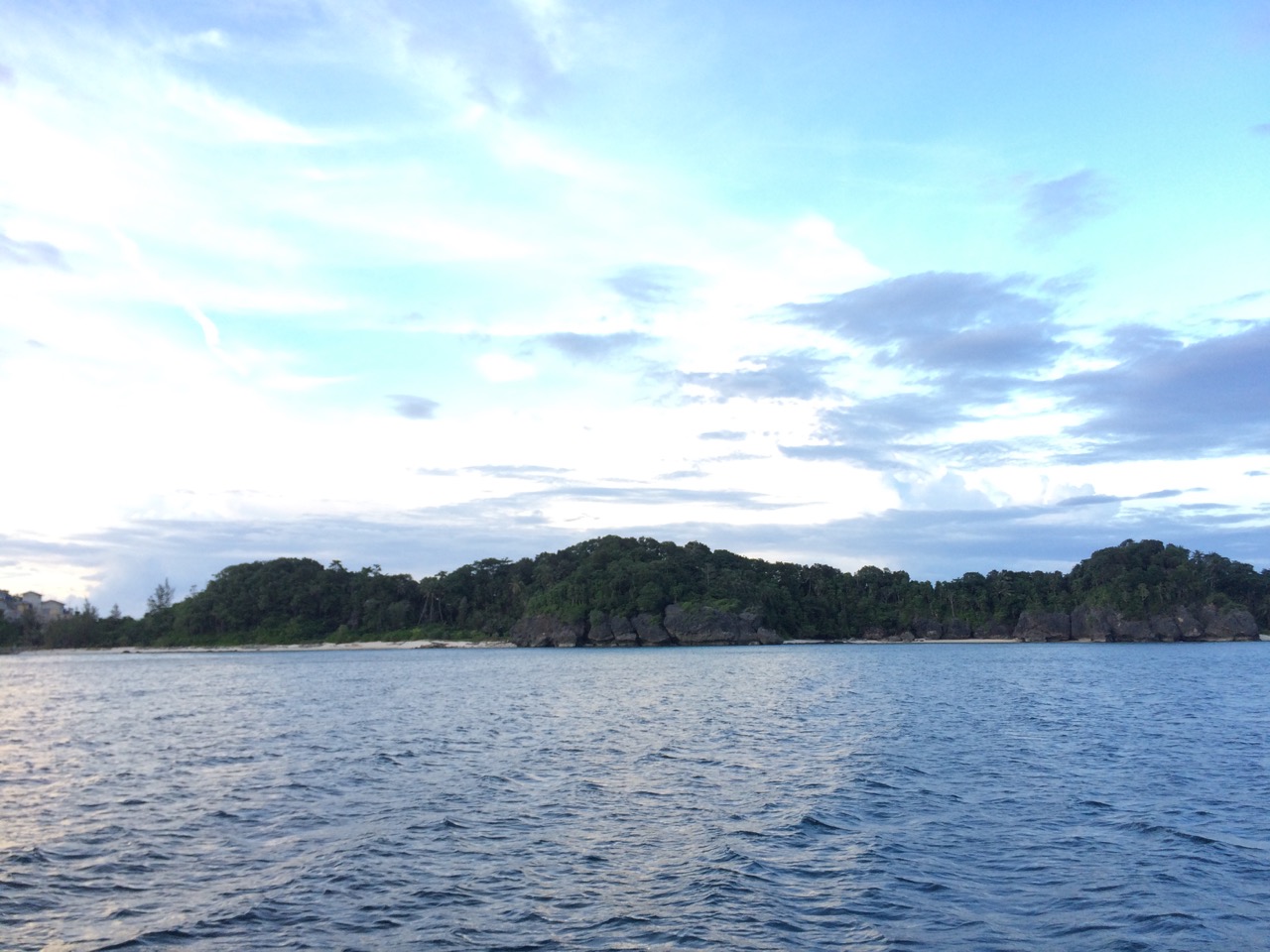 It was a bit of a slog, I left at 7am and arrived at 17:00 and spent 30 minutes trying to find a spot to anchor.
It was a bit of a slog, I left at 7am and arrived at 17:00 and spent 30 minutes trying to find a spot to anchor.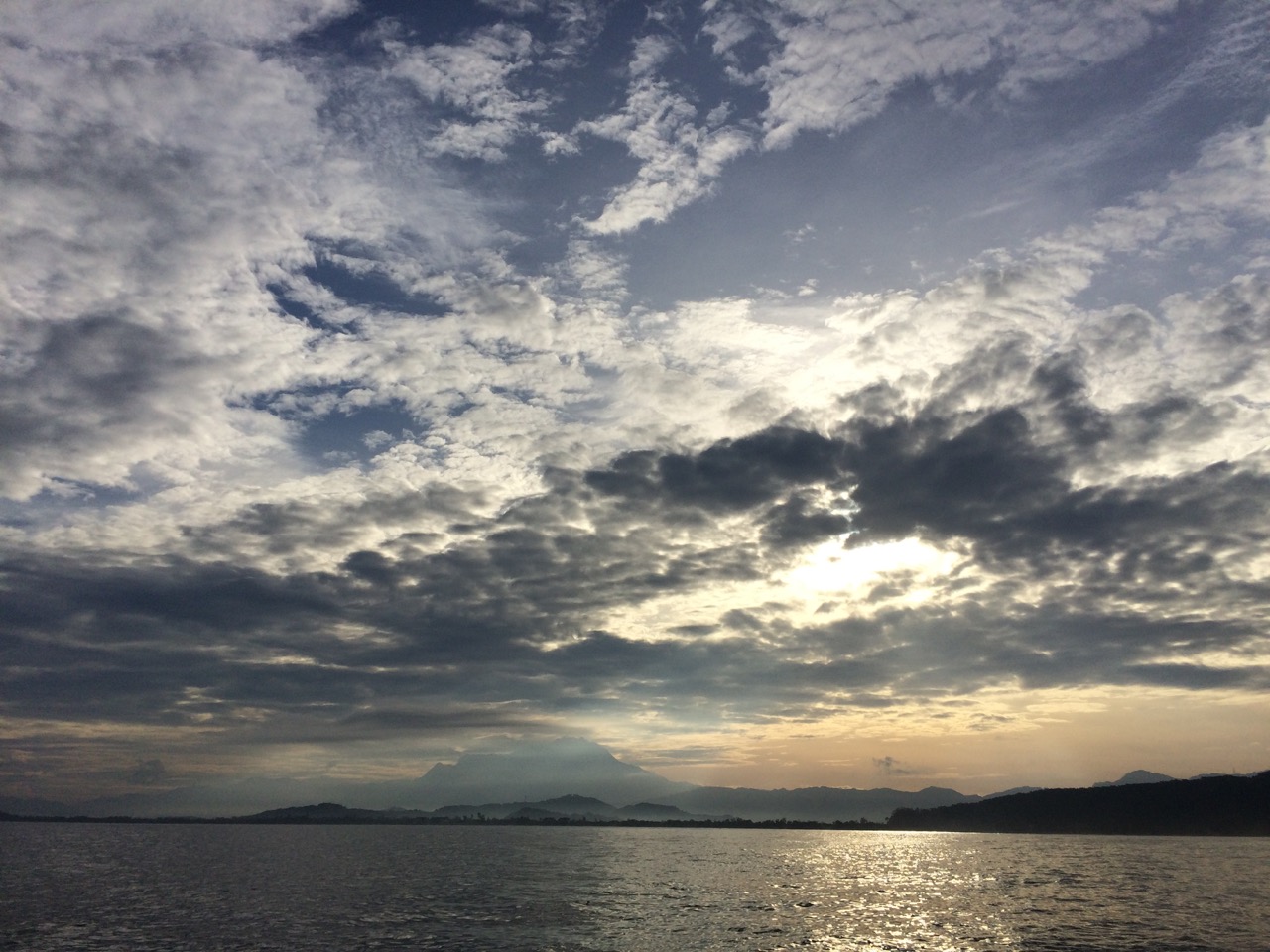 It was quite rough later on during the passage and I couldn’t motor then as the wind and waves were on the nose and slowed me to just 2 knots, so I had to tack back and forth for 4 hours, mostly steering by hand. It was while the boat was heeling heavily, and was racing along with a double reefed main and just the staysail, that I began to doubt the wind speed indicator, that was showing 10 knots of wind, and in fact, when I thought about it, it hadn’t been above 10 knots for a very long time. I expect it’s faulty and will have to be replaced.
It was quite rough later on during the passage and I couldn’t motor then as the wind and waves were on the nose and slowed me to just 2 knots, so I had to tack back and forth for 4 hours, mostly steering by hand. It was while the boat was heeling heavily, and was racing along with a double reefed main and just the staysail, that I began to doubt the wind speed indicator, that was showing 10 knots of wind, and in fact, when I thought about it, it hadn’t been above 10 knots for a very long time. I expect it’s faulty and will have to be replaced. You can see on the map below there are two islands, Besar and Kerchil, which means big and small. I went for the small one as it was recommended to anchor south of the lighthouse, however there isn’t a lighthouse here anymore, did they mean the new radar station? You can see on the google map how the two islands sit on a big oval lump of rock,.Closer to the shore, its solid shallow coral. I have a sonar depth sensor which shows me the sea floor surface, and I can usually spot rocky areas, and eventually I found a very flat area, dropped the hook, and went about setting it in, it was looking good until I upped the revs to test it, then it dragged along rock, and quickly came to a stop. It’s dug in now, but is it under a rock, or worse has the chain wrapped around a rock? I quickly dived over the side with my snorkel, but the light had almost gone, and I couldn’t see much, but it did look mostly sandy there with a few rocky bits. We shall see tomorrow at 7am, when I try to leave.
You can see on the map below there are two islands, Besar and Kerchil, which means big and small. I went for the small one as it was recommended to anchor south of the lighthouse, however there isn’t a lighthouse here anymore, did they mean the new radar station? You can see on the google map how the two islands sit on a big oval lump of rock,.Closer to the shore, its solid shallow coral. I have a sonar depth sensor which shows me the sea floor surface, and I can usually spot rocky areas, and eventually I found a very flat area, dropped the hook, and went about setting it in, it was looking good until I upped the revs to test it, then it dragged along rock, and quickly came to a stop. It’s dug in now, but is it under a rock, or worse has the chain wrapped around a rock? I quickly dived over the side with my snorkel, but the light had almost gone, and I couldn’t see much, but it did look mostly sandy there with a few rocky bits. We shall see tomorrow at 7am, when I try to leave.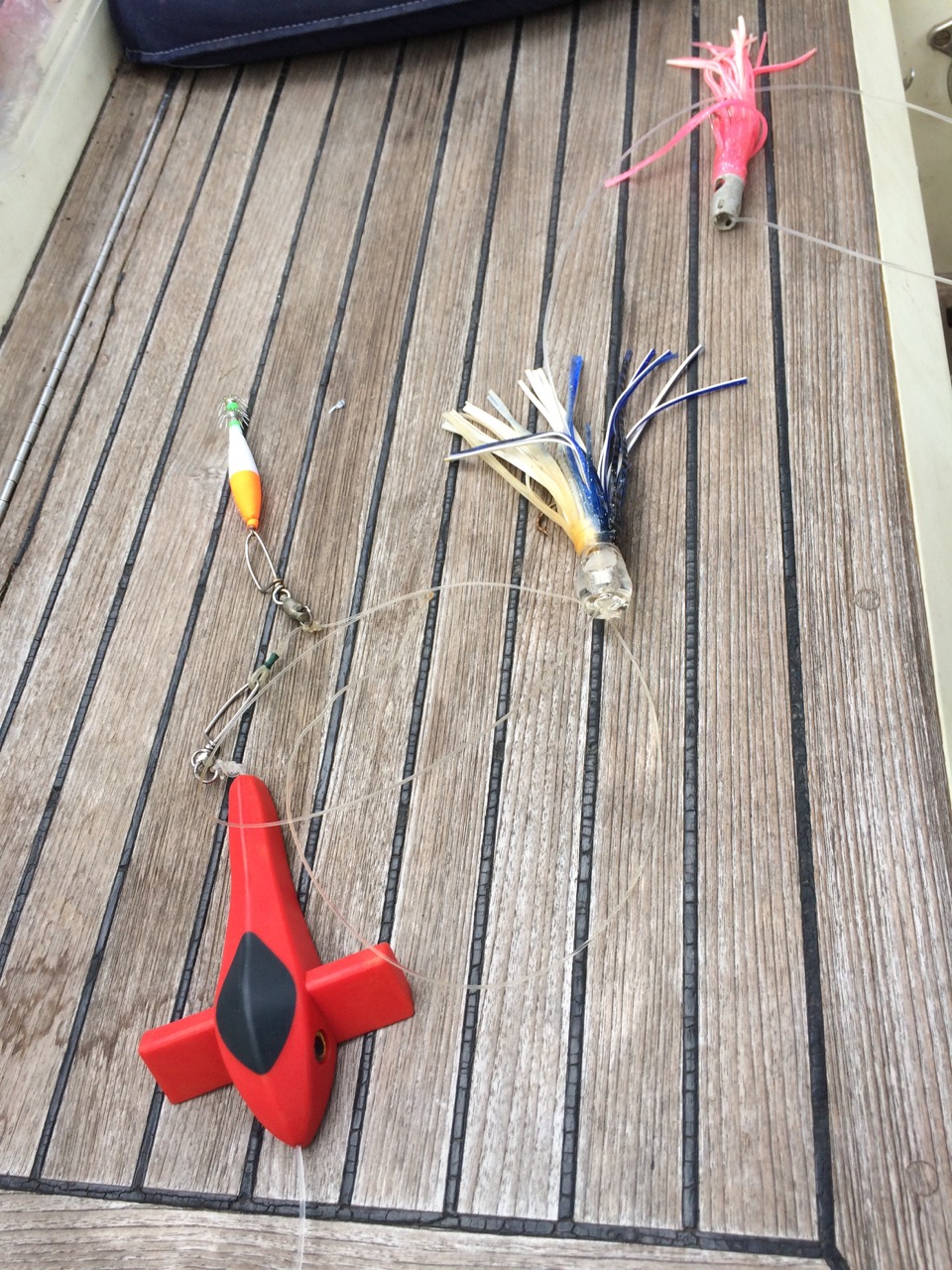 As you can see I have an assortment of plastic fish, but now the secret weapon is being deployed…
As you can see I have an assortment of plastic fish, but now the secret weapon is being deployed…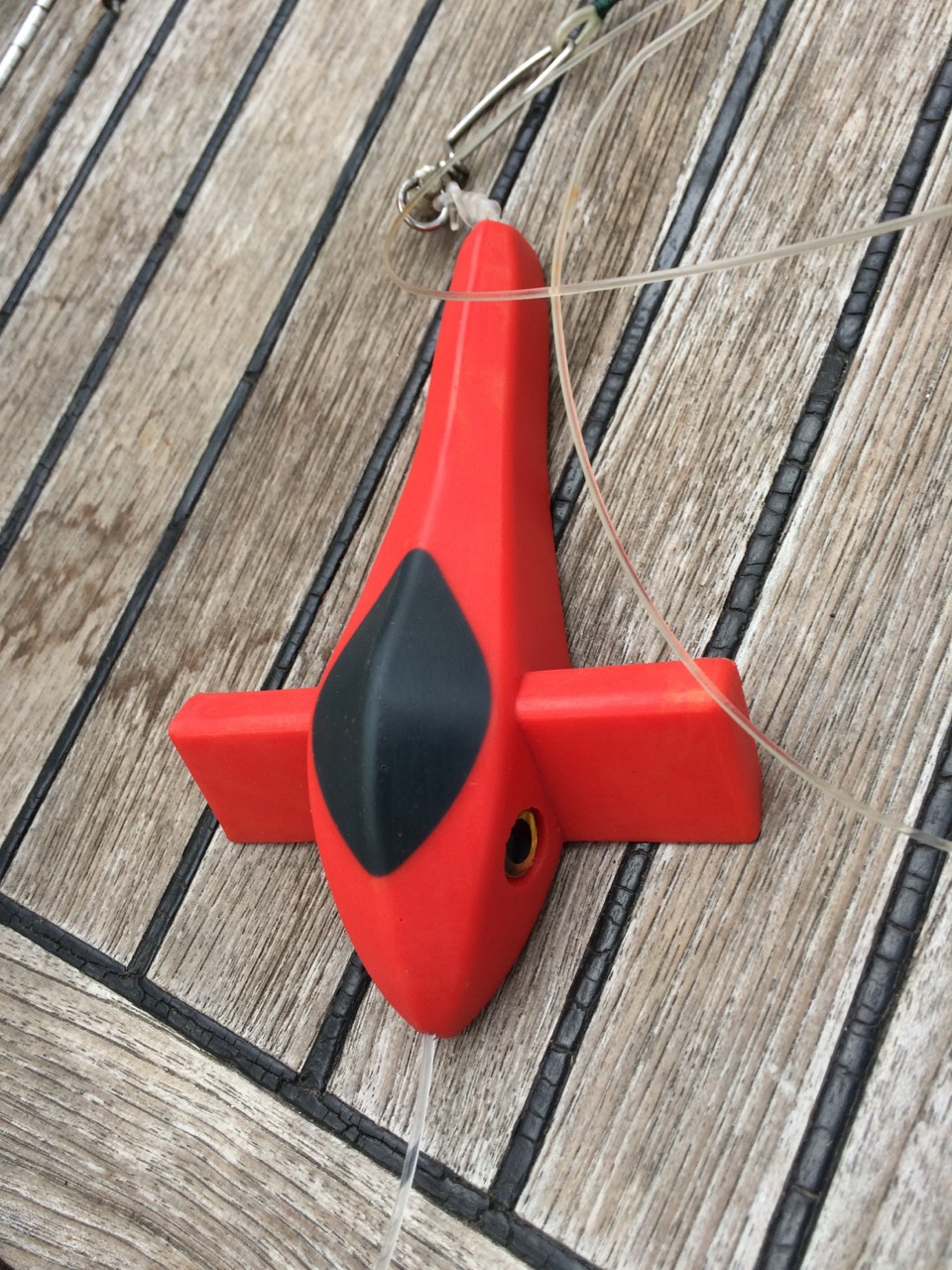 The aeroplane! I have been assured this will do the trick. I have three of them, so no more buying fish for me.
The aeroplane! I have been assured this will do the trick. I have three of them, so no more buying fish for me.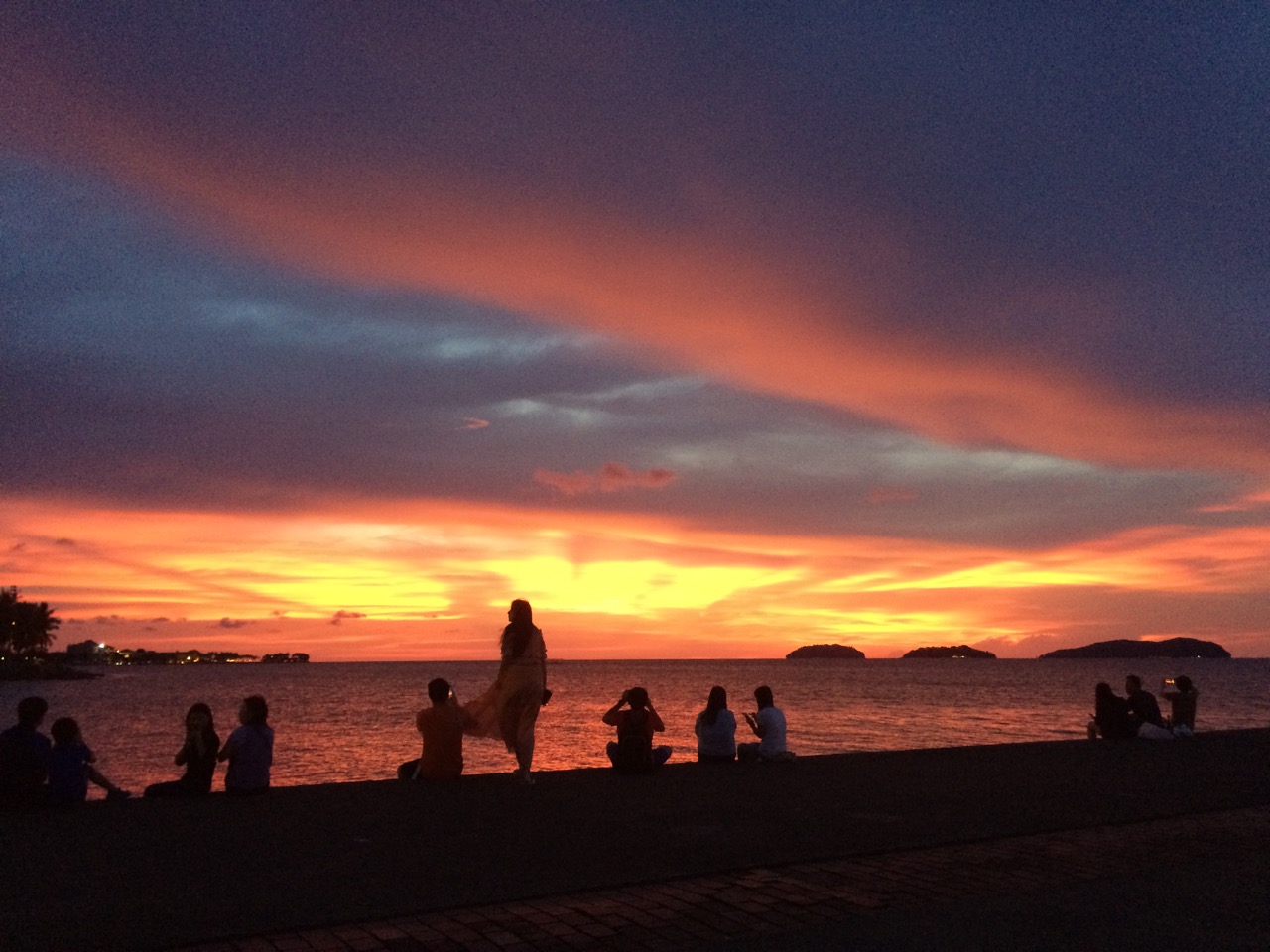

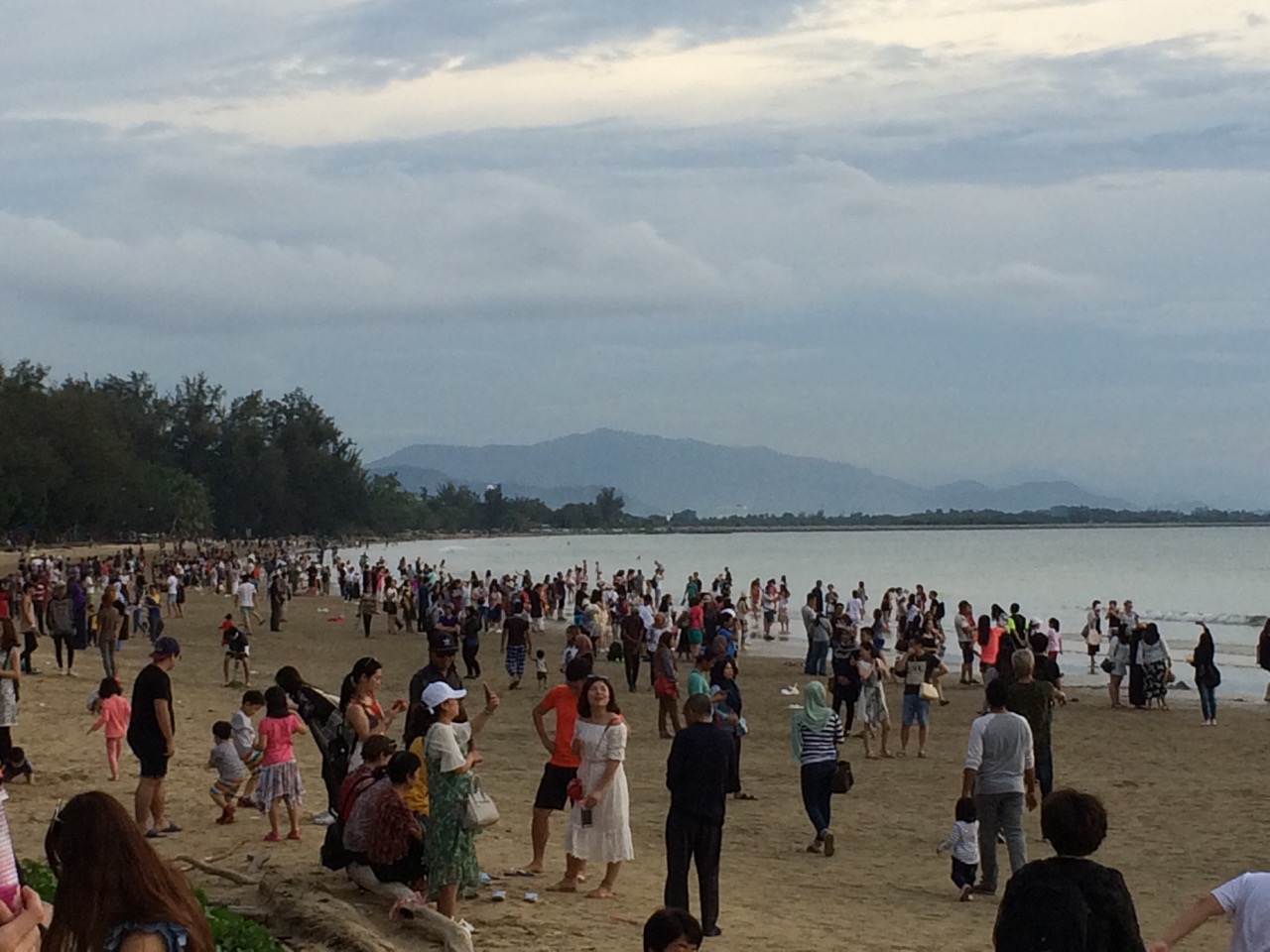 I wondered if many of them come from inland China and hadn’t seen a beach before. I noticed new arrivals here at the resort often get quite excited when they see the fish swimming in the marina!
I wondered if many of them come from inland China and hadn’t seen a beach before. I noticed new arrivals here at the resort often get quite excited when they see the fish swimming in the marina!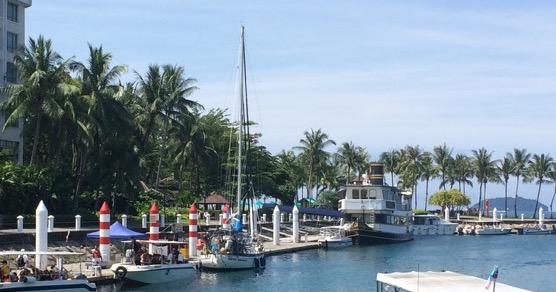 Not so good if the dock is on the starboard side. As soon as I fuelled up I left for the short 3 hour journey to my current location, in a little sandy cove just NE of the main port of KK
Not so good if the dock is on the starboard side. As soon as I fuelled up I left for the short 3 hour journey to my current location, in a little sandy cove just NE of the main port of KK The islands look lovely, but crowded with fast day-tripper boats razzing around everywhere.
The islands look lovely, but crowded with fast day-tripper boats razzing around everywhere.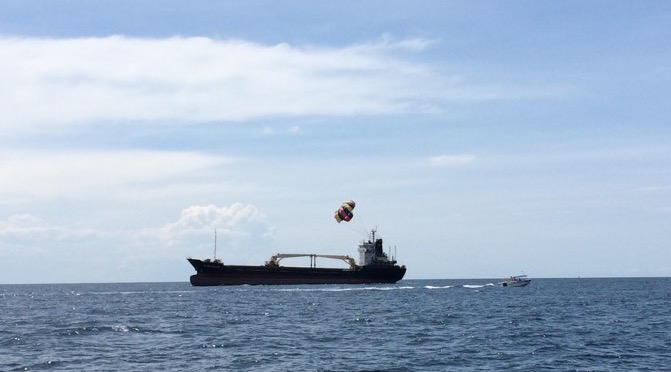 One cut right across my bow, and I wondered what might happen should he misjudge things and the poor lass in the parachute found her line wrapped around my mast.
One cut right across my bow, and I wondered what might happen should he misjudge things and the poor lass in the parachute found her line wrapped around my mast. 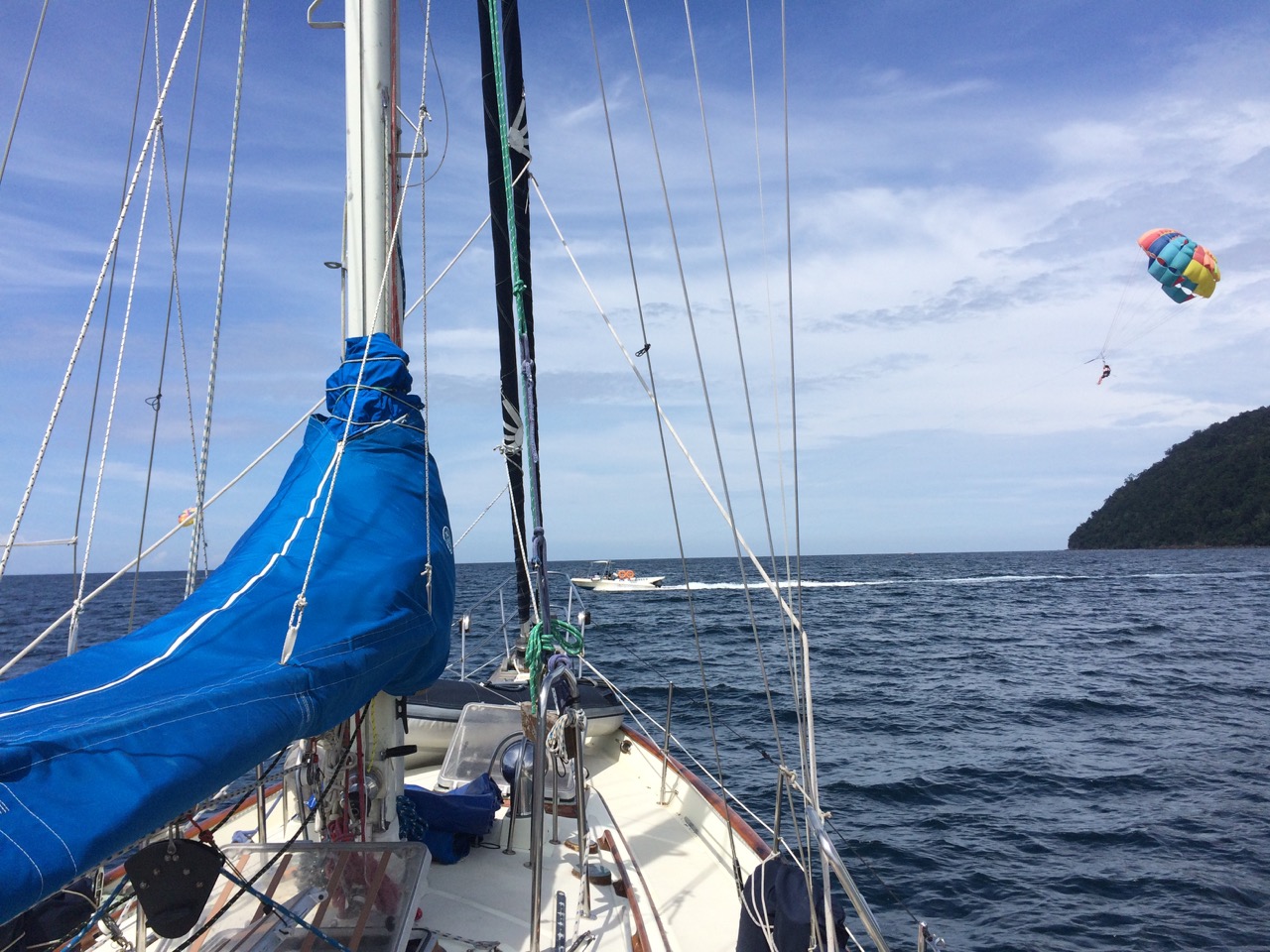 I don’t think we covered that on the RYA Yacht Master course.
I don’t think we covered that on the RYA Yacht Master course. My conclusion so far is that KK needs to get some better planners involved quickly, large chunks of the city are marooned by concrete constructions on islands that are only accessible by road, pedestrians are constantly trekking down central reservations and walking across motorway like roads to just get home.
My conclusion so far is that KK needs to get some better planners involved quickly, large chunks of the city are marooned by concrete constructions on islands that are only accessible by road, pedestrians are constantly trekking down central reservations and walking across motorway like roads to just get home.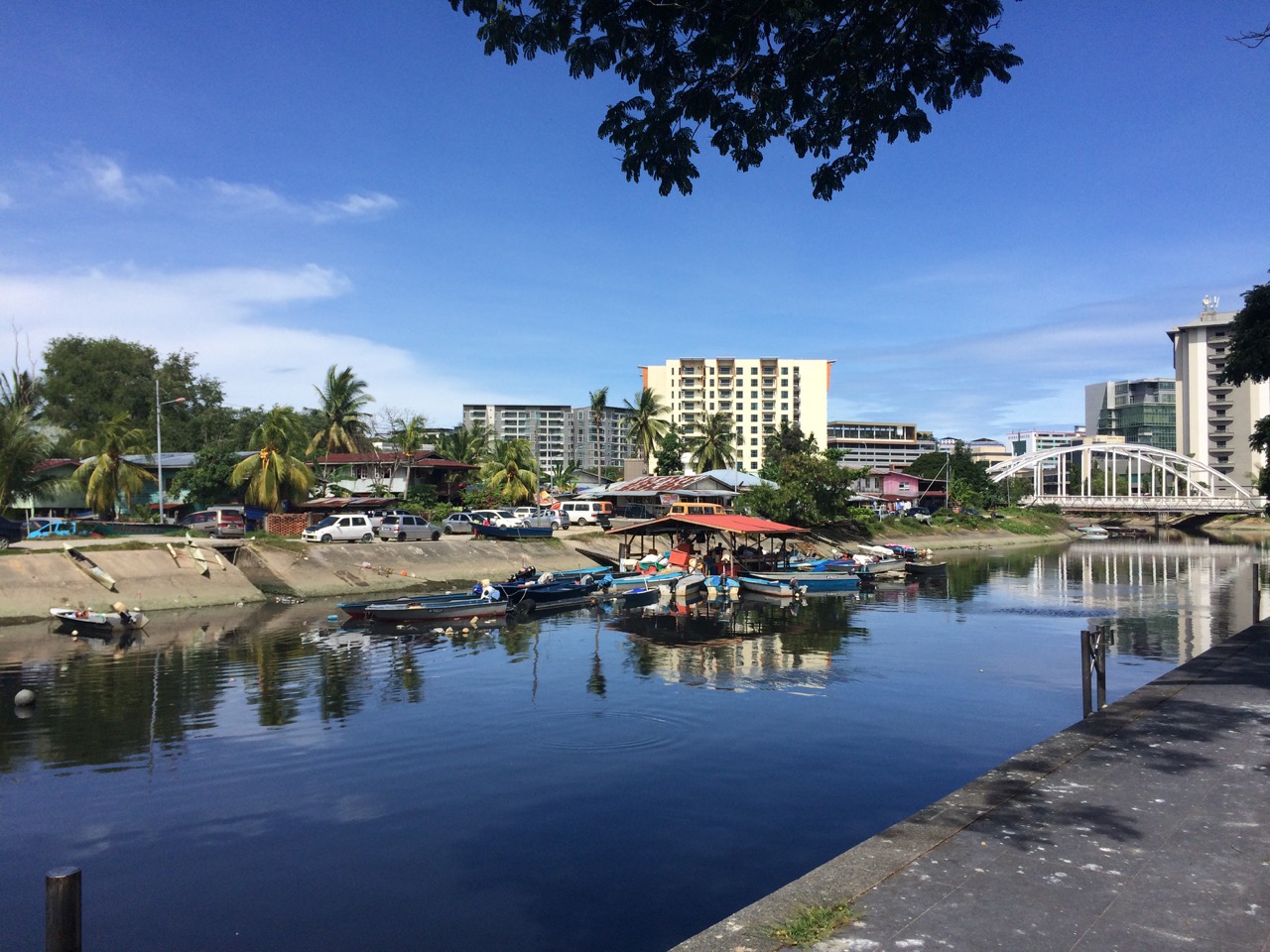
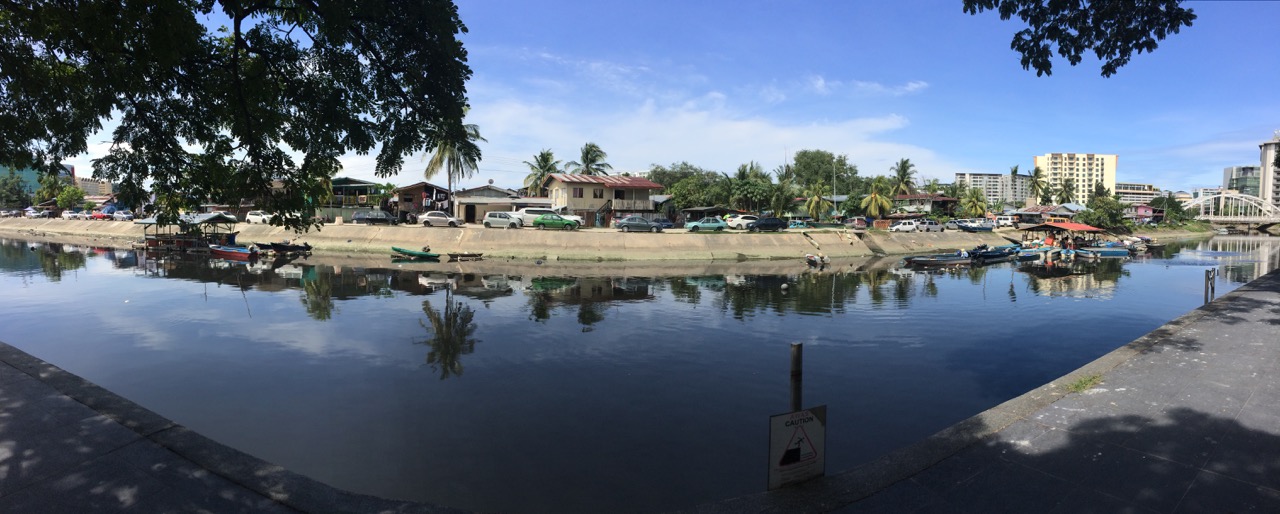 This river has been gentrified, in as much as there’s a cycle path, footpath and seating along its length, and elsewhere, say in Singapore, this would be thriving with visitors. However here,the paving is breaking up, it’s deserted and windswept, not very inviting.
This river has been gentrified, in as much as there’s a cycle path, footpath and seating along its length, and elsewhere, say in Singapore, this would be thriving with visitors. However here,the paving is breaking up, it’s deserted and windswept, not very inviting.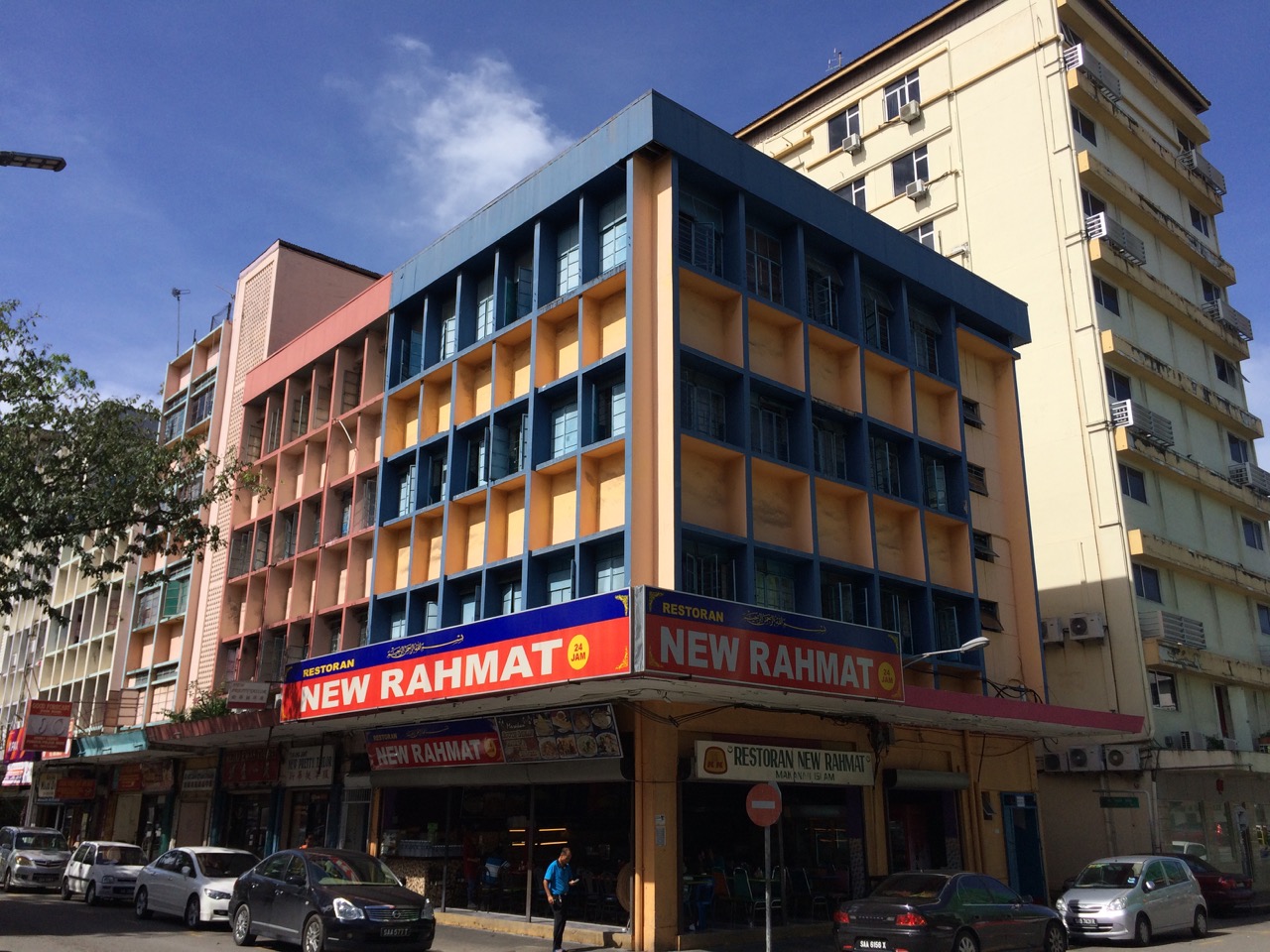
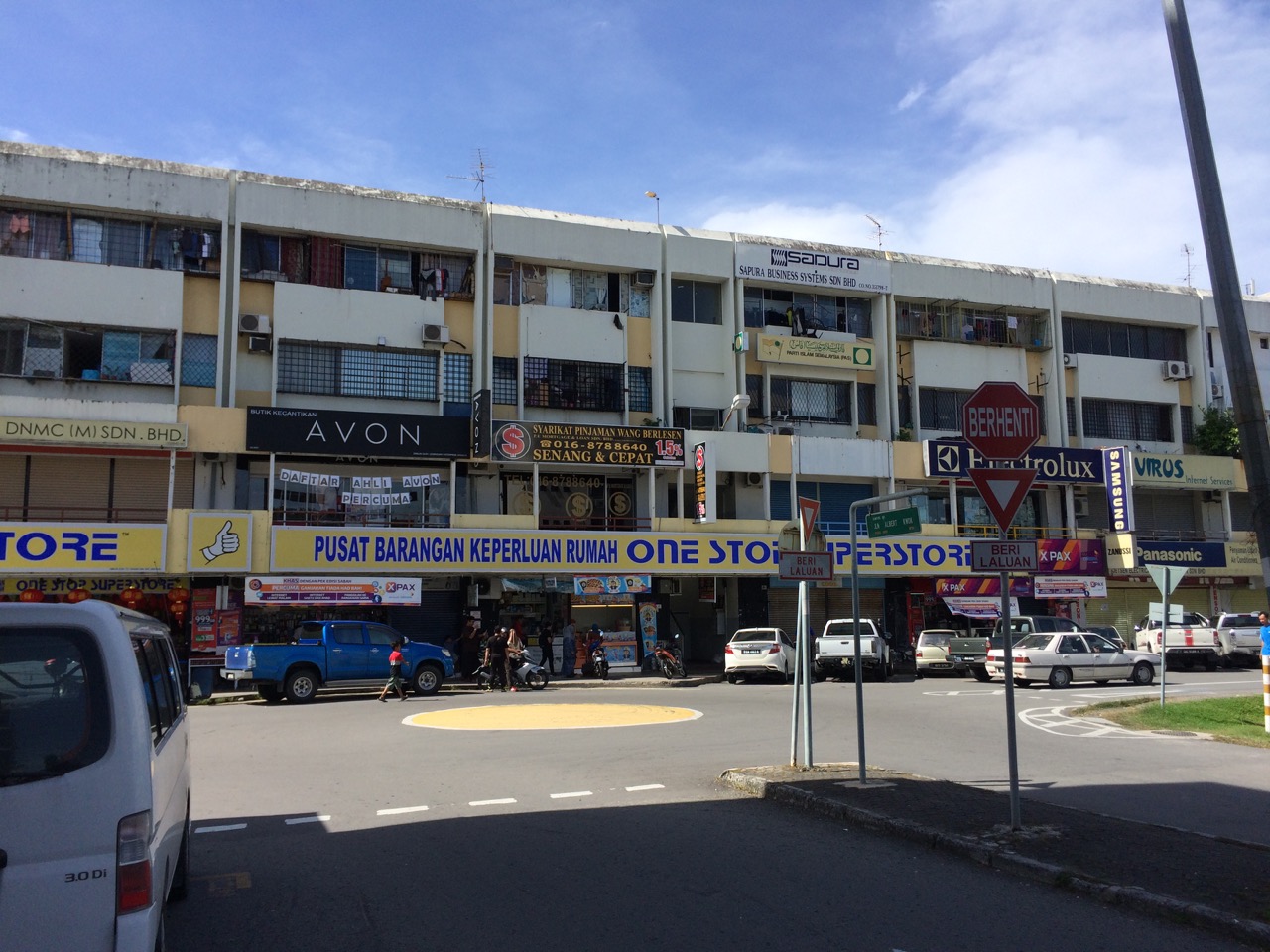
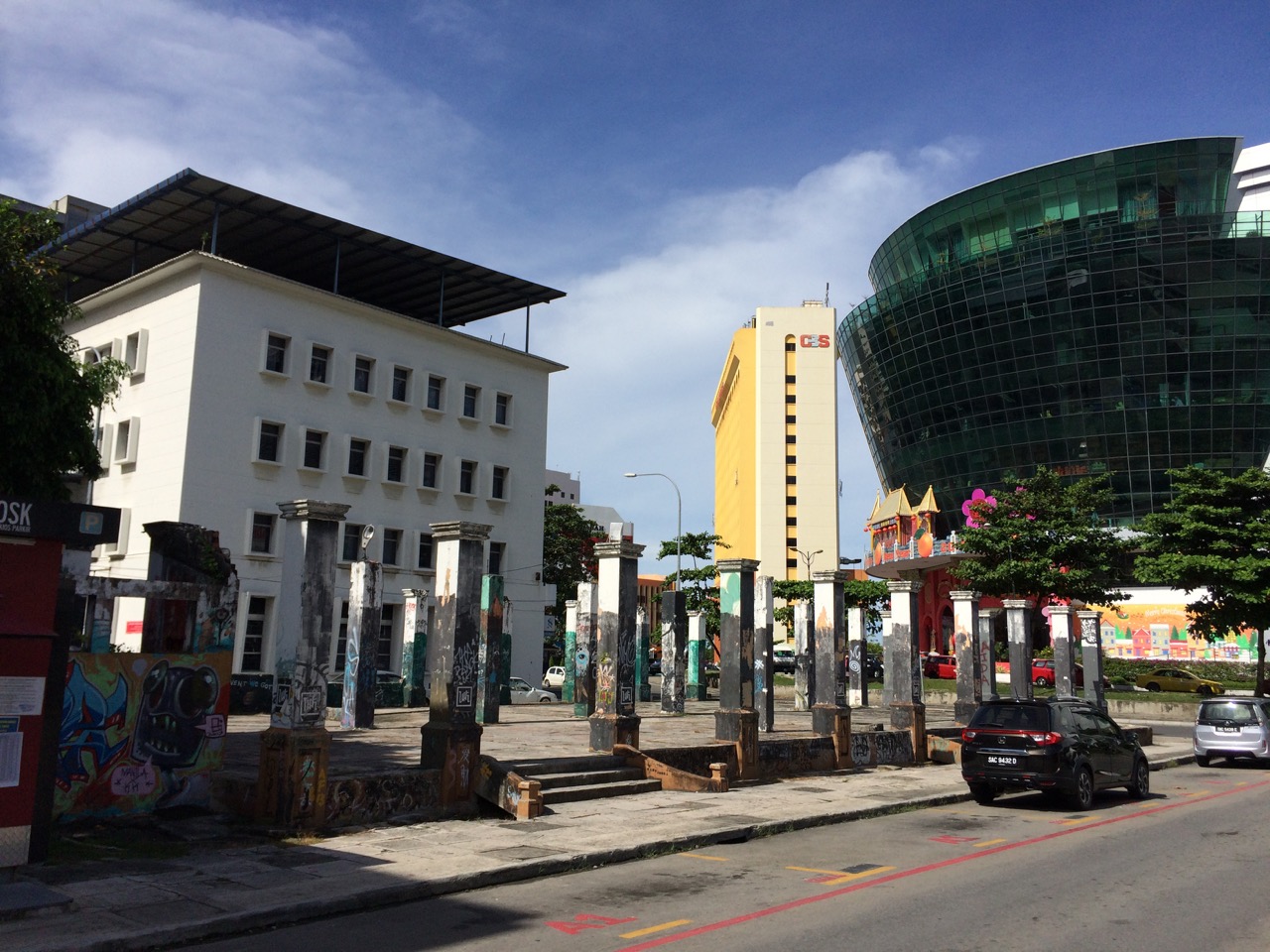 Still eating seems to be the main activity here, and this restaurant says it all.
Still eating seems to be the main activity here, and this restaurant says it all.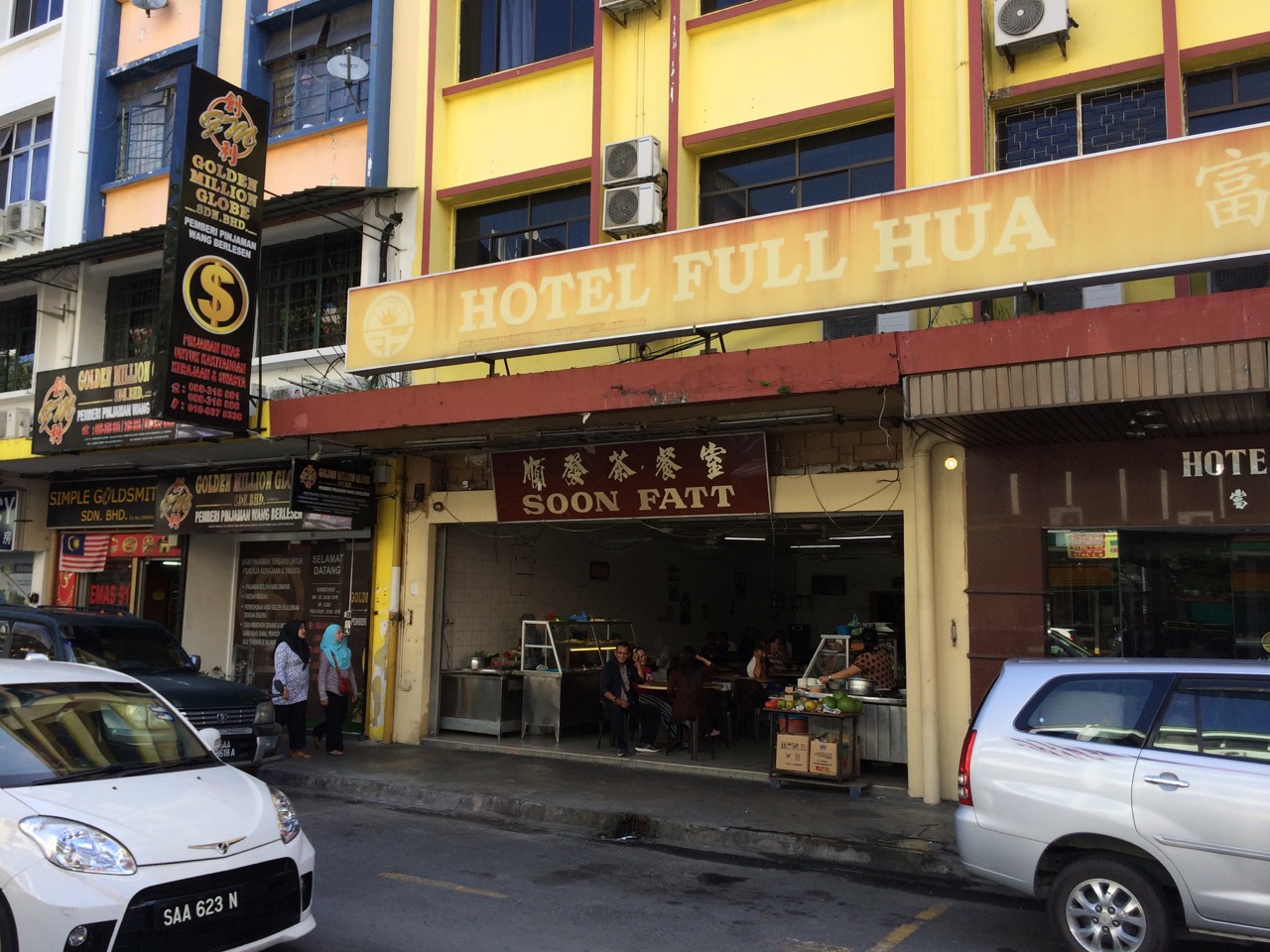
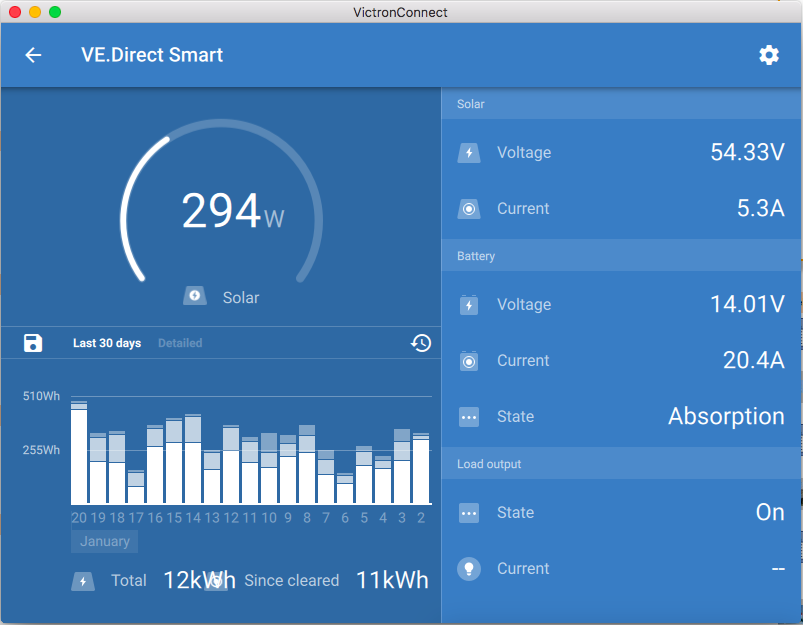
 The quality is more than enough, the streaming works extremely well, so we can play music from our iPhones, Macbook, watch TV on the computer with lovely sound from the boats speakers. It also is a decent radio, but sadly Kathy doesn’t care much for local FM radio. Best of all it’s fully redundant and capable of surviving a total failure with little disruption to the music, as I bought a second one at christmas as a spare!
The quality is more than enough, the streaming works extremely well, so we can play music from our iPhones, Macbook, watch TV on the computer with lovely sound from the boats speakers. It also is a decent radio, but sadly Kathy doesn’t care much for local FM radio. Best of all it’s fully redundant and capable of surviving a total failure with little disruption to the music, as I bought a second one at christmas as a spare!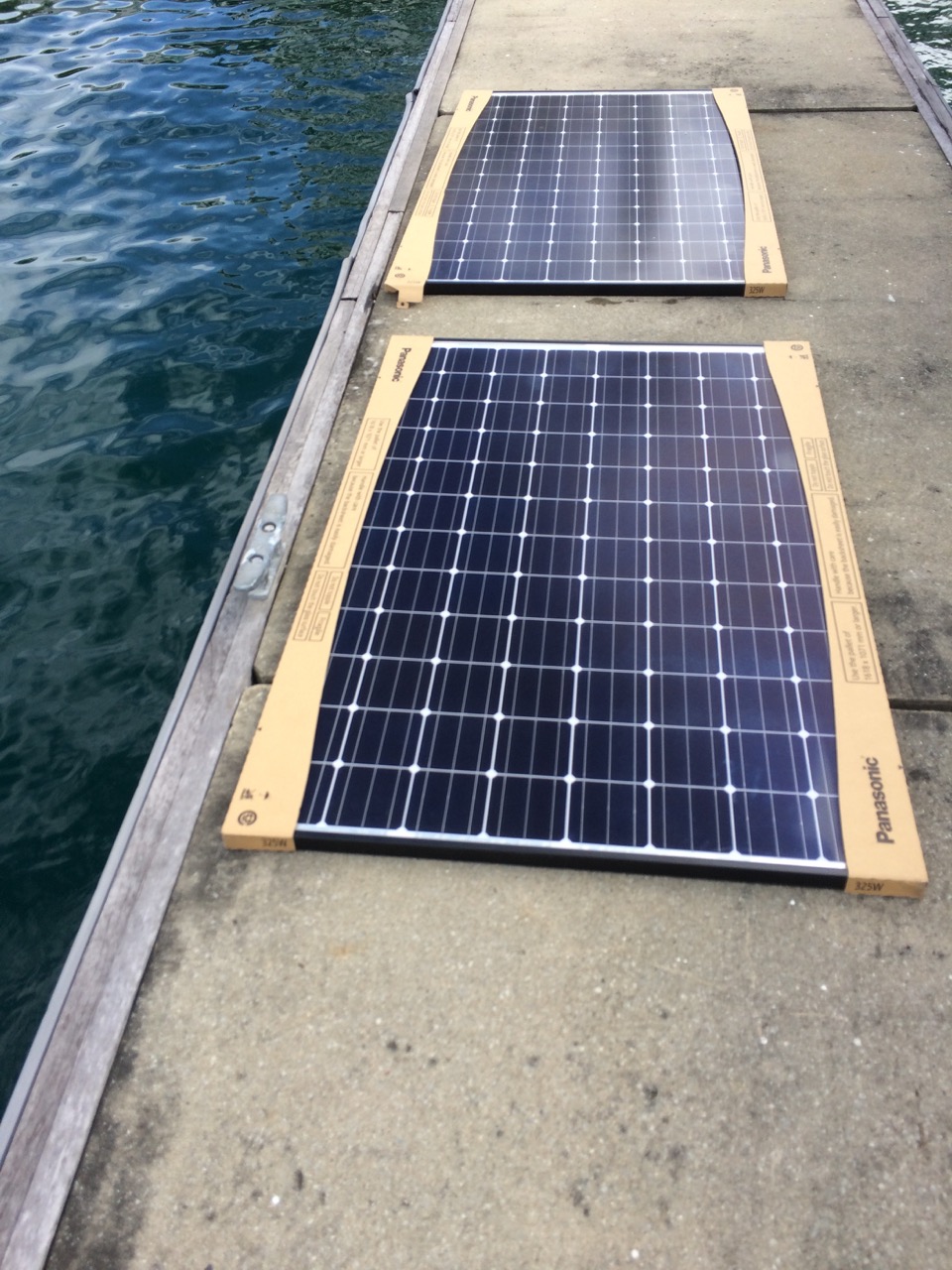
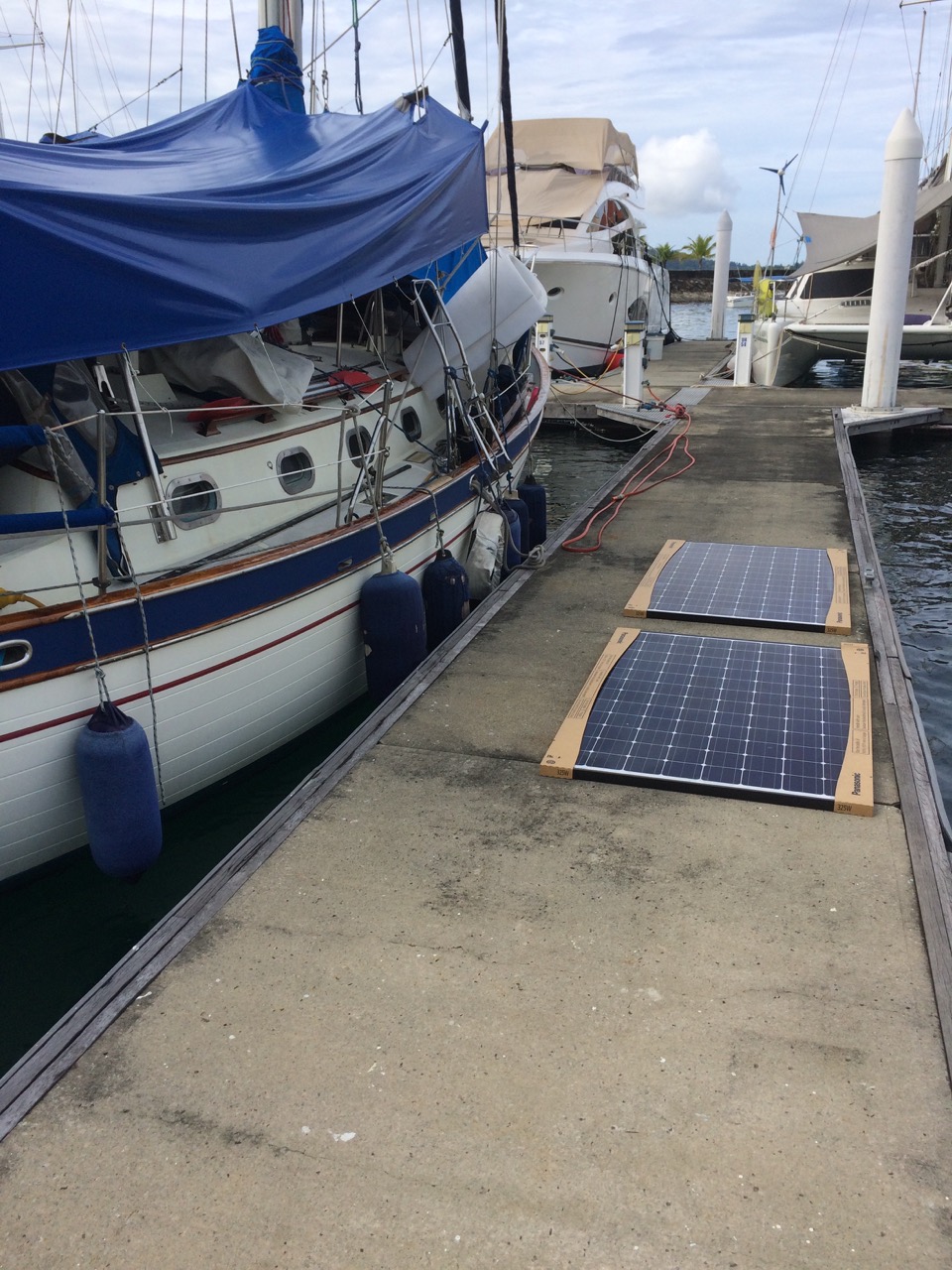
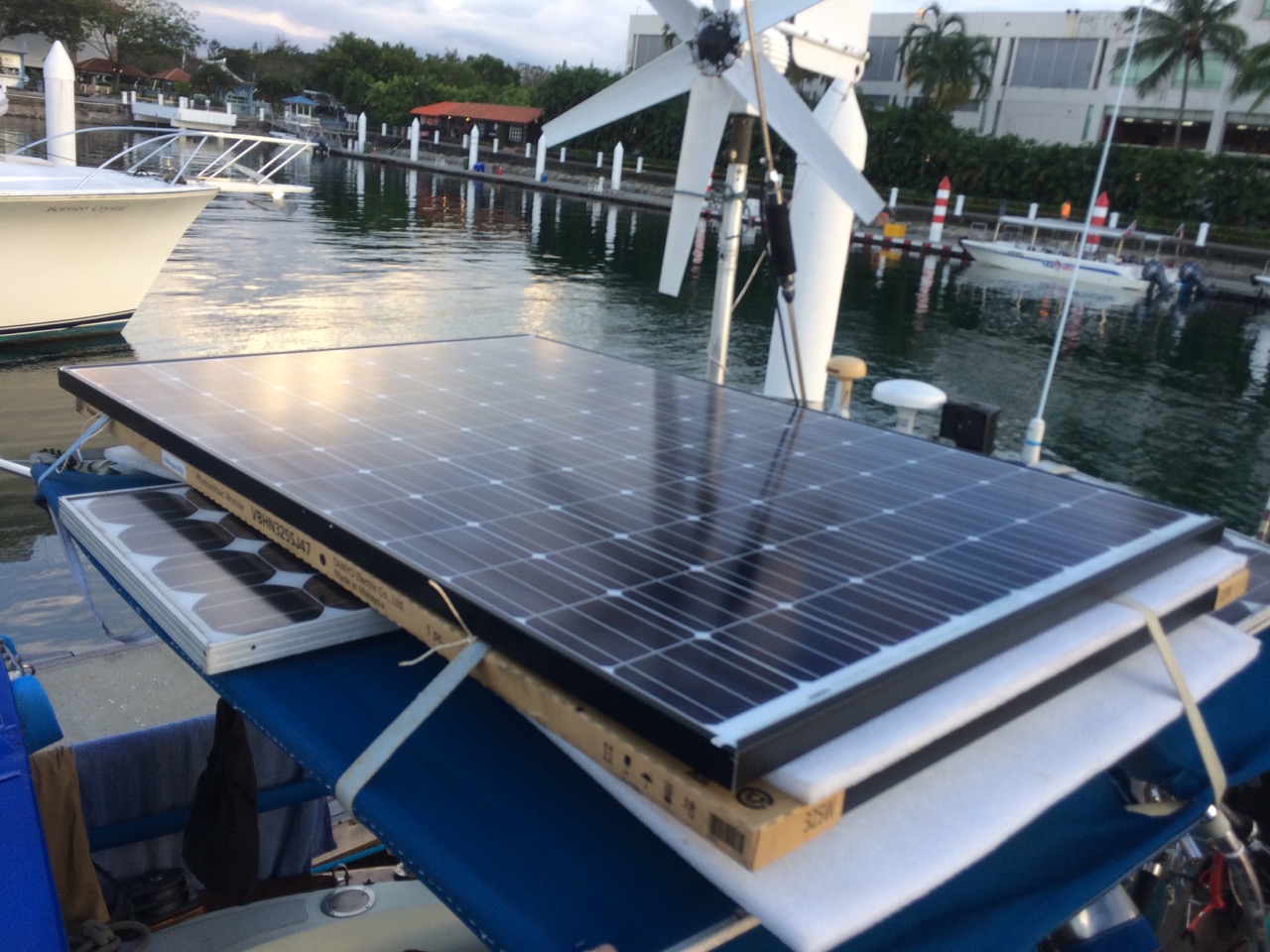 However this meant the existing panels wouldn’t work on the trip to Kudat, and I need the power, so I decided to put the top panel facing up and wire it in temporarily. It was now getting late and I was keen to finish the wiring while the sun shone so I could see if they generated any power. At this point a neighbour arrived for a chat, this delayed me, but I was now thinking, they are designed to outperform other panels in low light, so this would test them, the neighbour left and I continued the job, rushing below, only to find 0V from the panel. I knew the connections were good, but on inspection I had wired it up to the wrong cable, so more work, the sun is now just above the horizon. rushing below I managed to see the panel generate 1W, which is a start, thats about 0.3% of it’s output. Oh well, tomorrow’s another day…
However this meant the existing panels wouldn’t work on the trip to Kudat, and I need the power, so I decided to put the top panel facing up and wire it in temporarily. It was now getting late and I was keen to finish the wiring while the sun shone so I could see if they generated any power. At this point a neighbour arrived for a chat, this delayed me, but I was now thinking, they are designed to outperform other panels in low light, so this would test them, the neighbour left and I continued the job, rushing below, only to find 0V from the panel. I knew the connections were good, but on inspection I had wired it up to the wrong cable, so more work, the sun is now just above the horizon. rushing below I managed to see the panel generate 1W, which is a start, thats about 0.3% of it’s output. Oh well, tomorrow’s another day…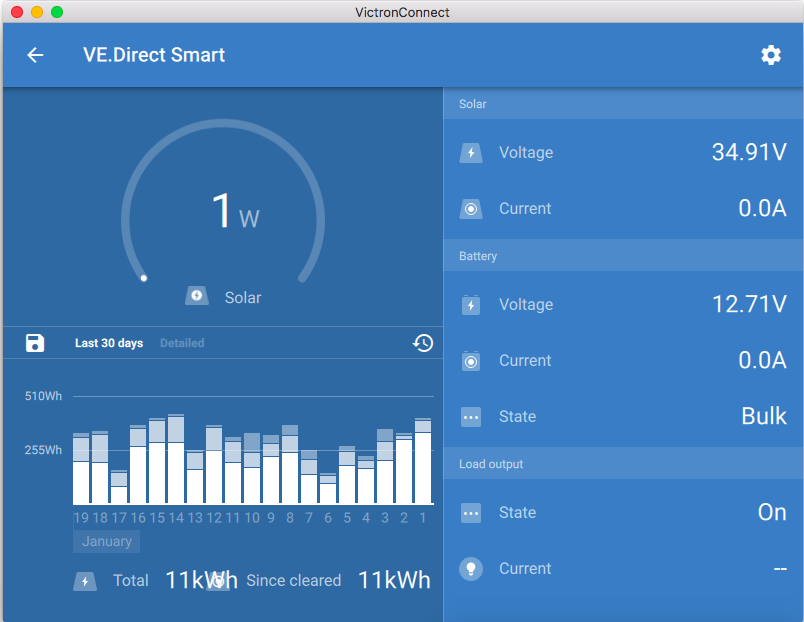
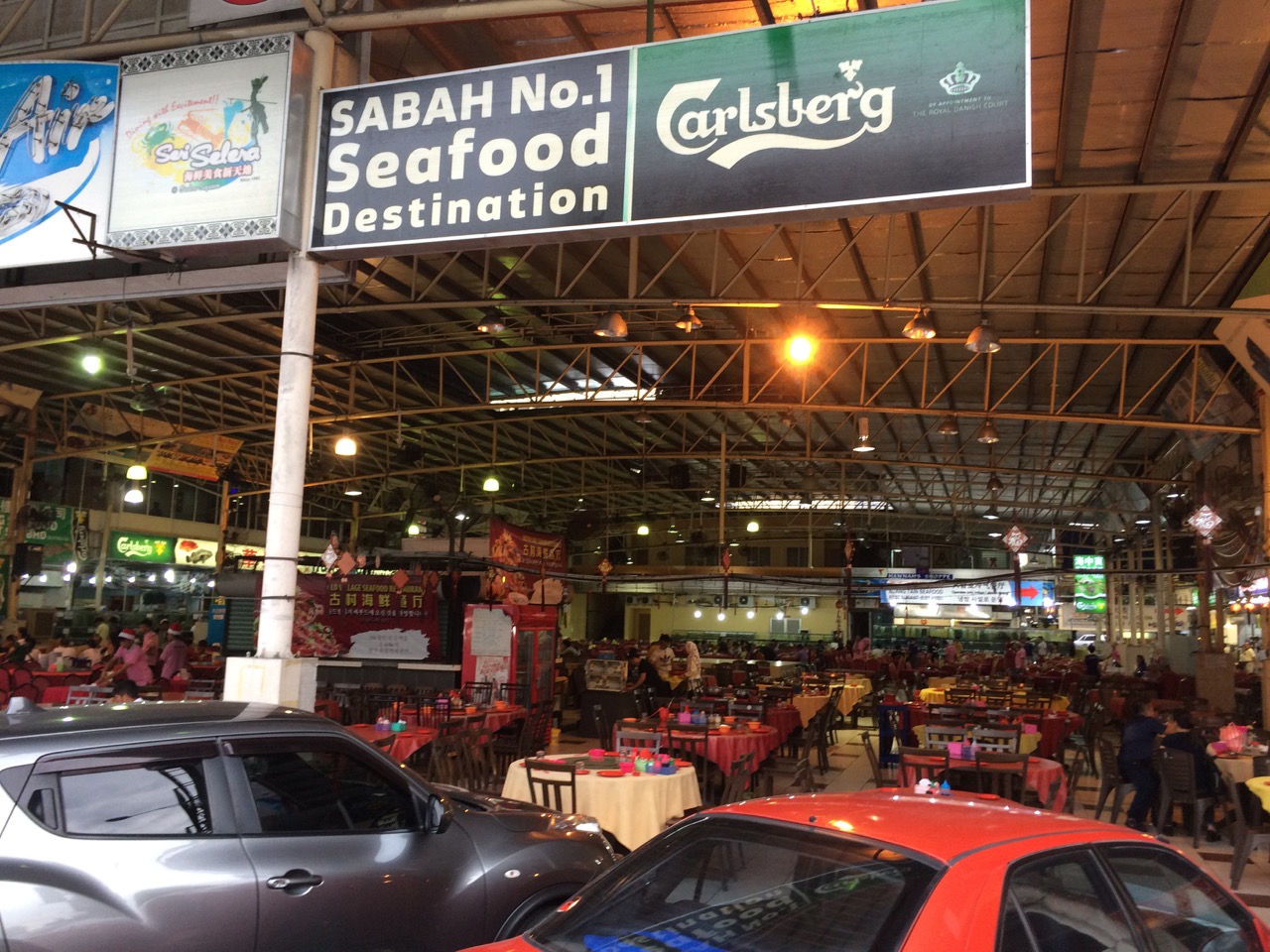
 In the middle of all the tables there is a stage. Now often on the stage they have bands and karaoke sessions, but I was delighted to see some traditional dance and yelping being performed.
In the middle of all the tables there is a stage. Now often on the stage they have bands and karaoke sessions, but I was delighted to see some traditional dance and yelping being performed.

 Later there was some flame throwing / fire eating stuff.
Later there was some flame throwing / fire eating stuff. It’s a neat efficient little system, but ours is very old and probably hasn’t worked for many years, possibly ten. So I stripped it down to try and find out why it wouldn’t start. As you can see from the pic’s it was quite a mess, closer inspection, with the assistance of many youtube videos, revealed that the internal air intake fan was seized, also the cabling for one of the temperature sensors has shed it’s insulation and was shorted. Also the exhaust was blocked with decomposing exhaust outlet pipe. The gaskets on the main heater chamber had perished, I was able to replace these with ones I cut out from some gasket material I brought out.
It’s a neat efficient little system, but ours is very old and probably hasn’t worked for many years, possibly ten. So I stripped it down to try and find out why it wouldn’t start. As you can see from the pic’s it was quite a mess, closer inspection, with the assistance of many youtube videos, revealed that the internal air intake fan was seized, also the cabling for one of the temperature sensors has shed it’s insulation and was shorted. Also the exhaust was blocked with decomposing exhaust outlet pipe. The gaskets on the main heater chamber had perished, I was able to replace these with ones I cut out from some gasket material I brought out. 